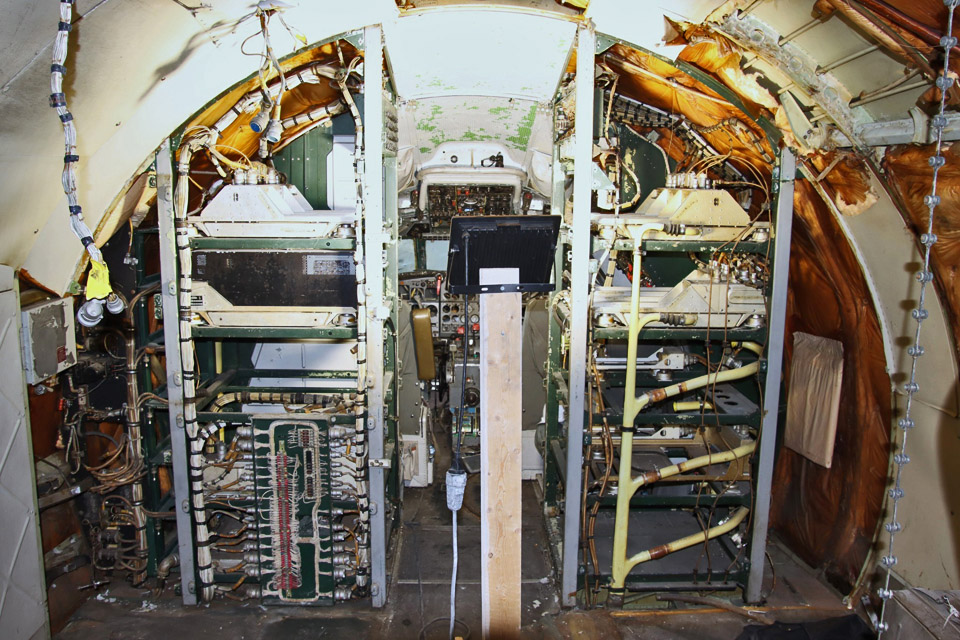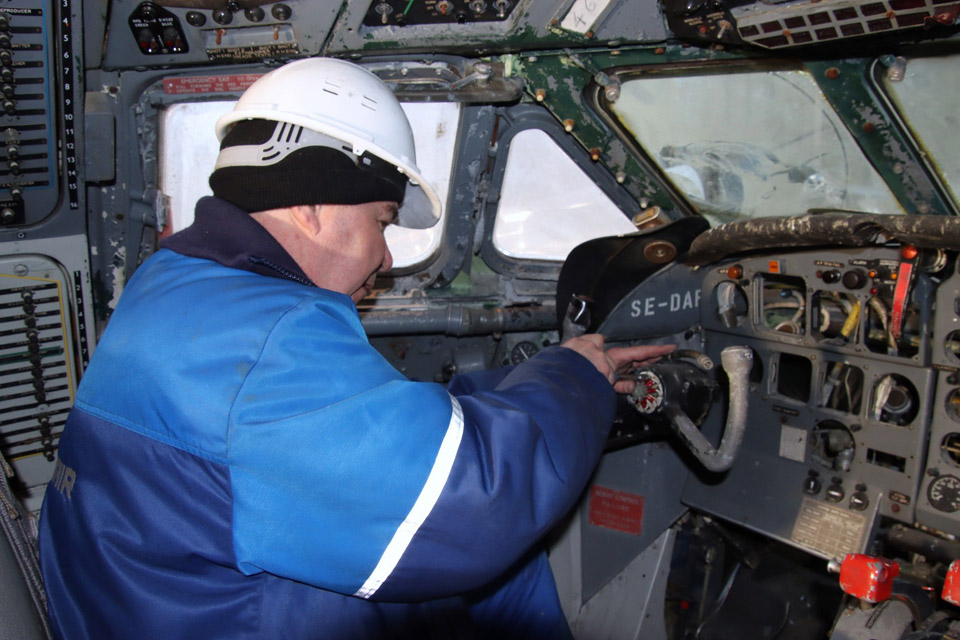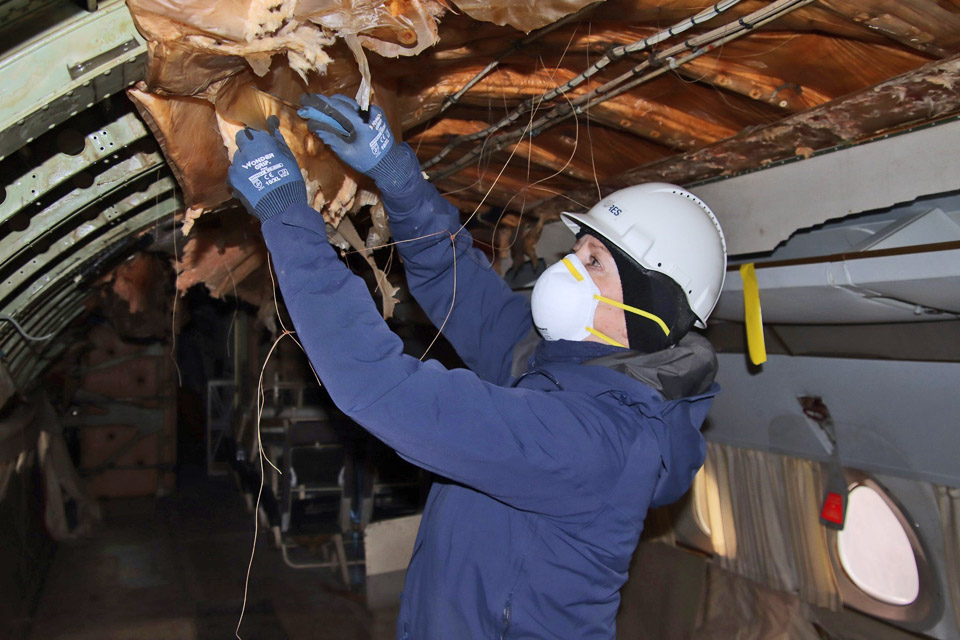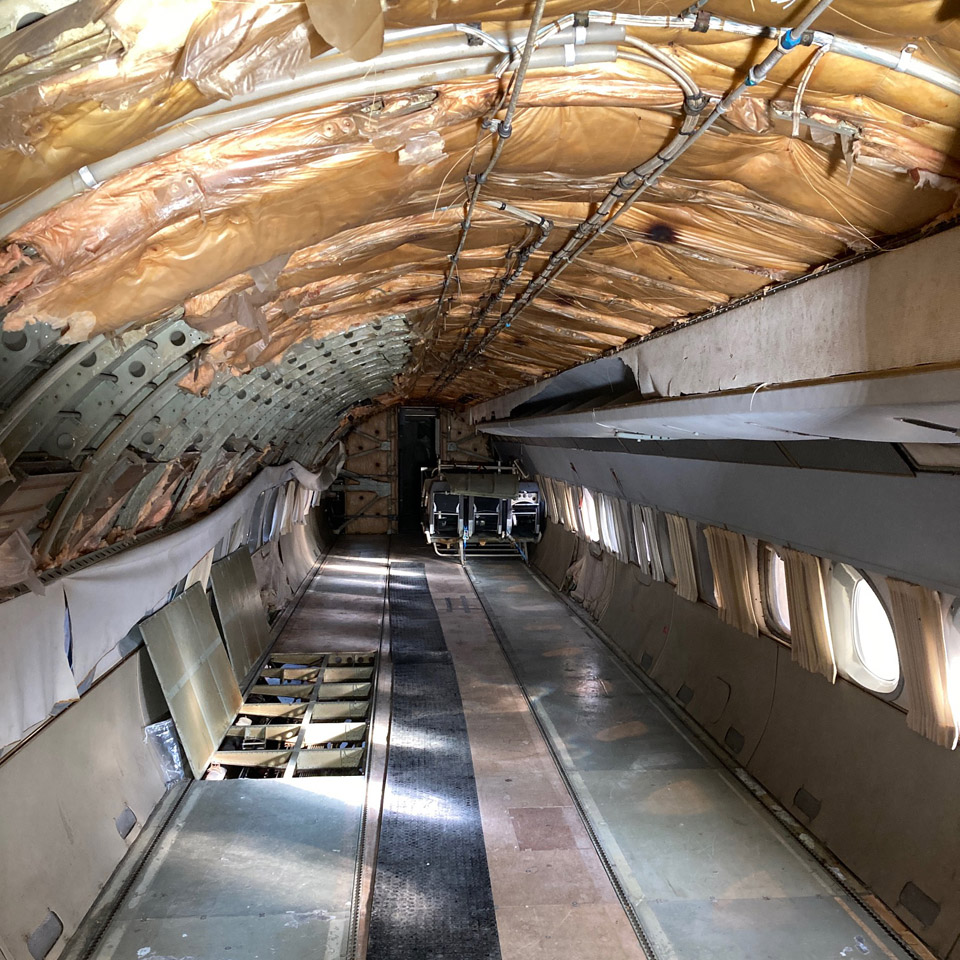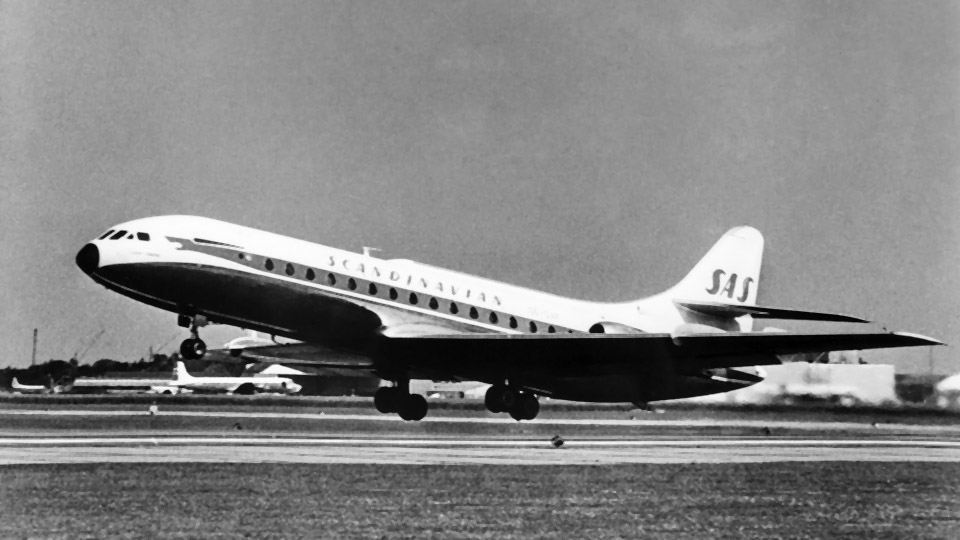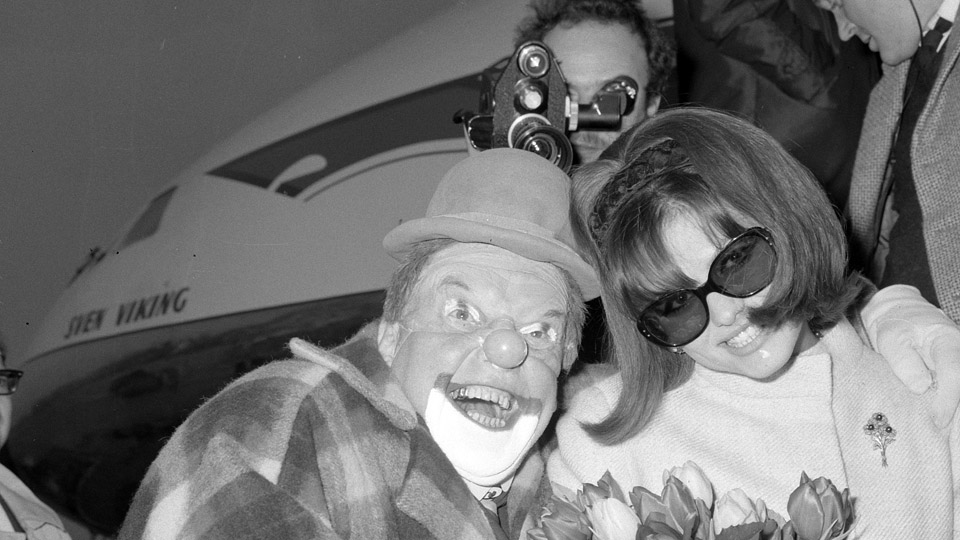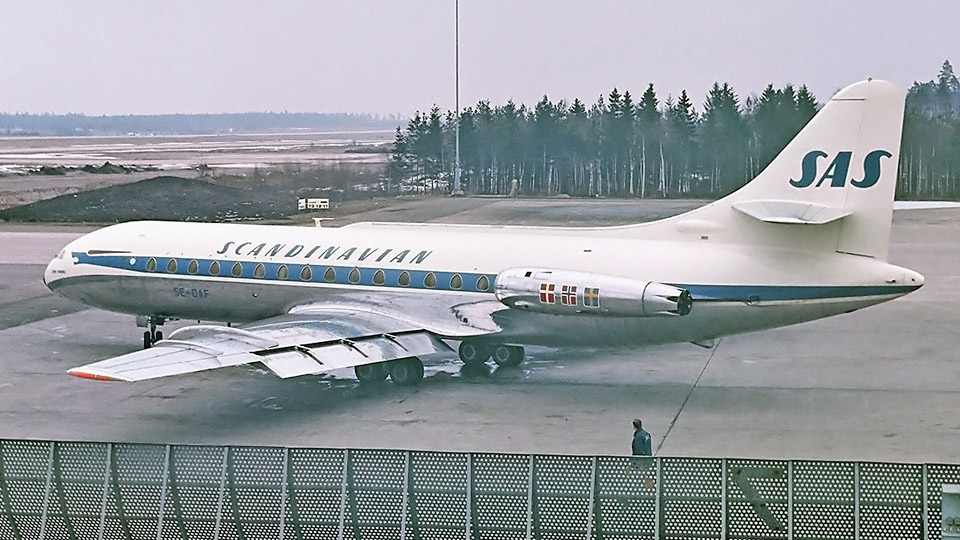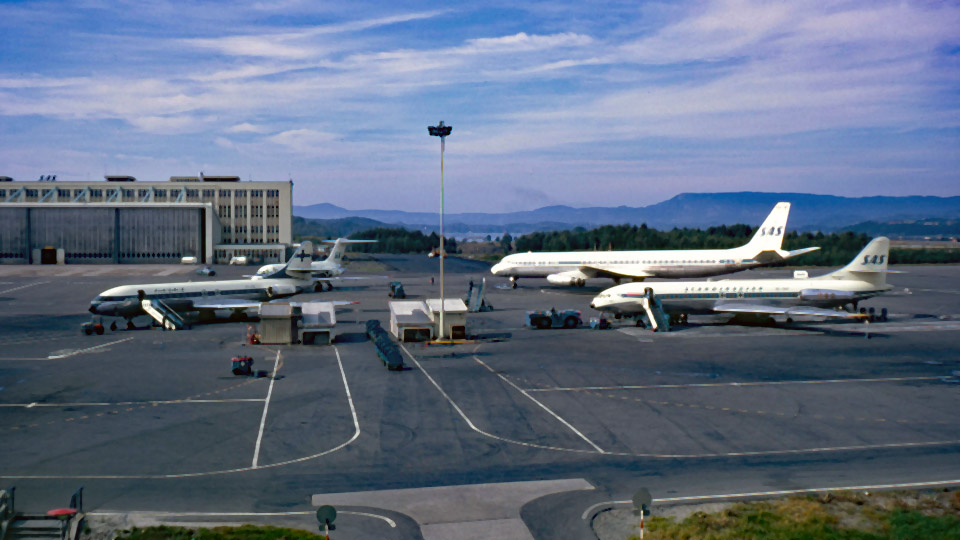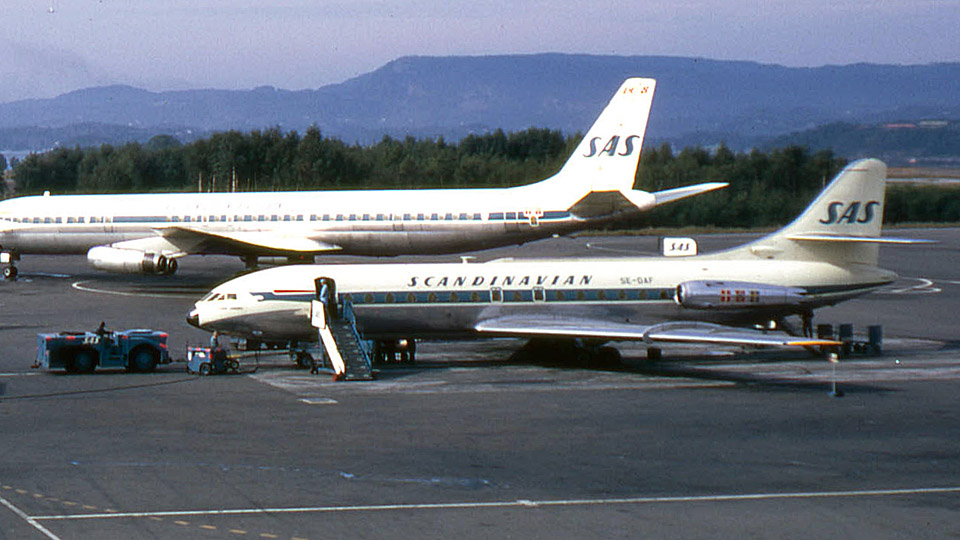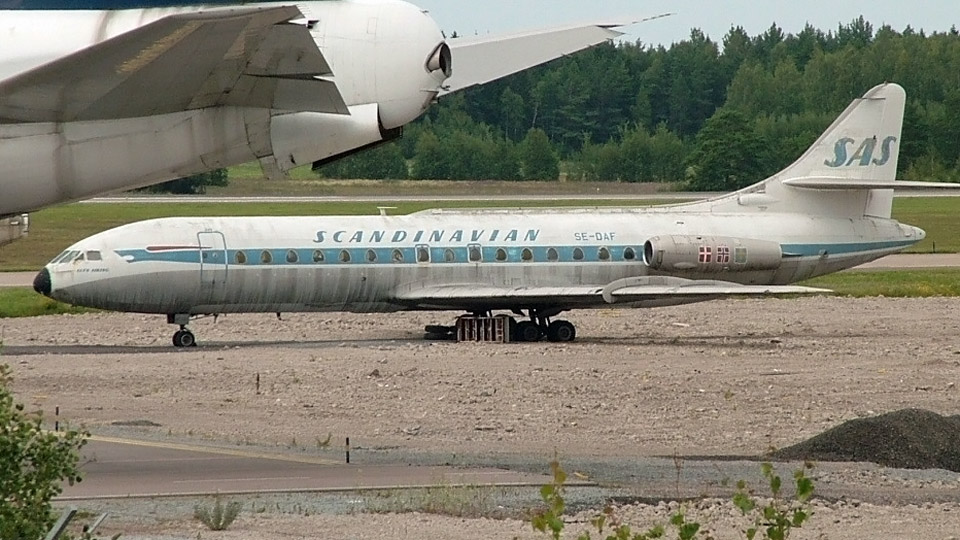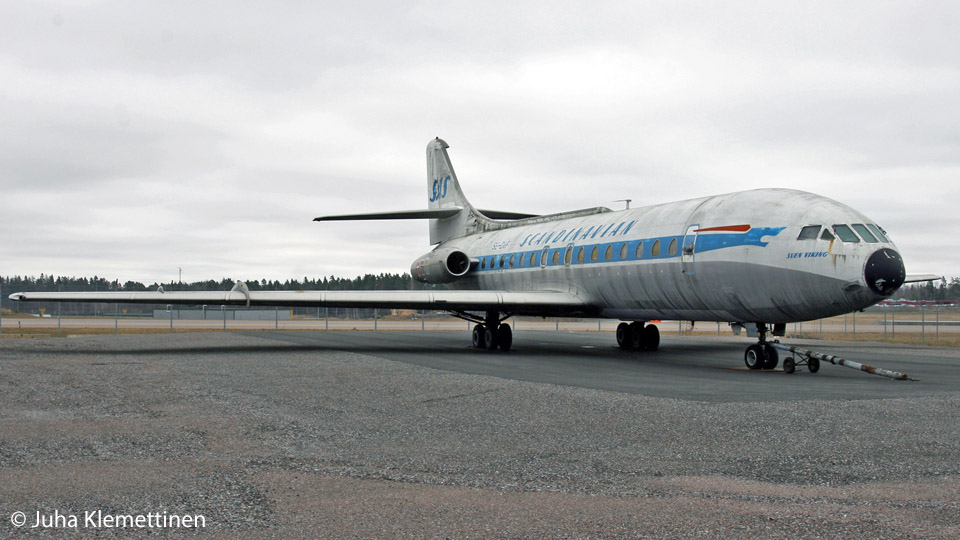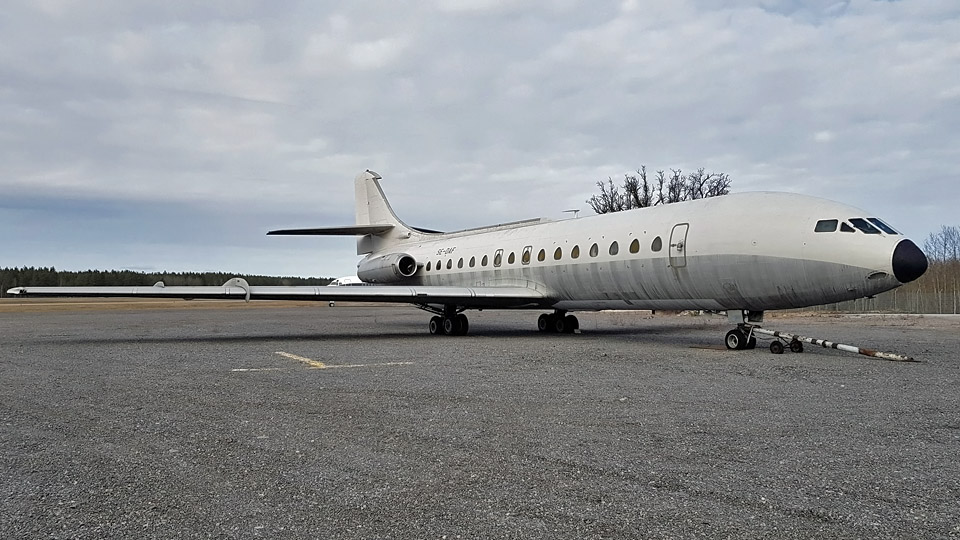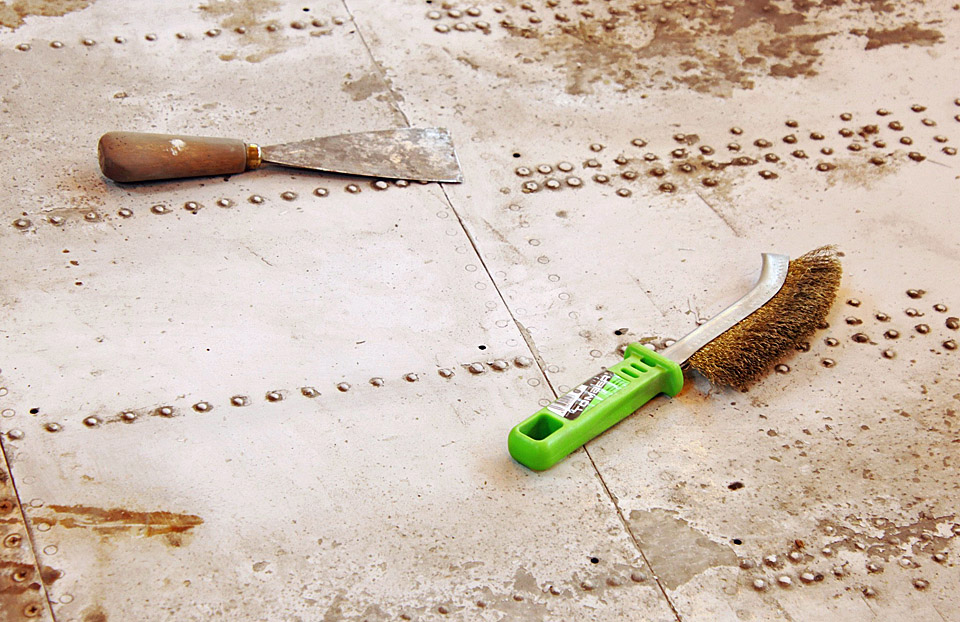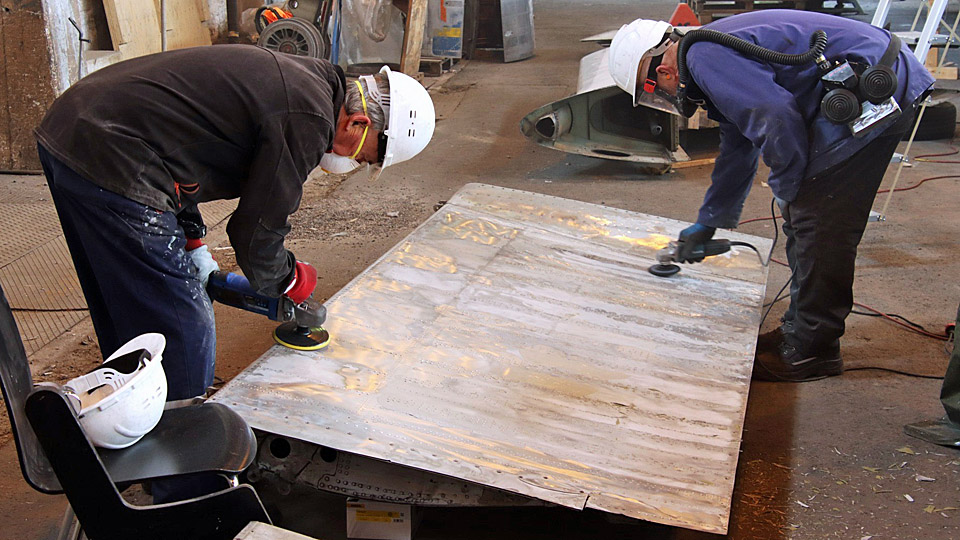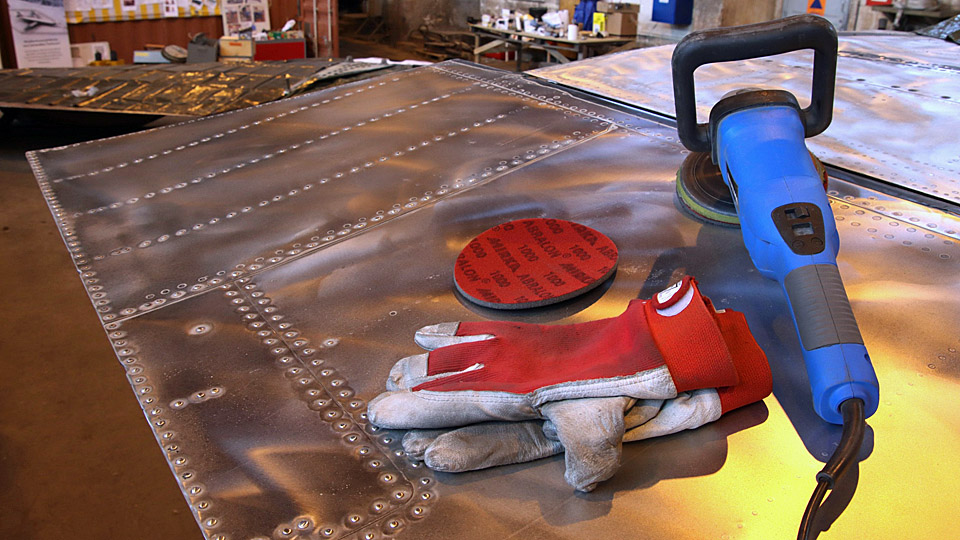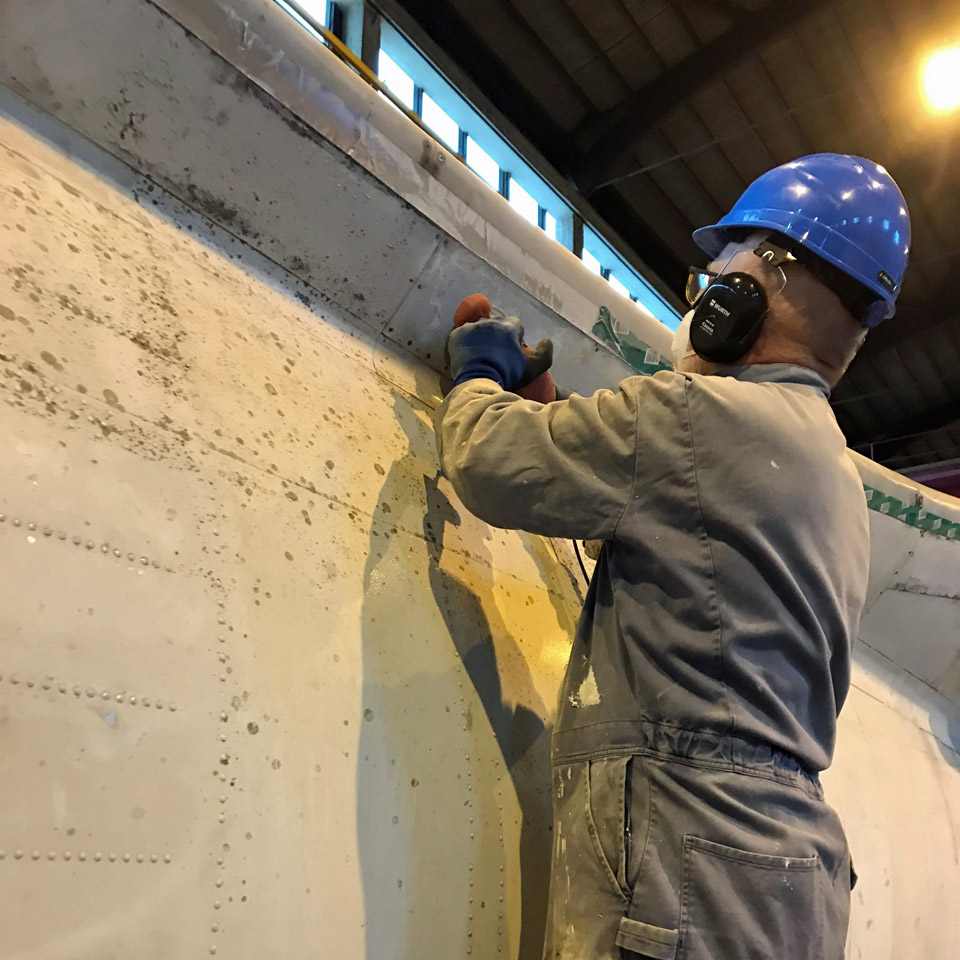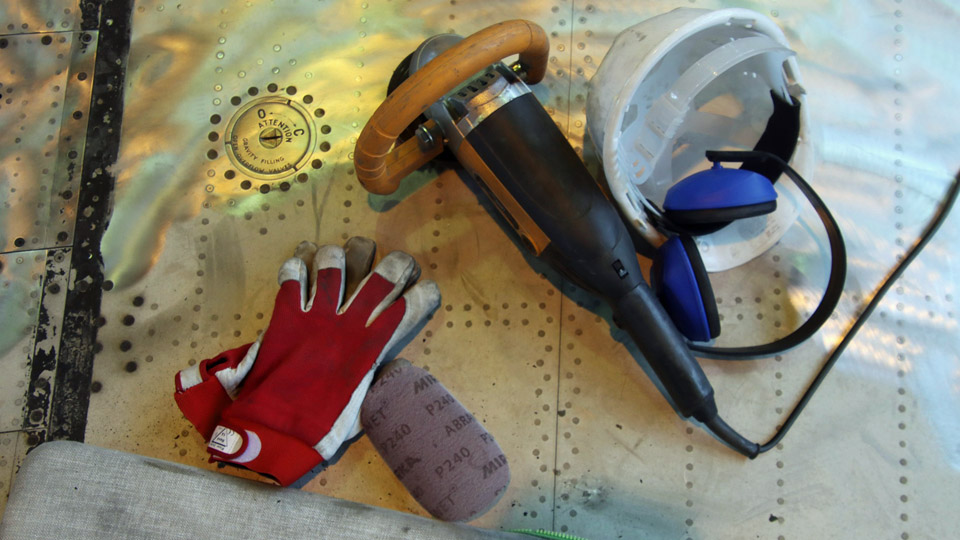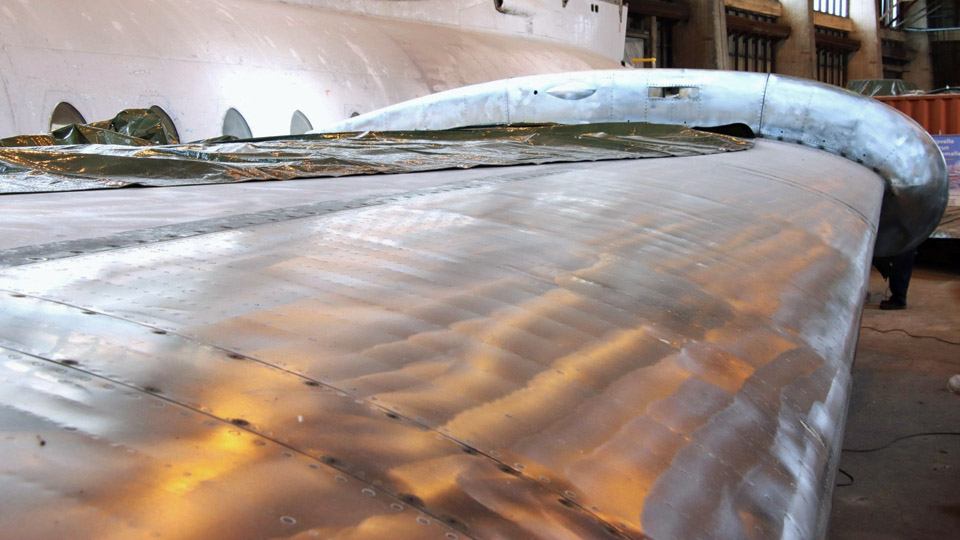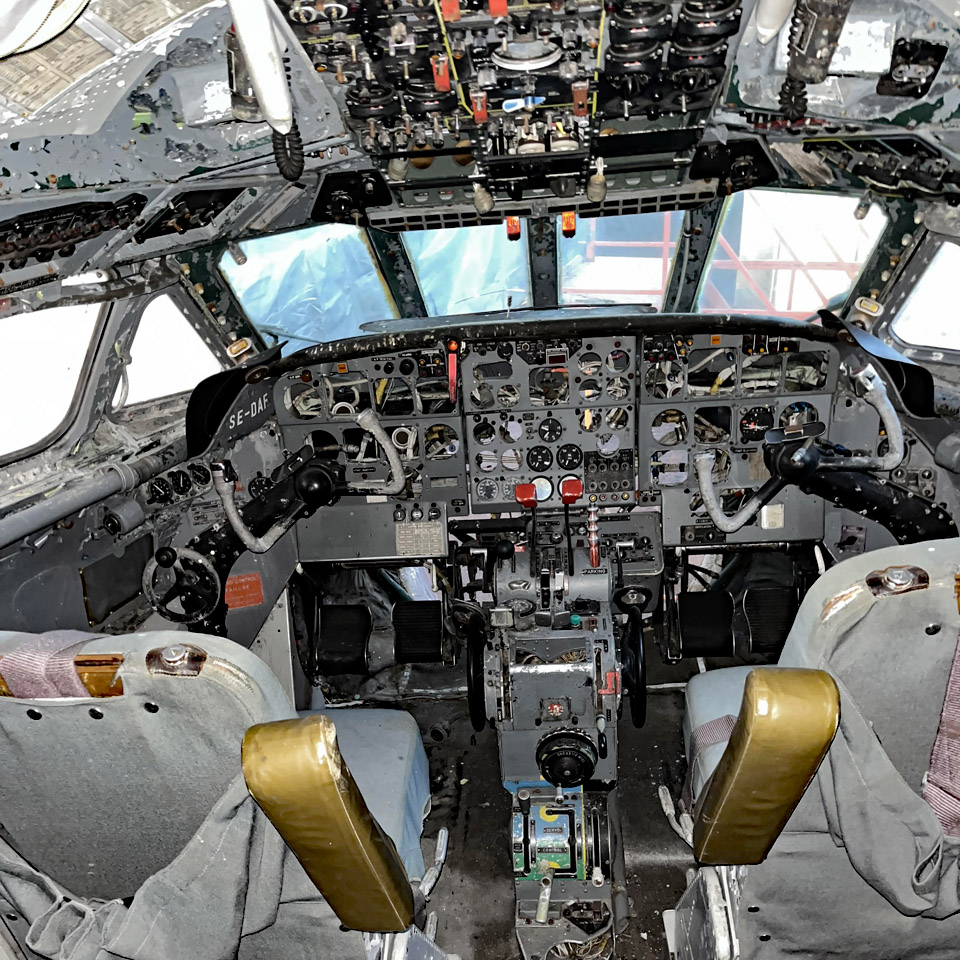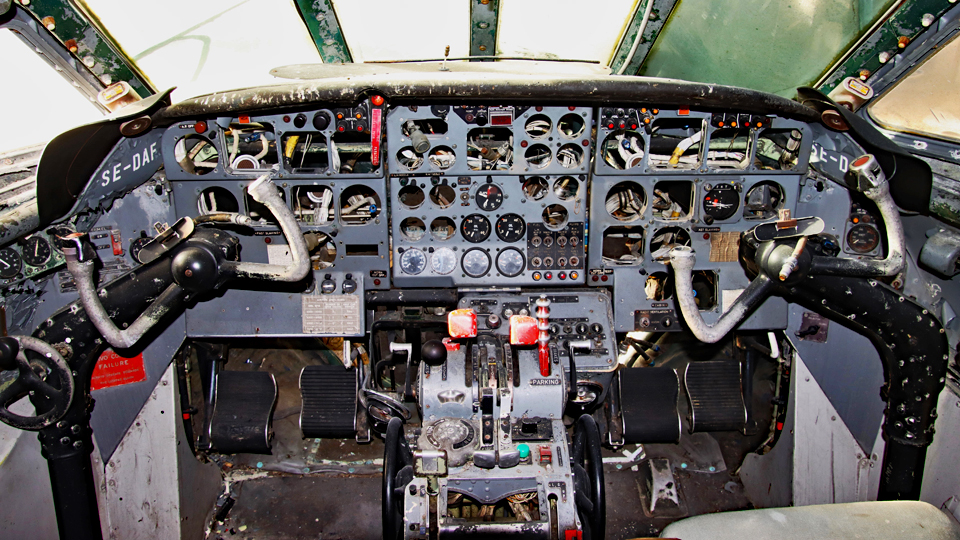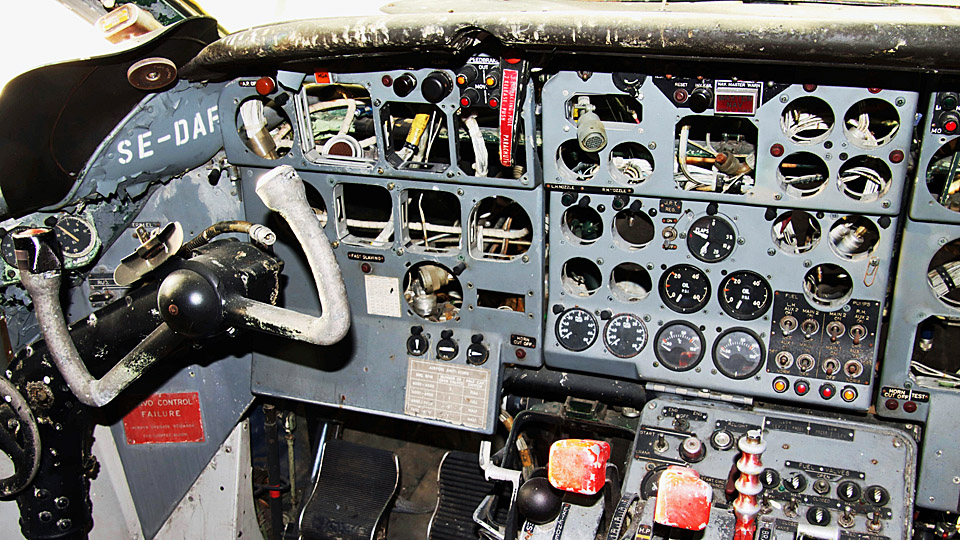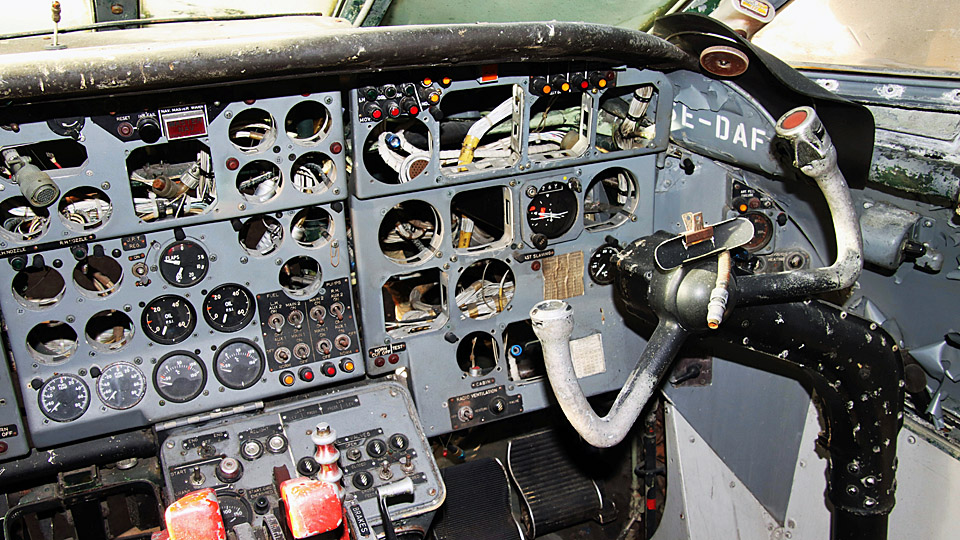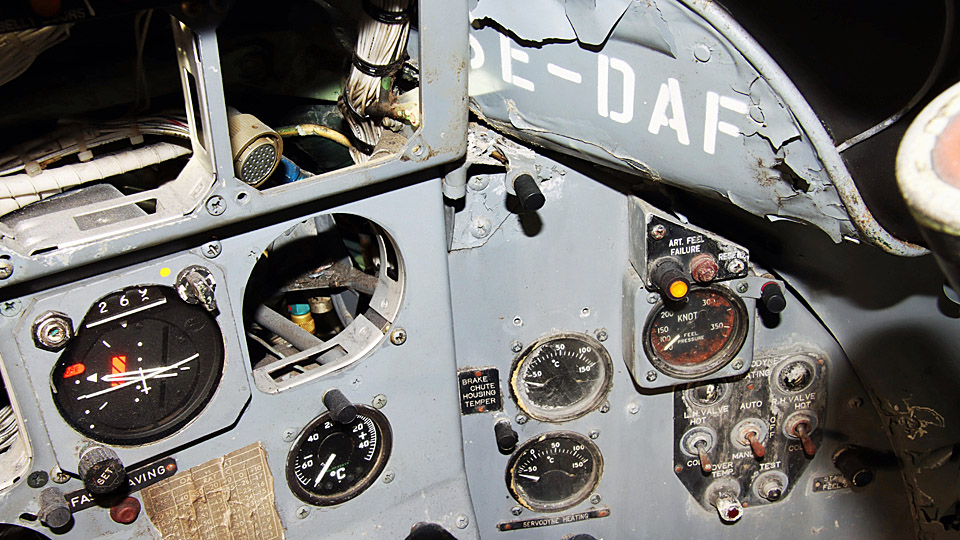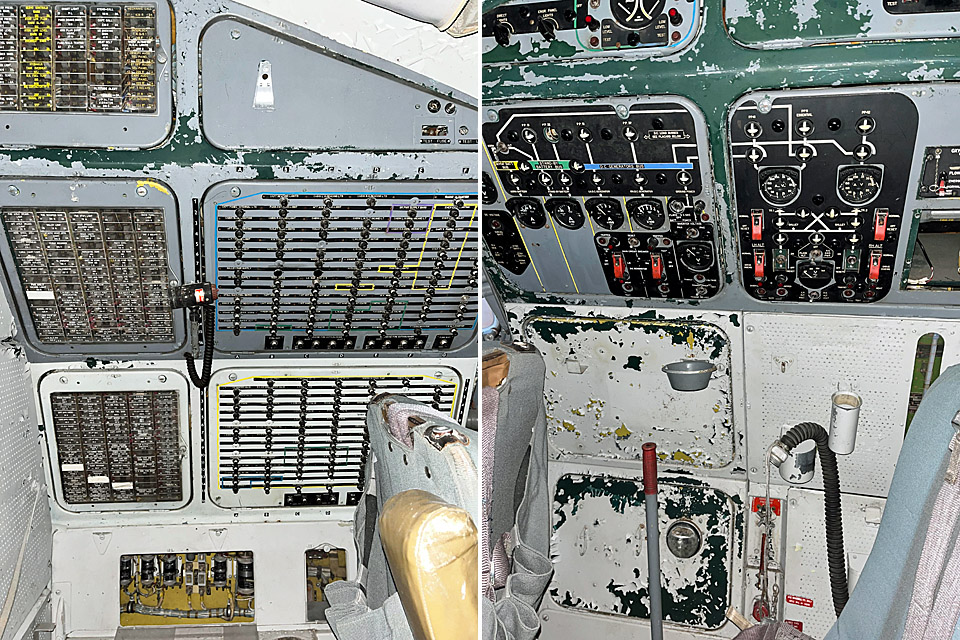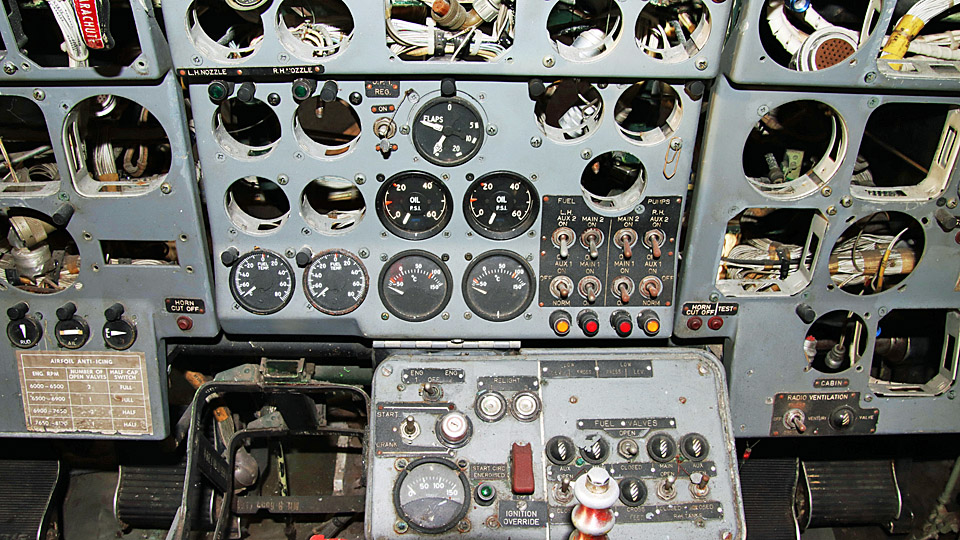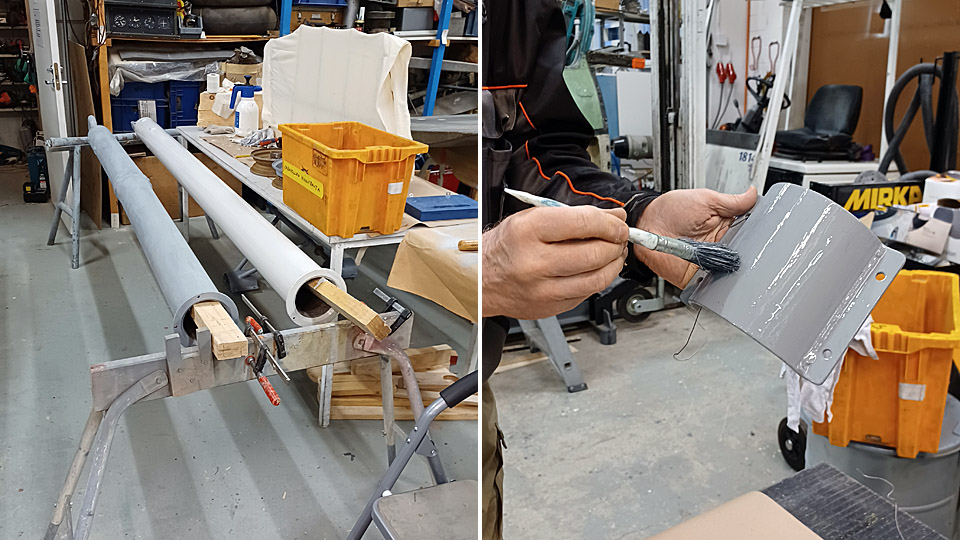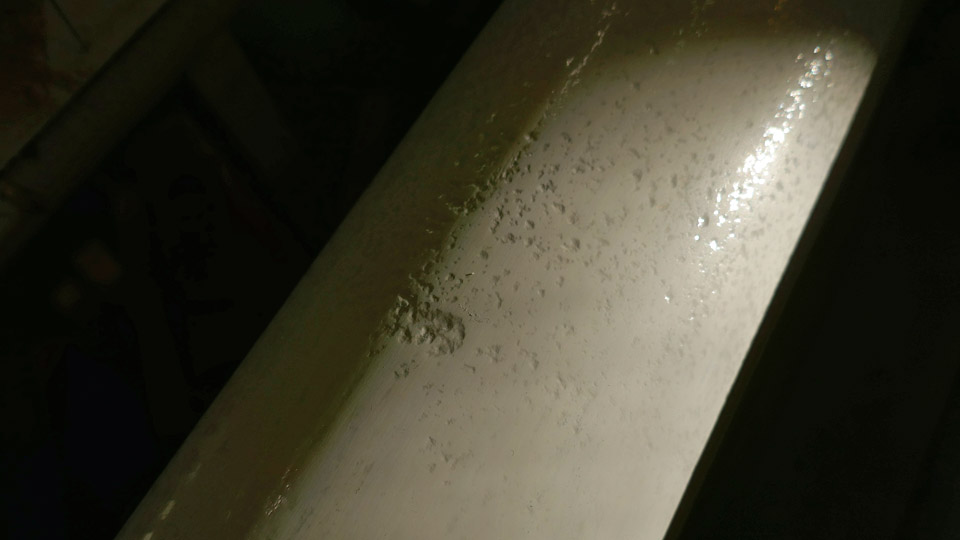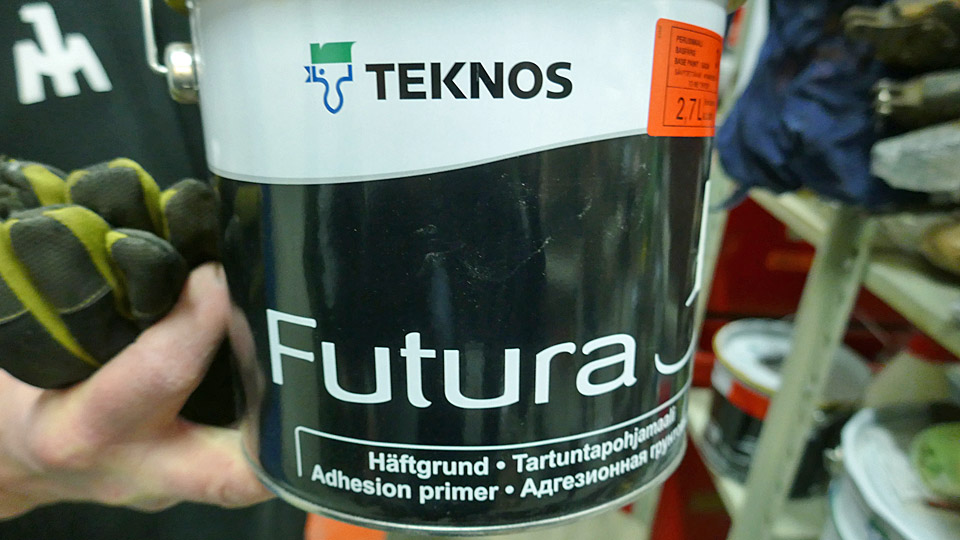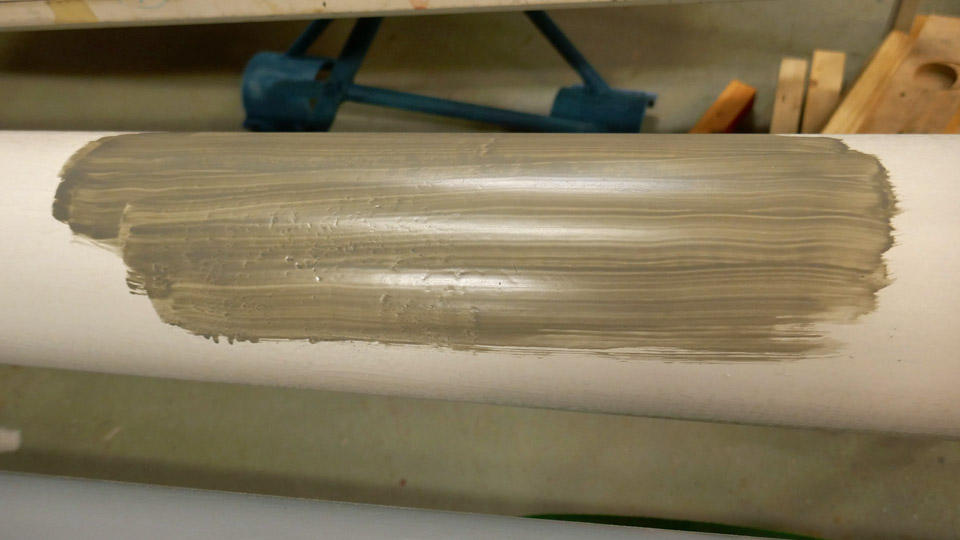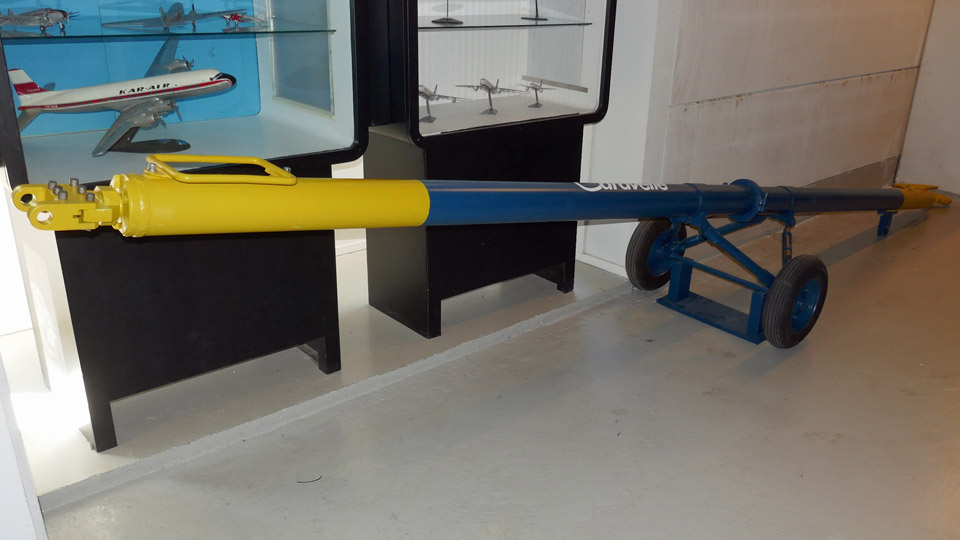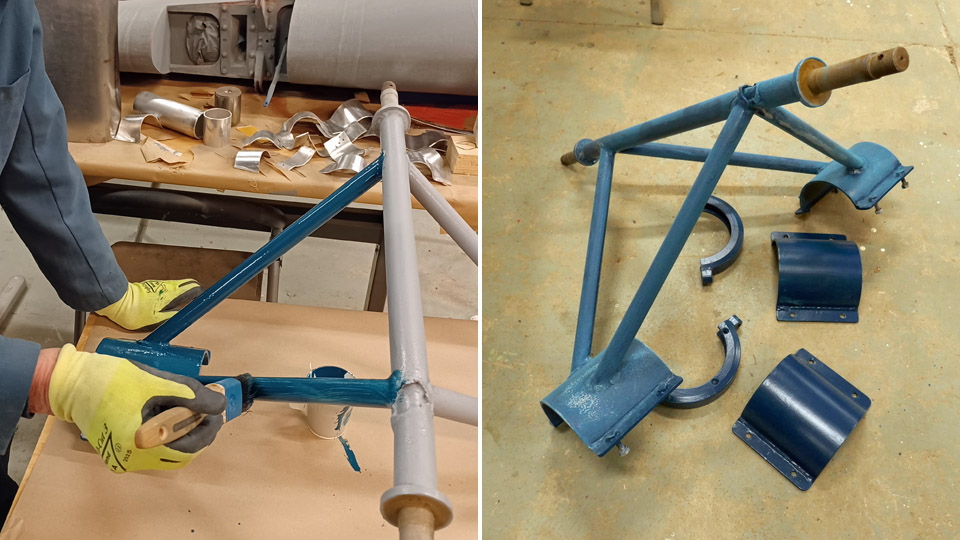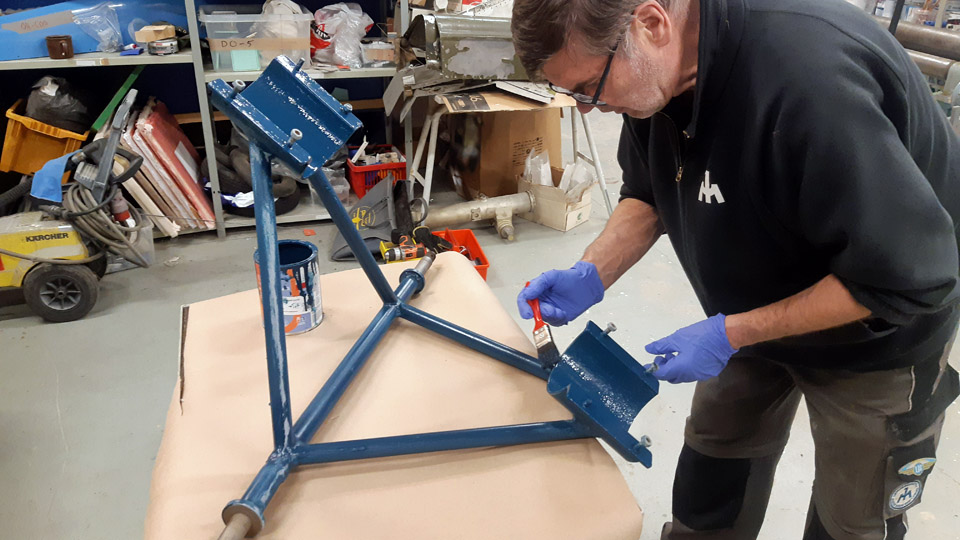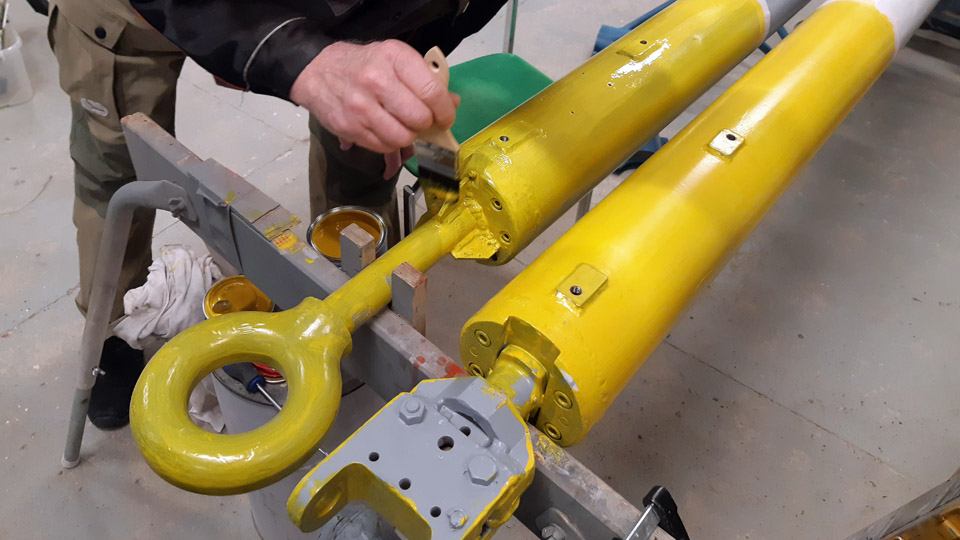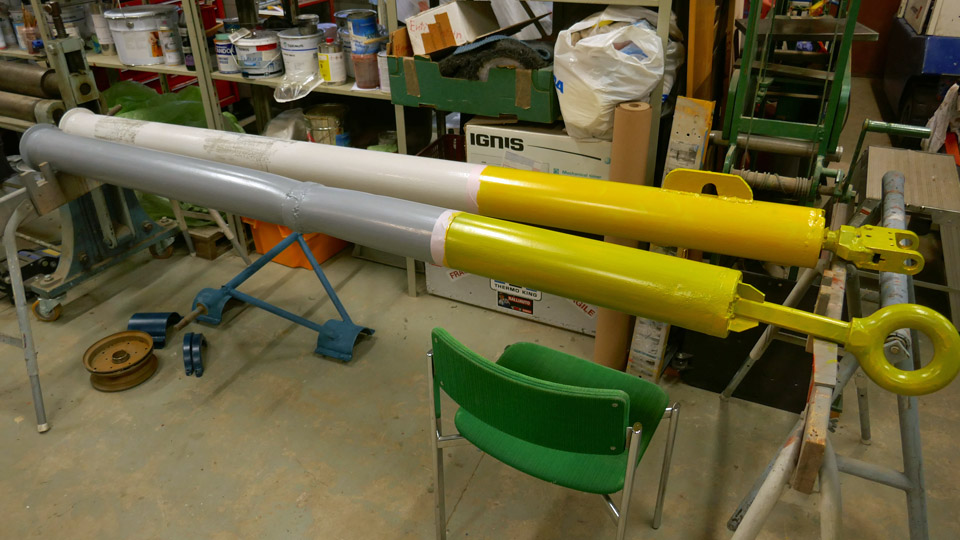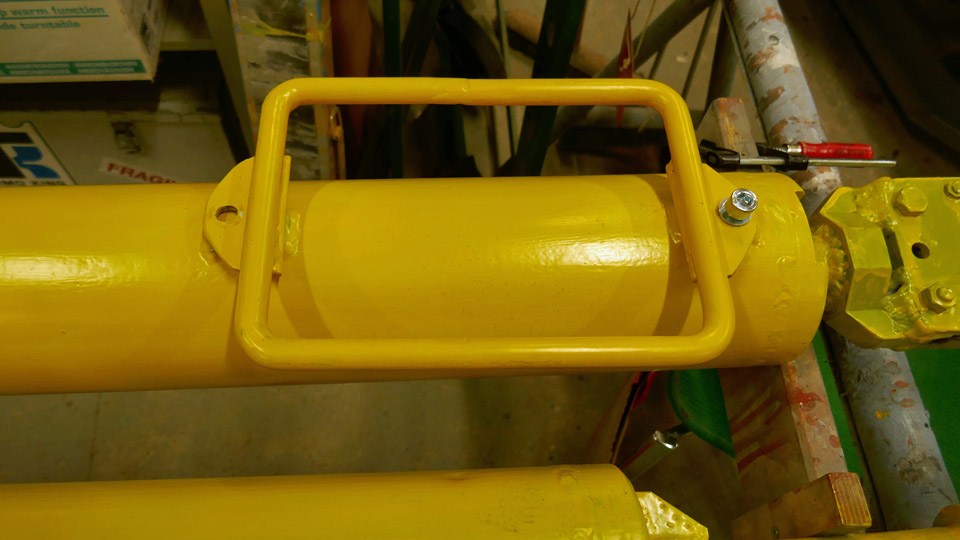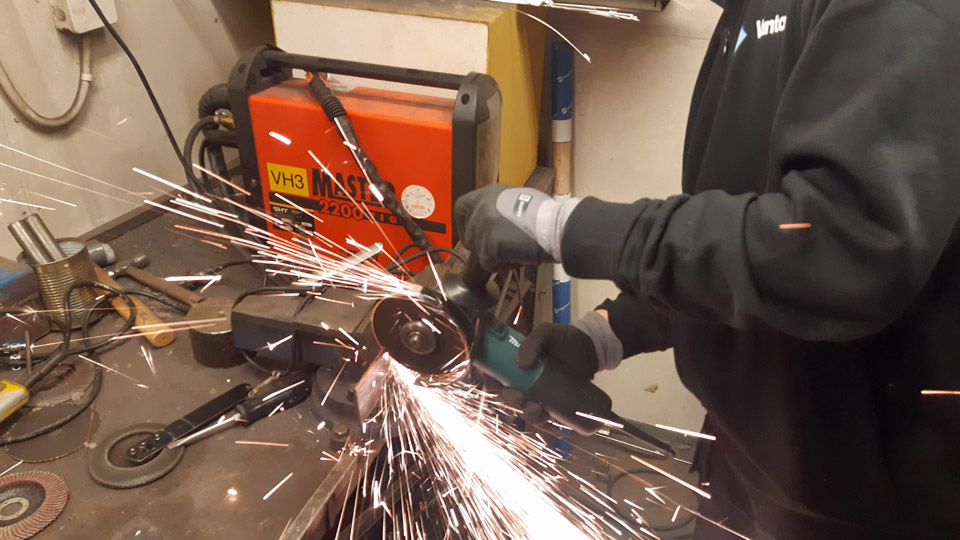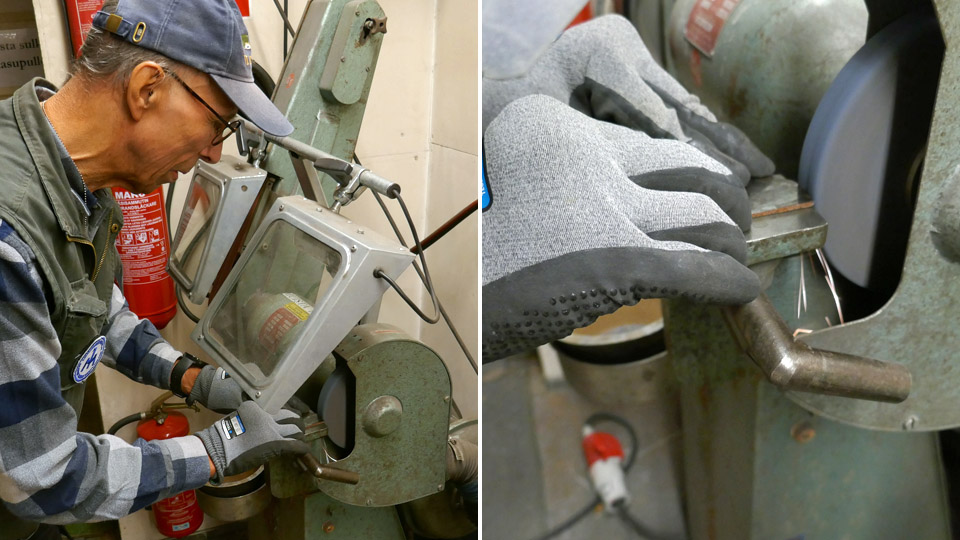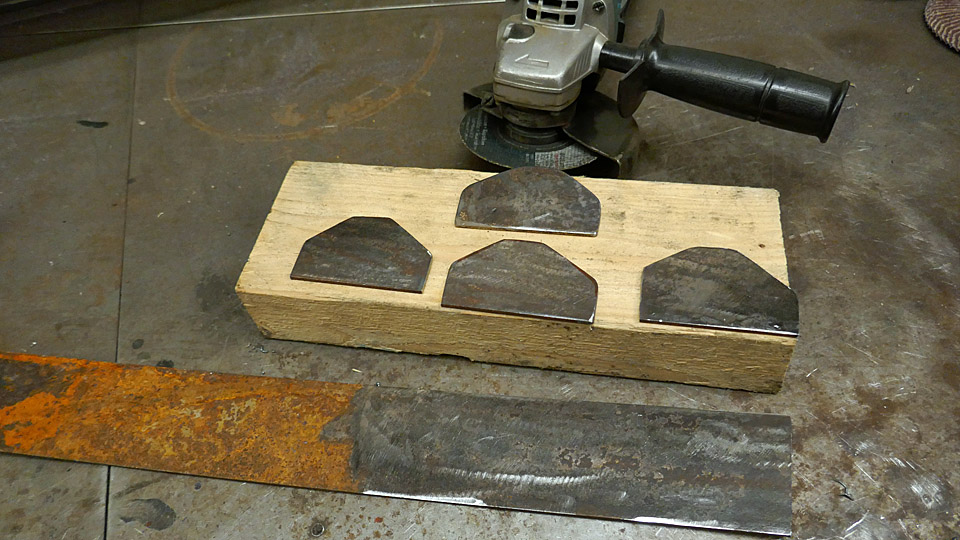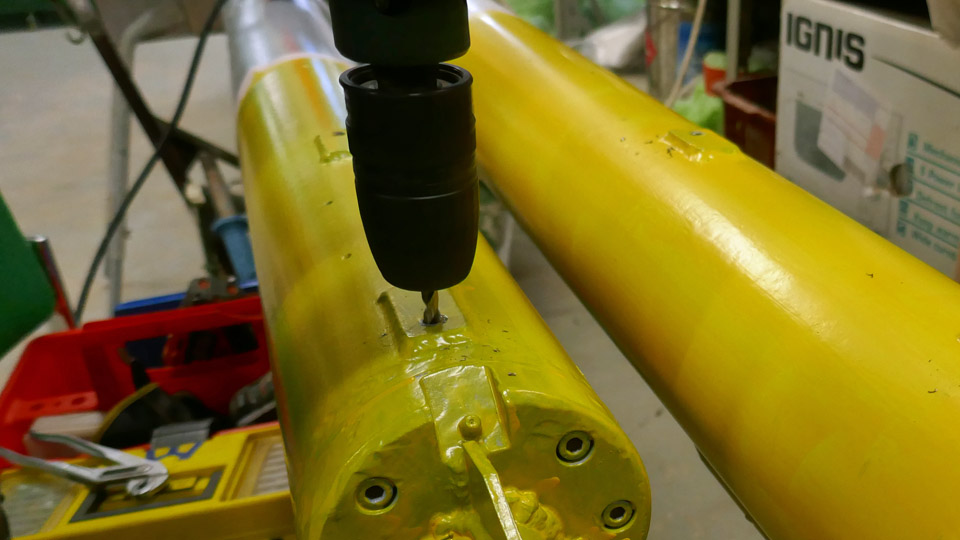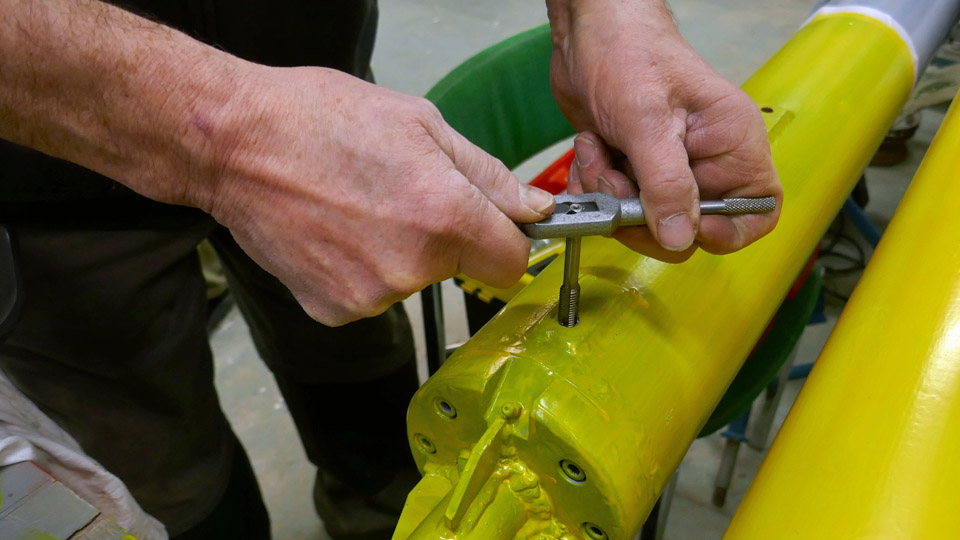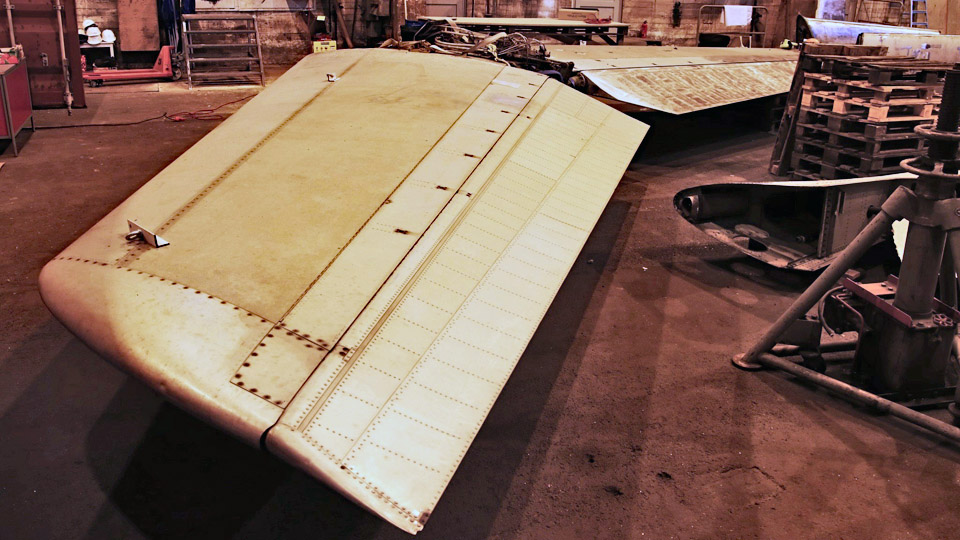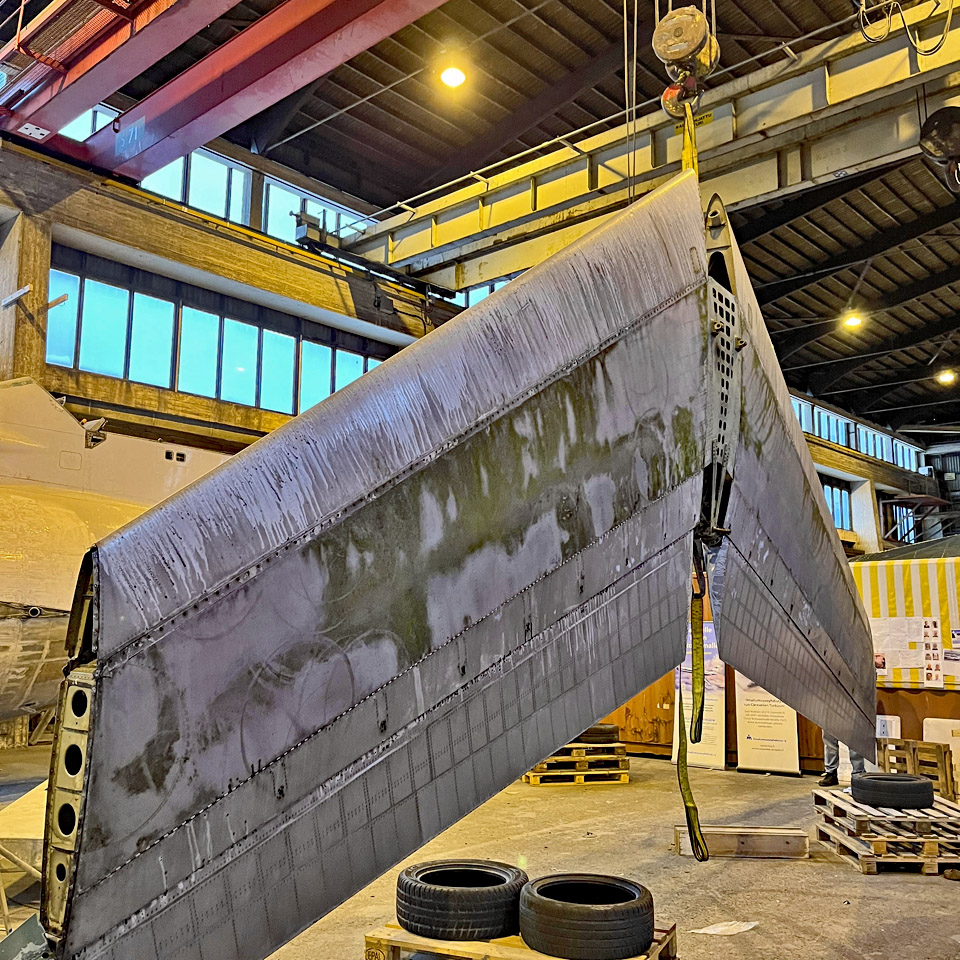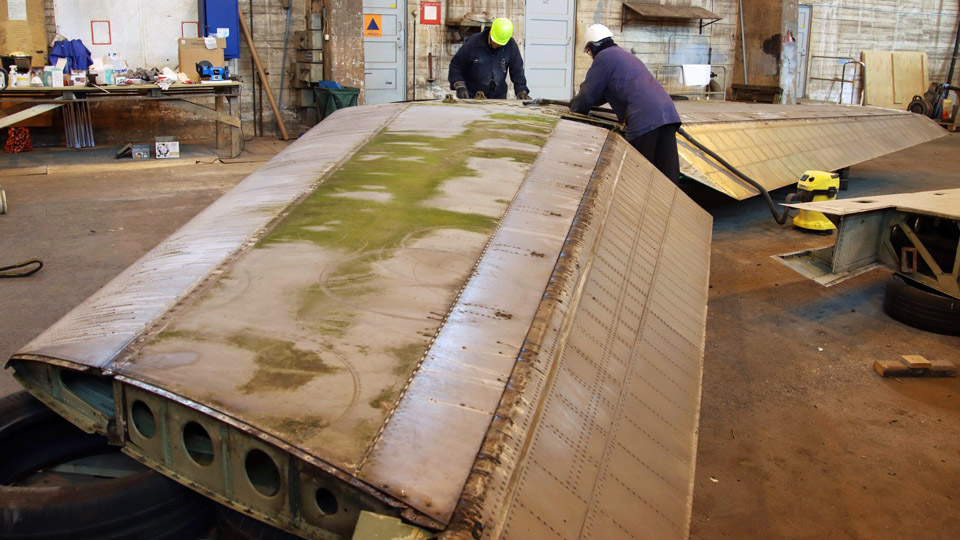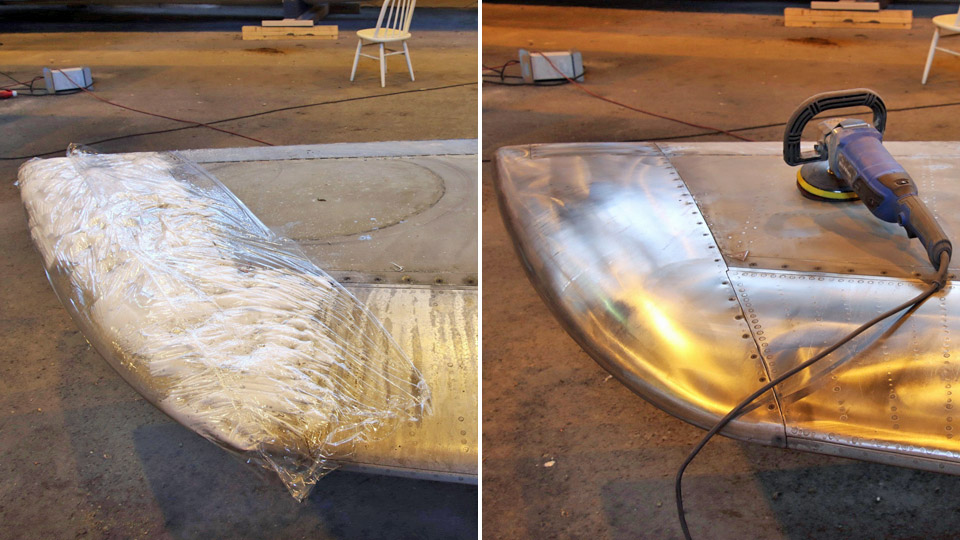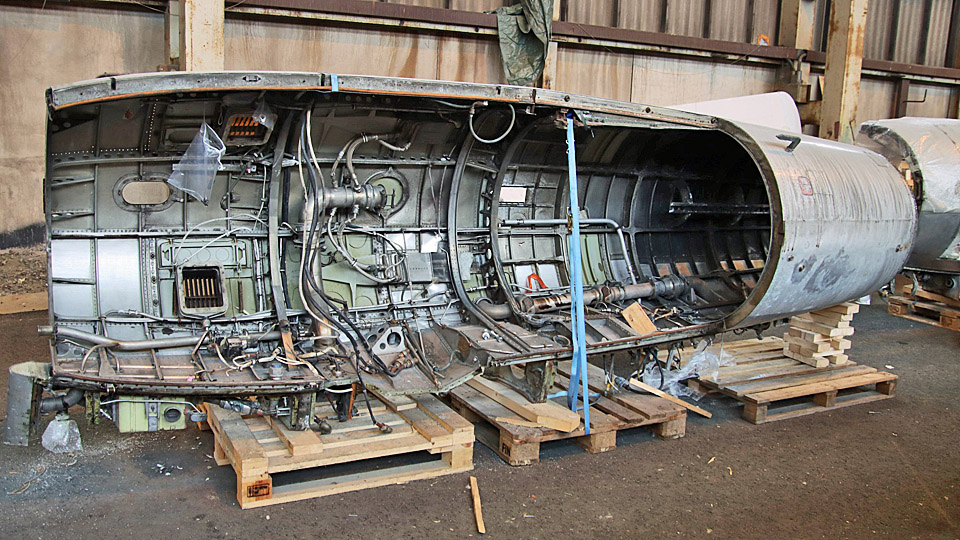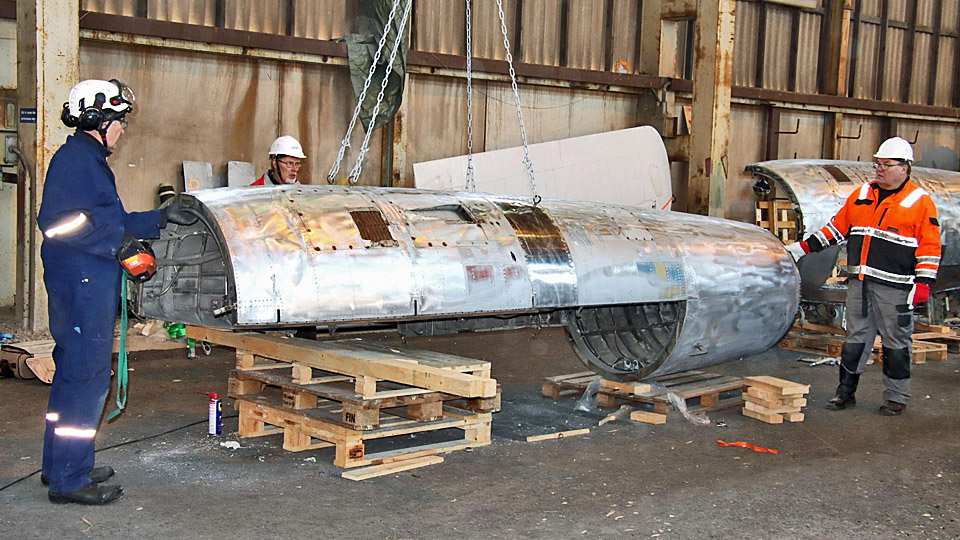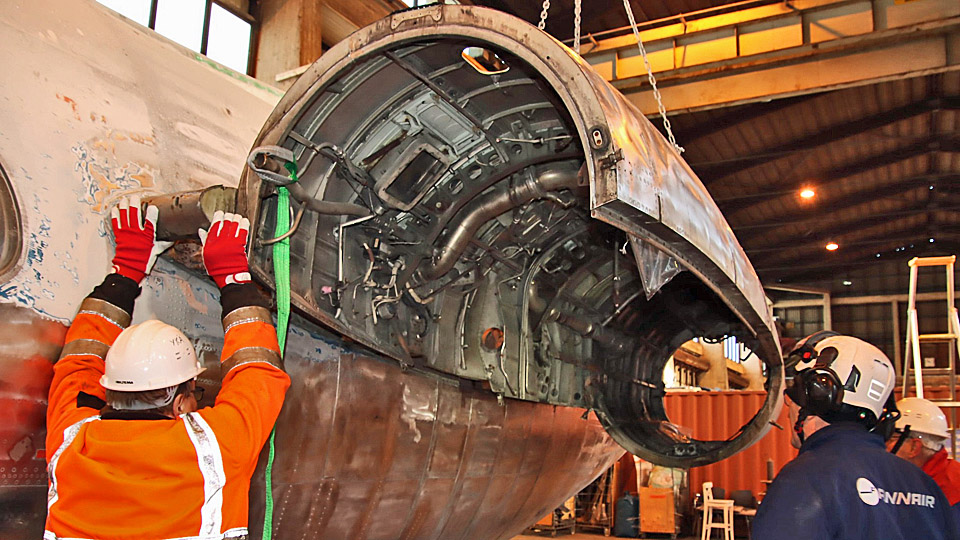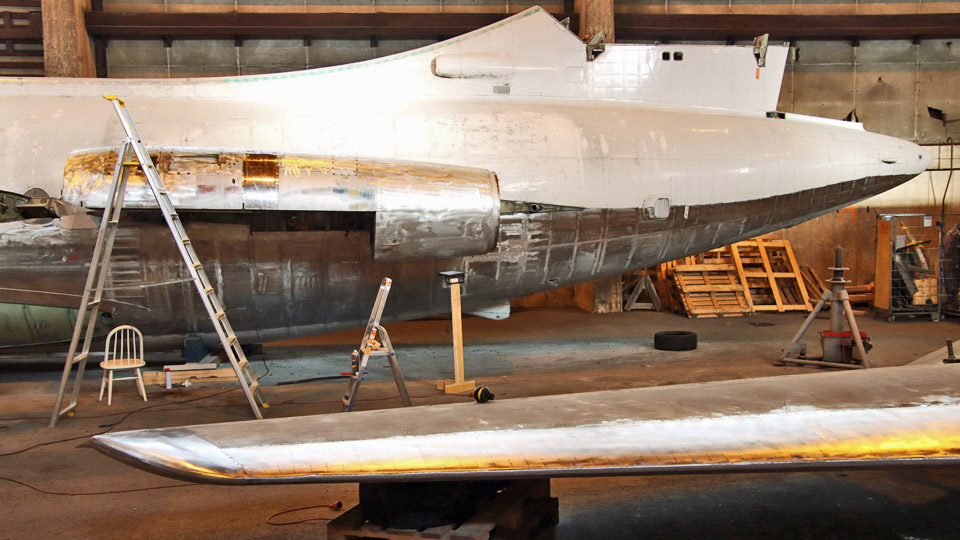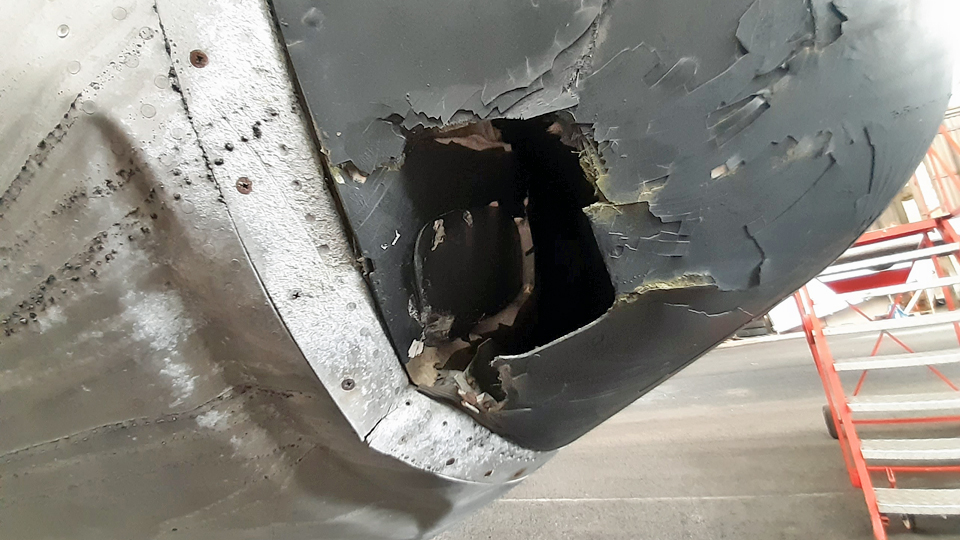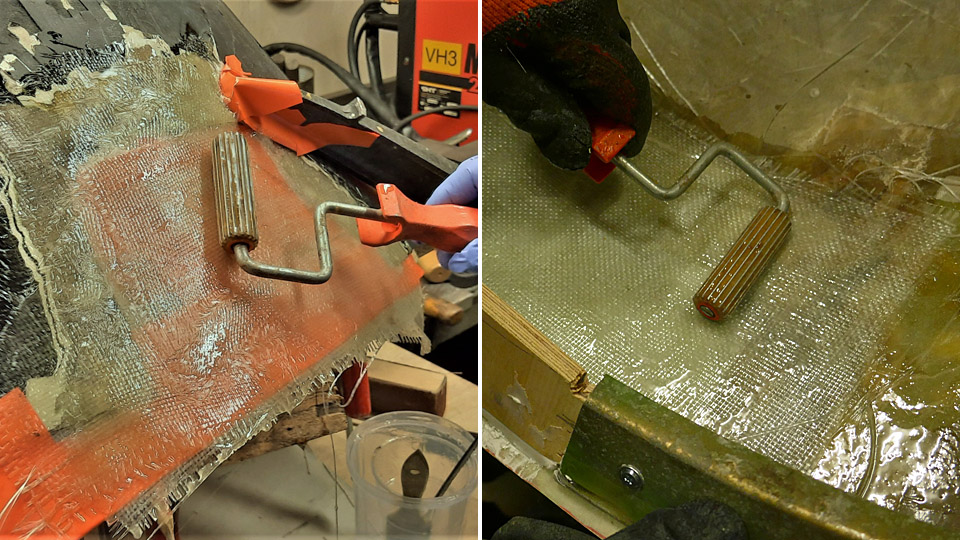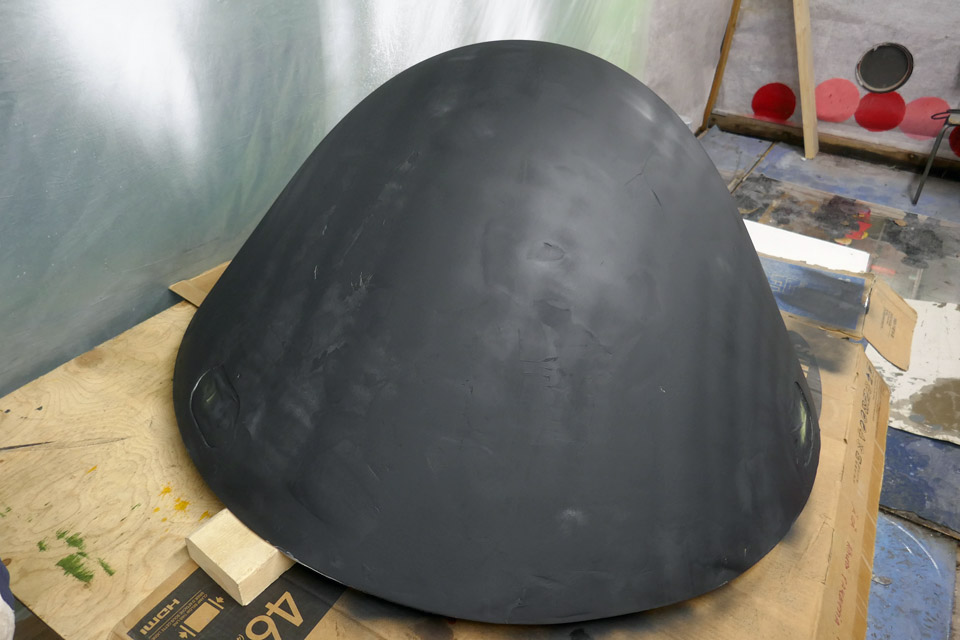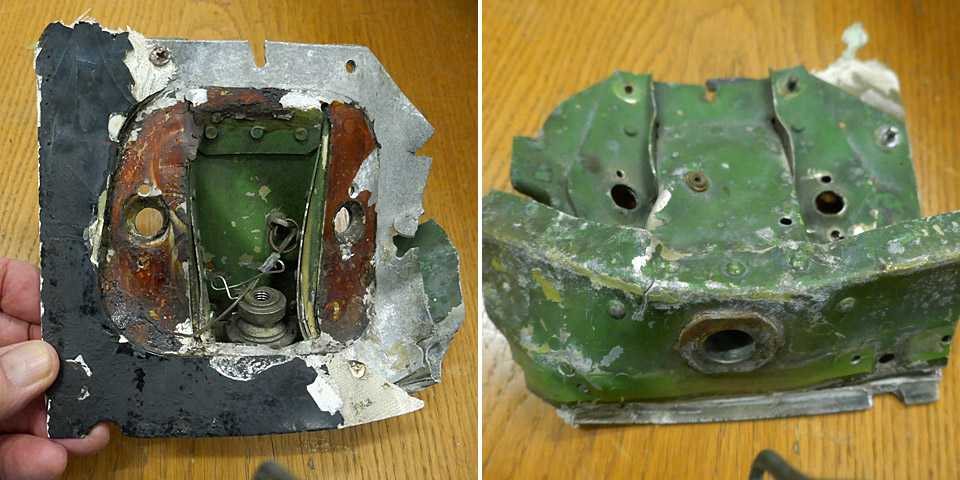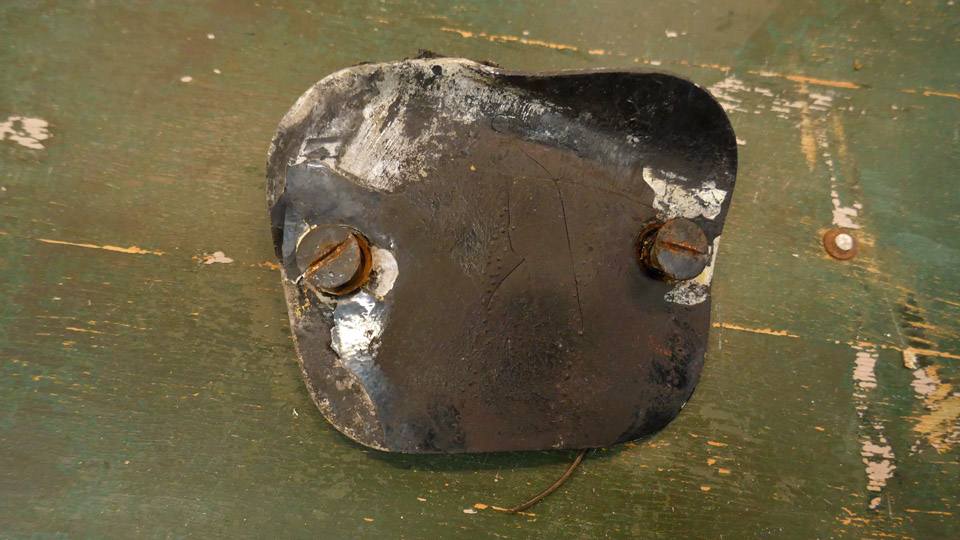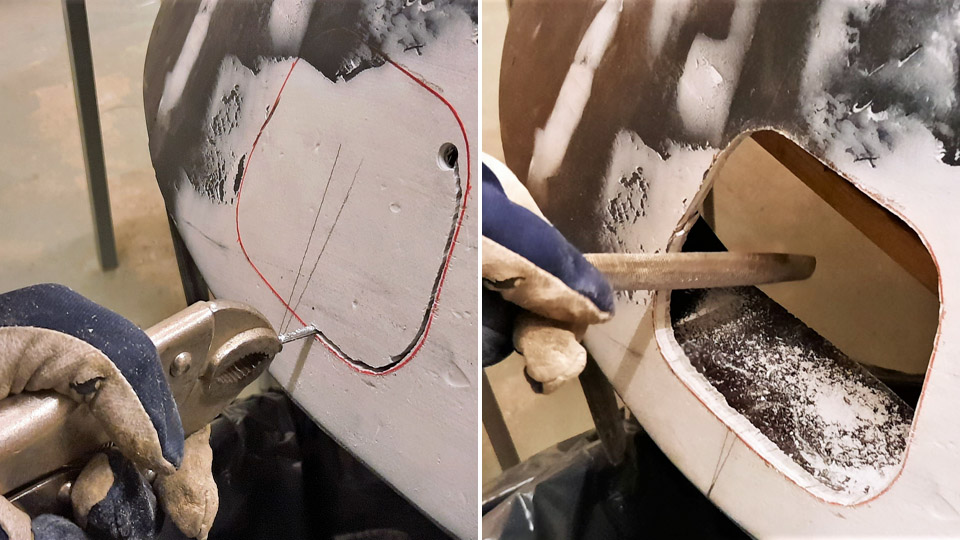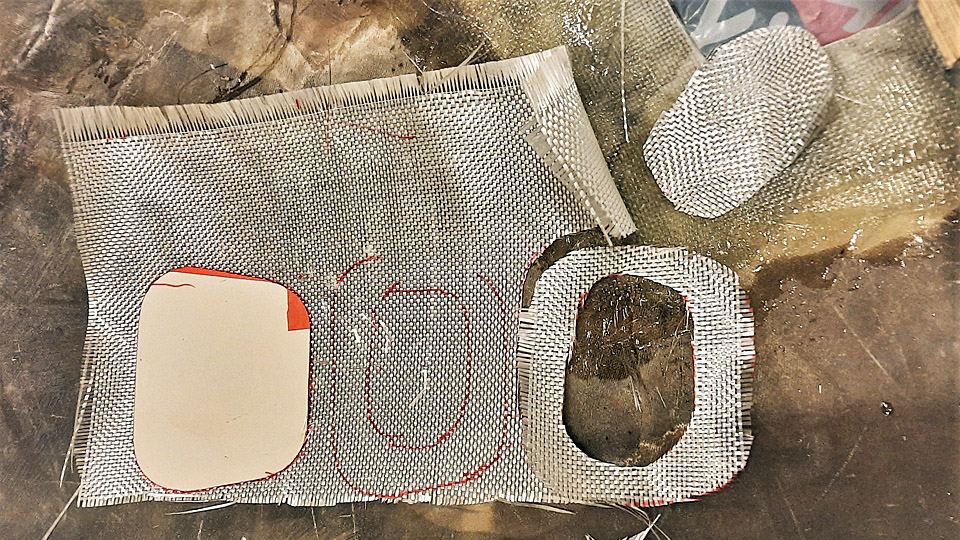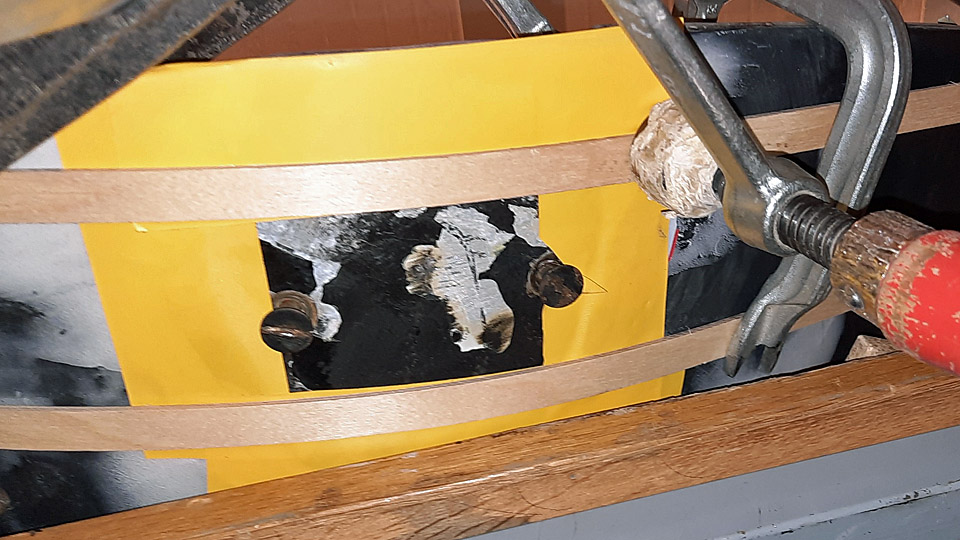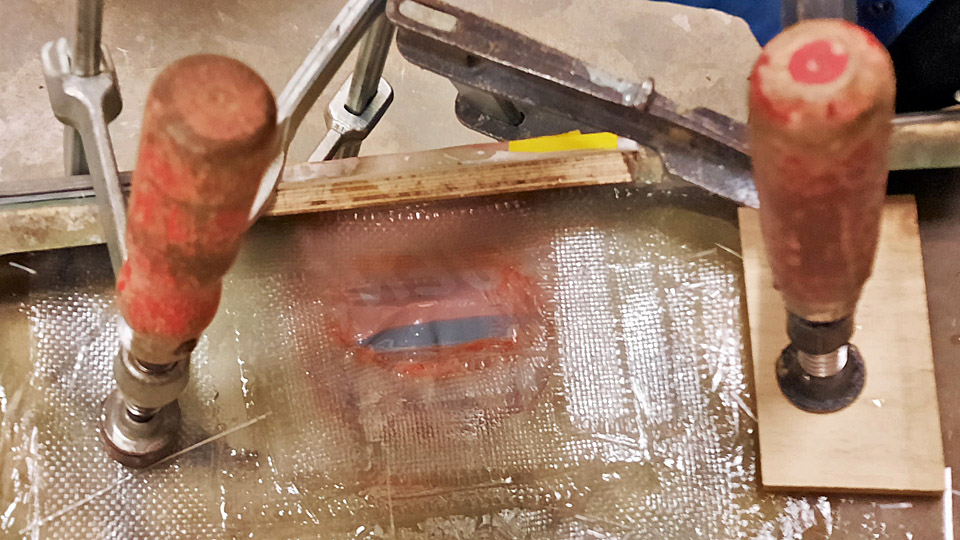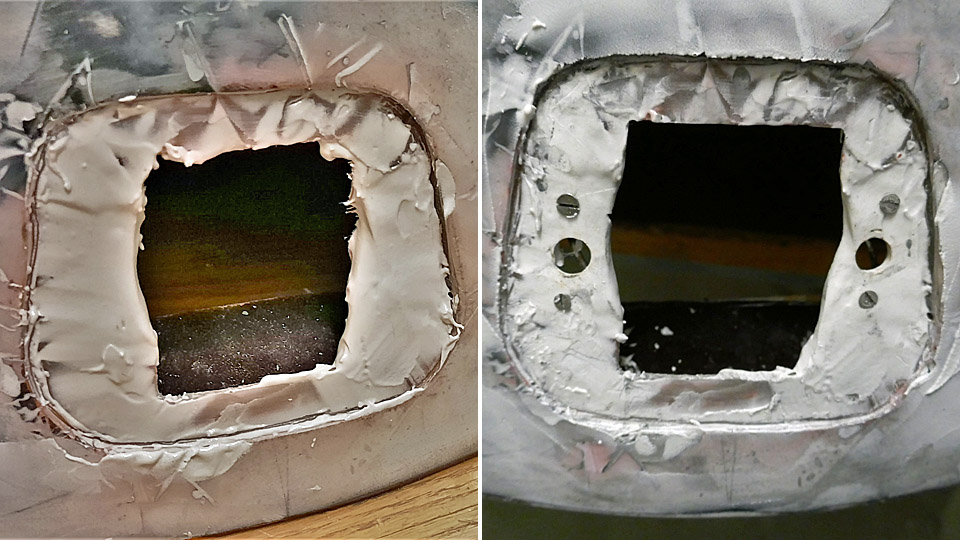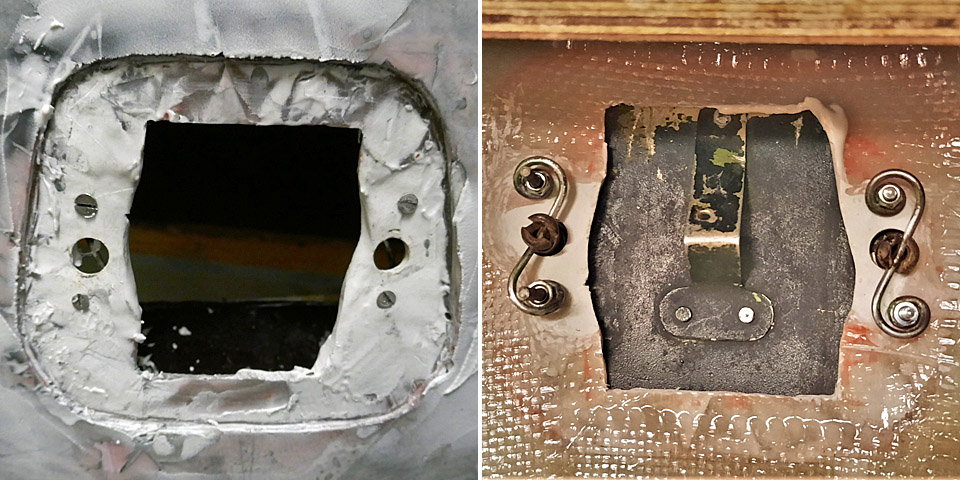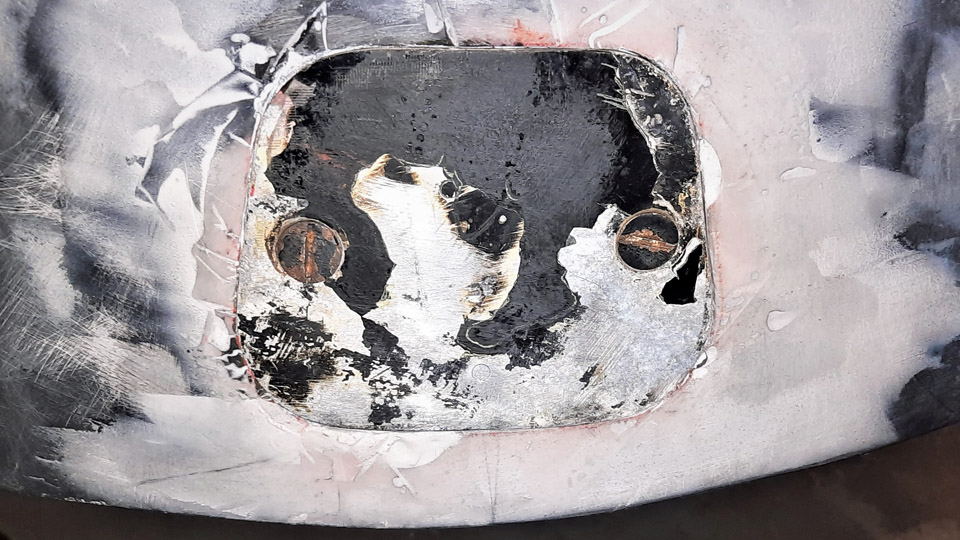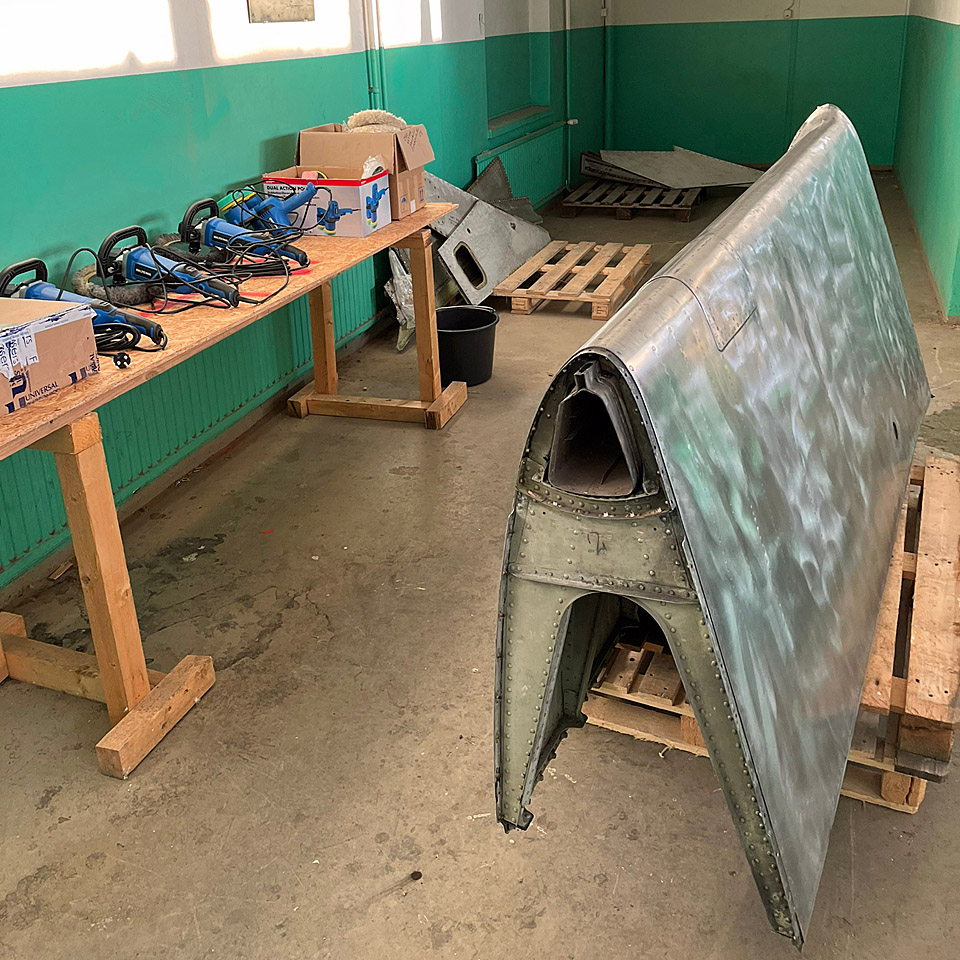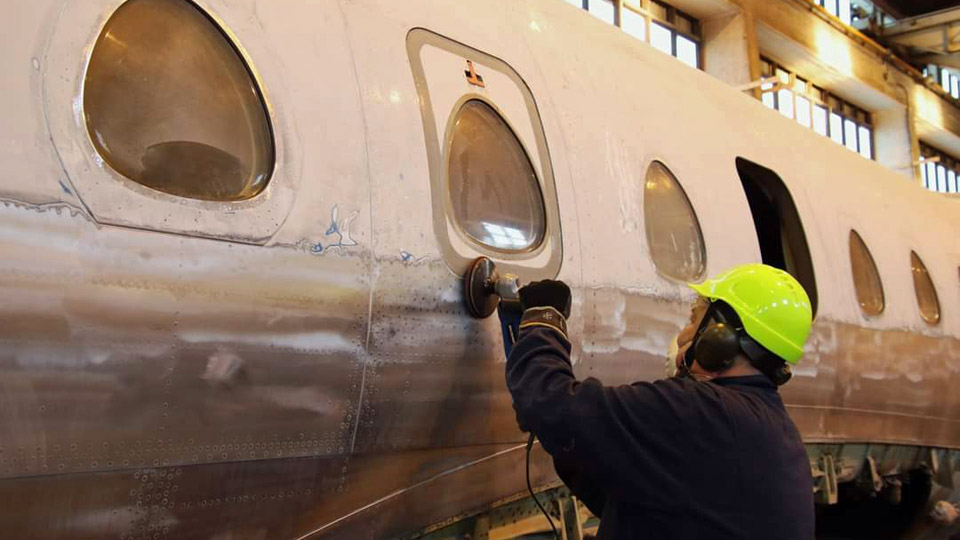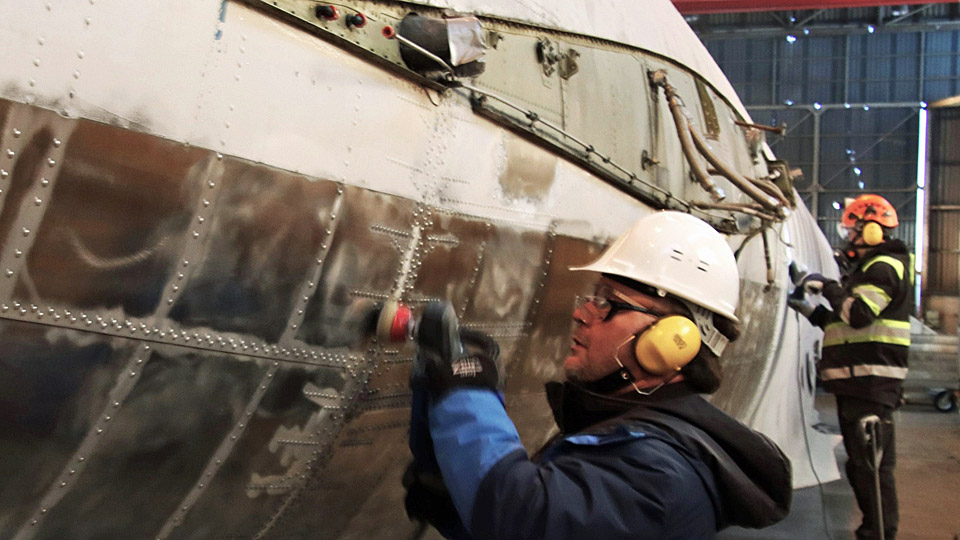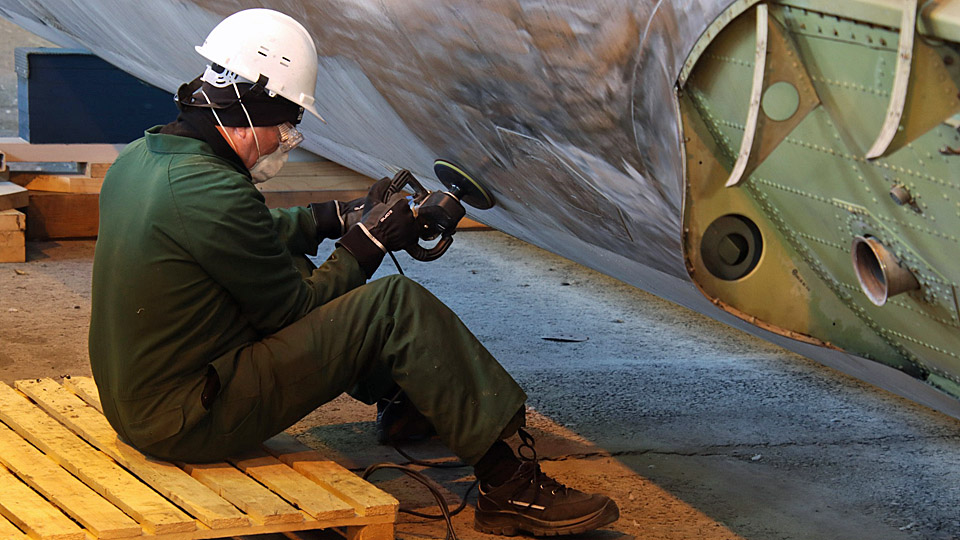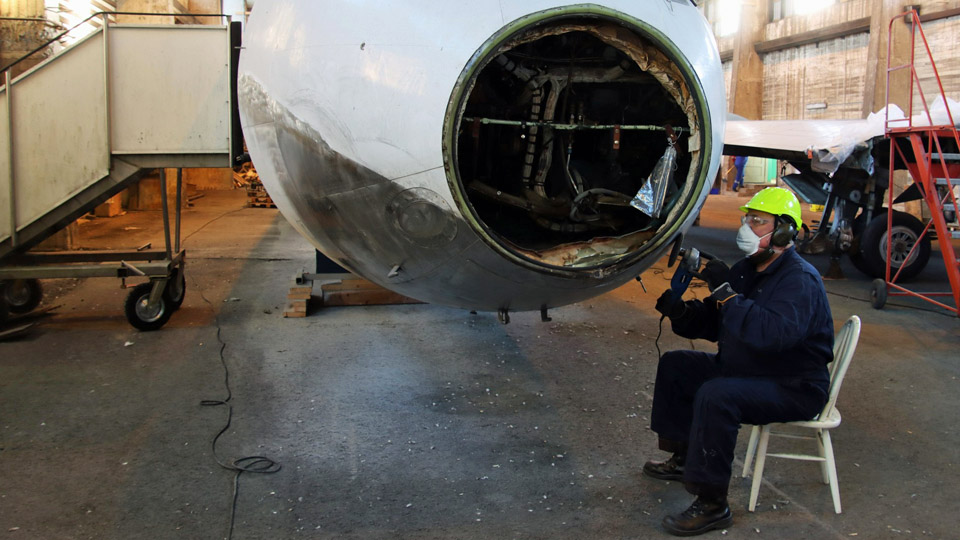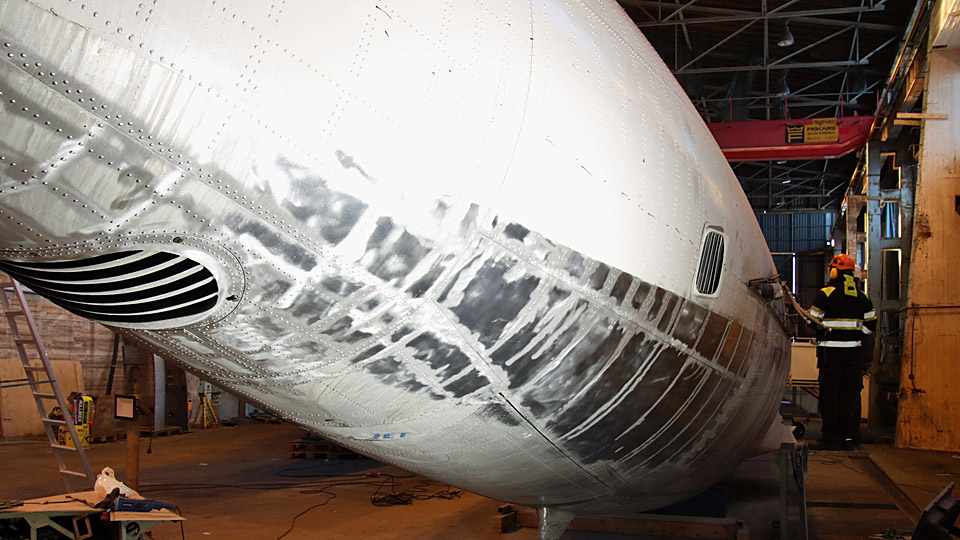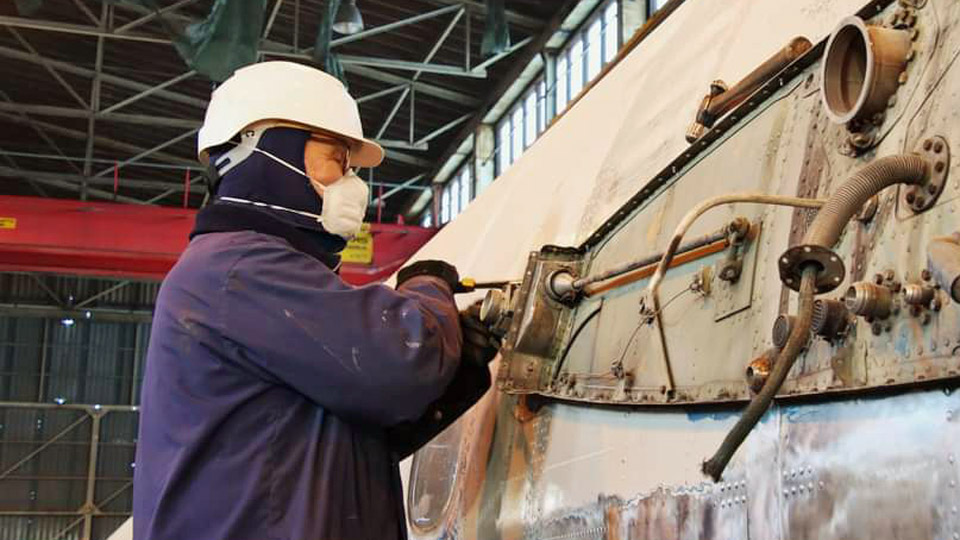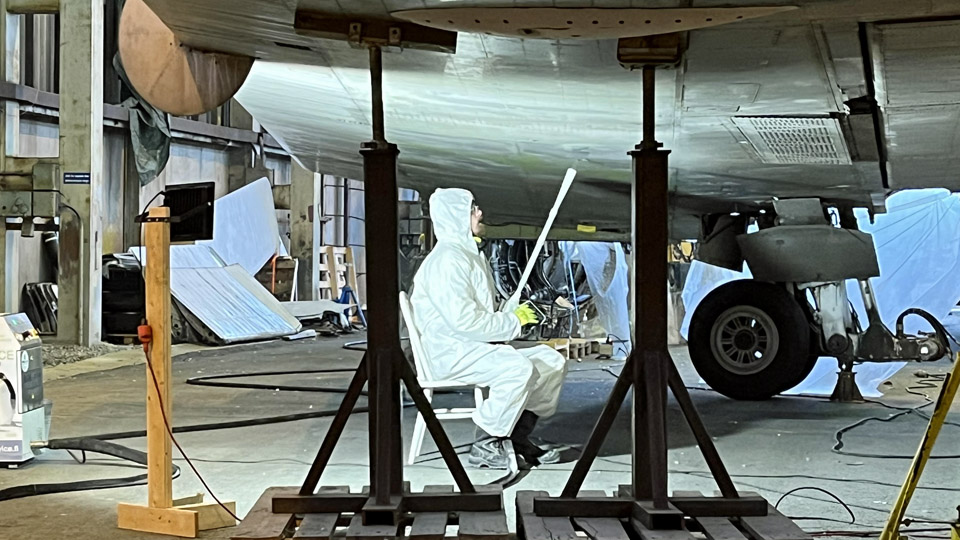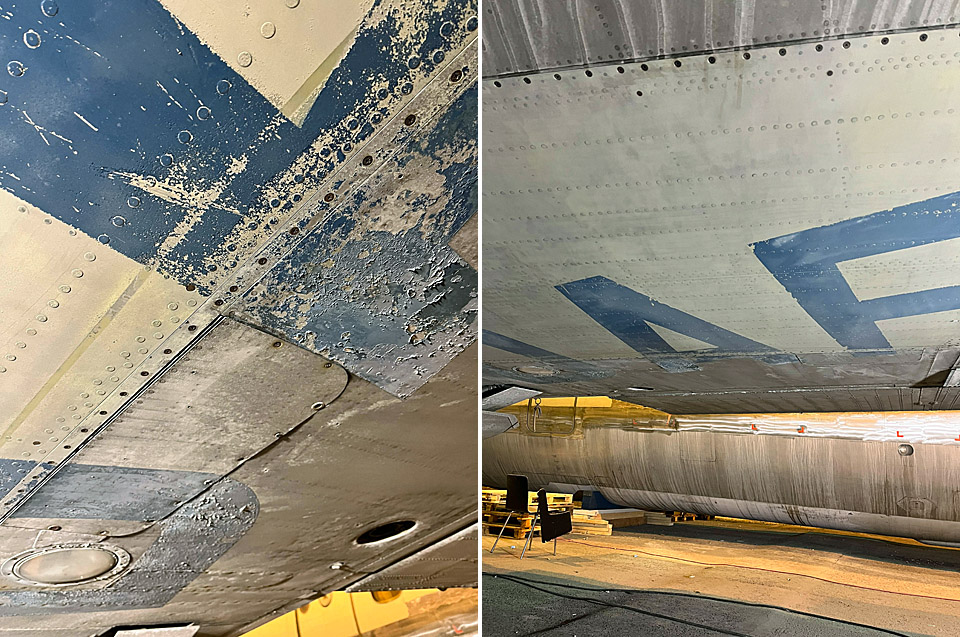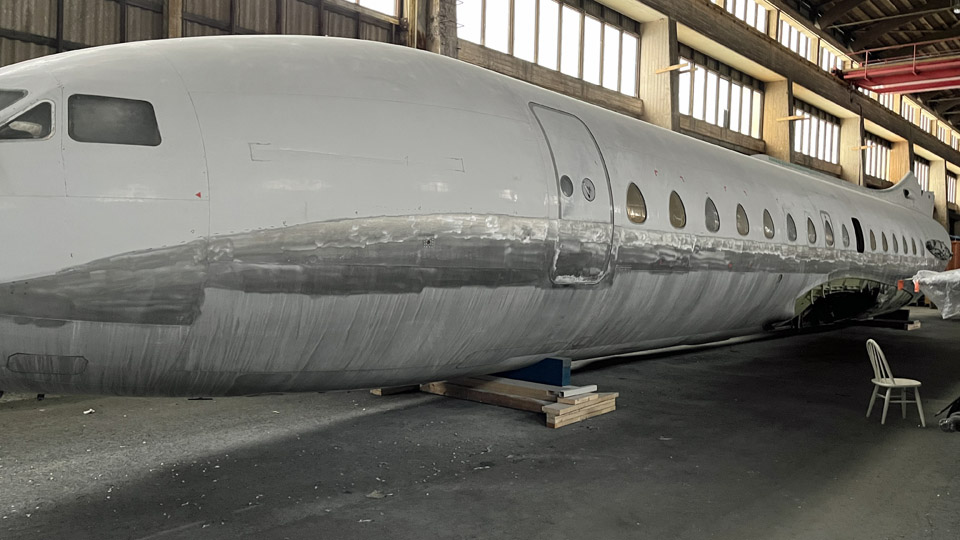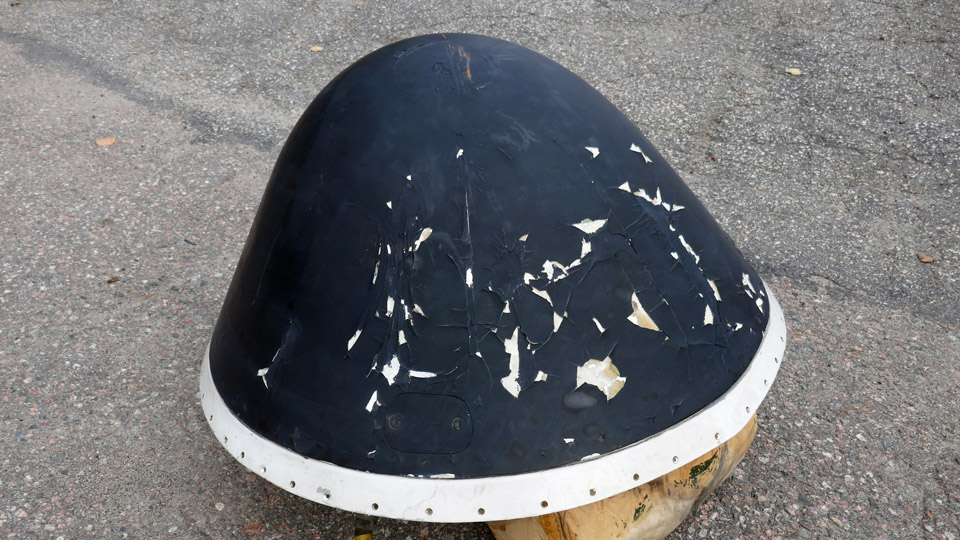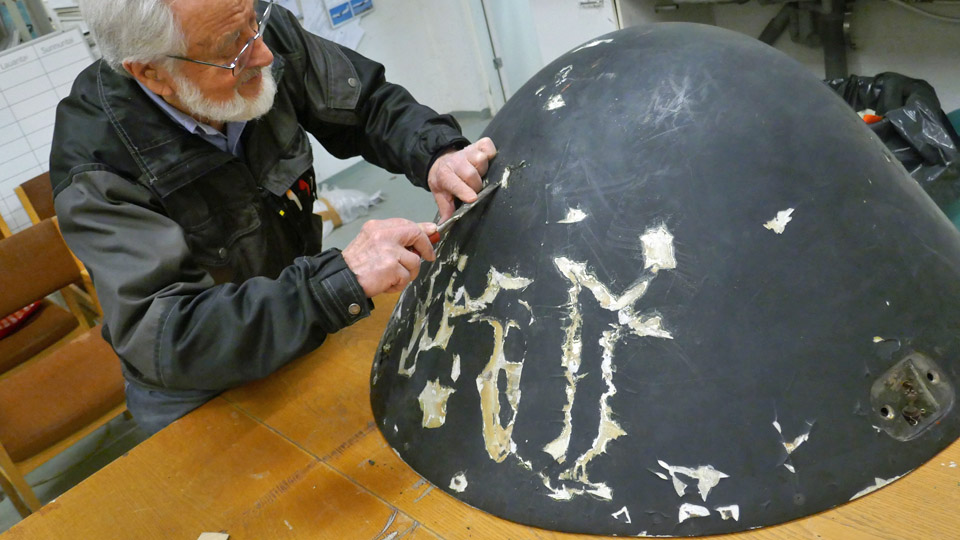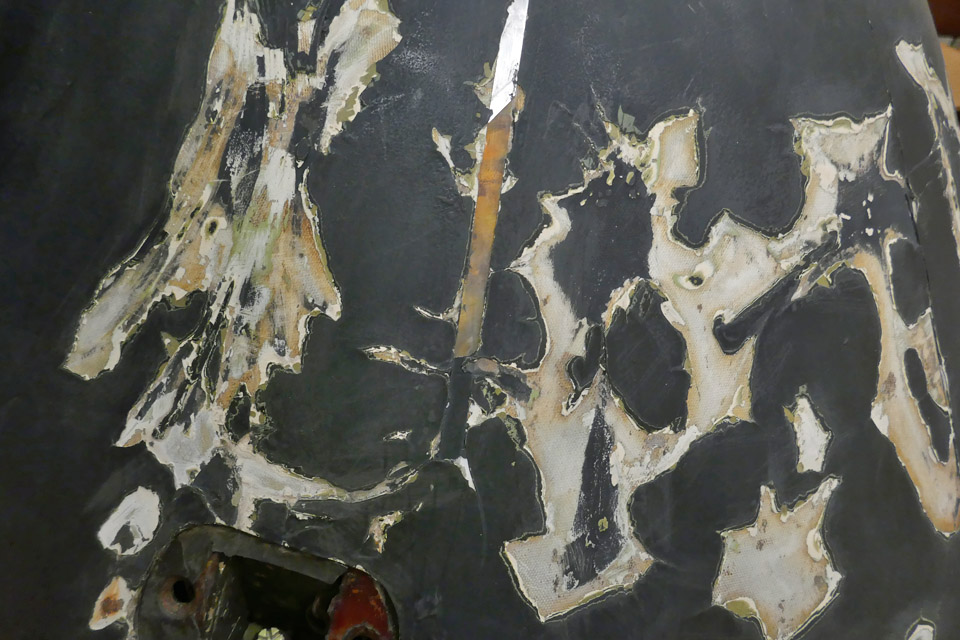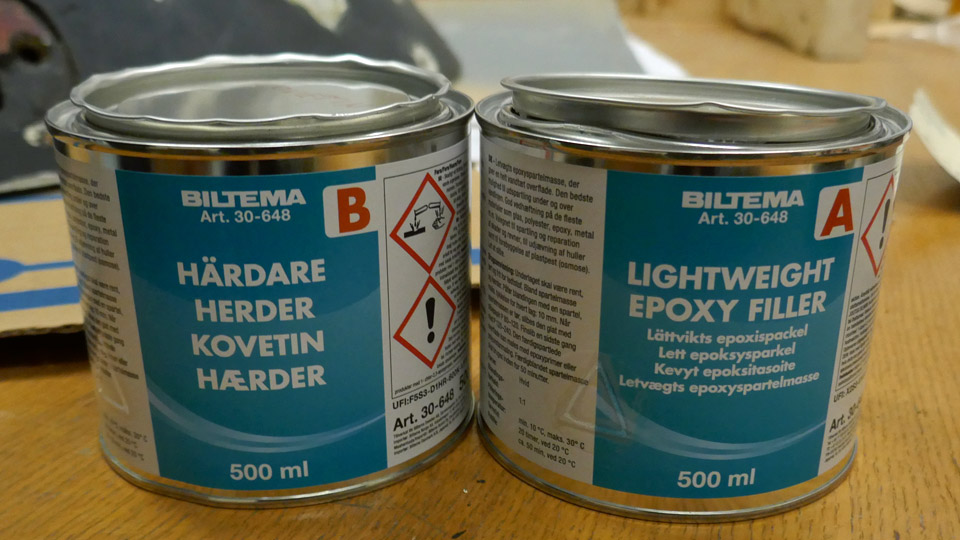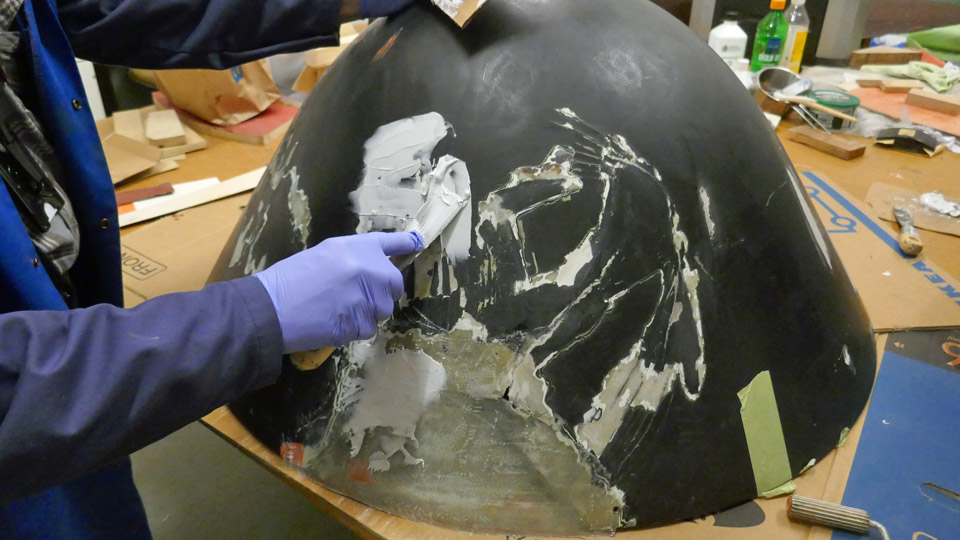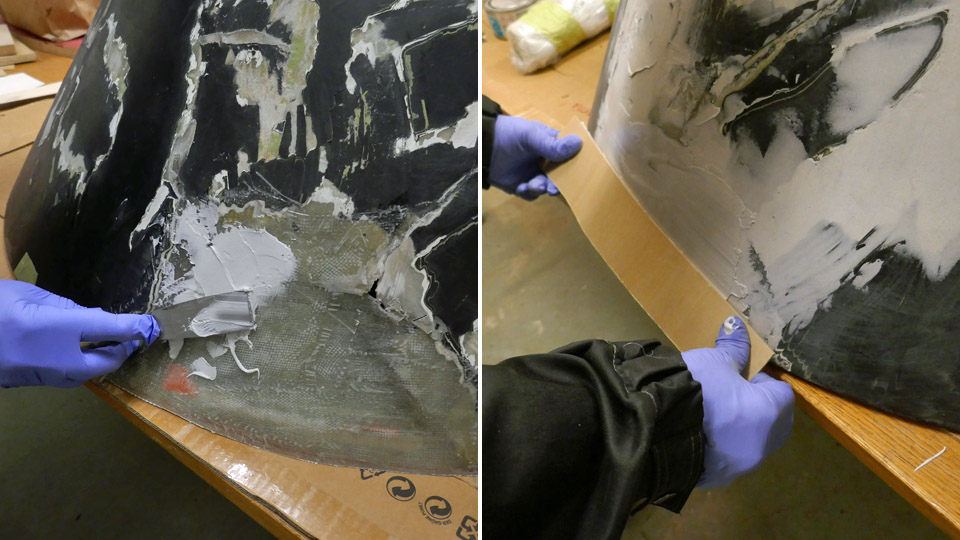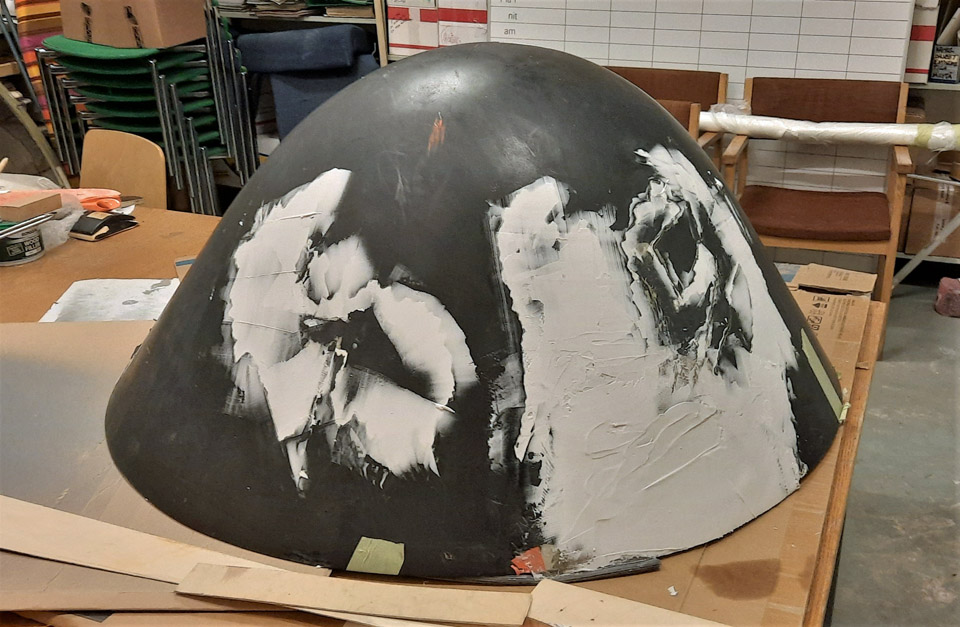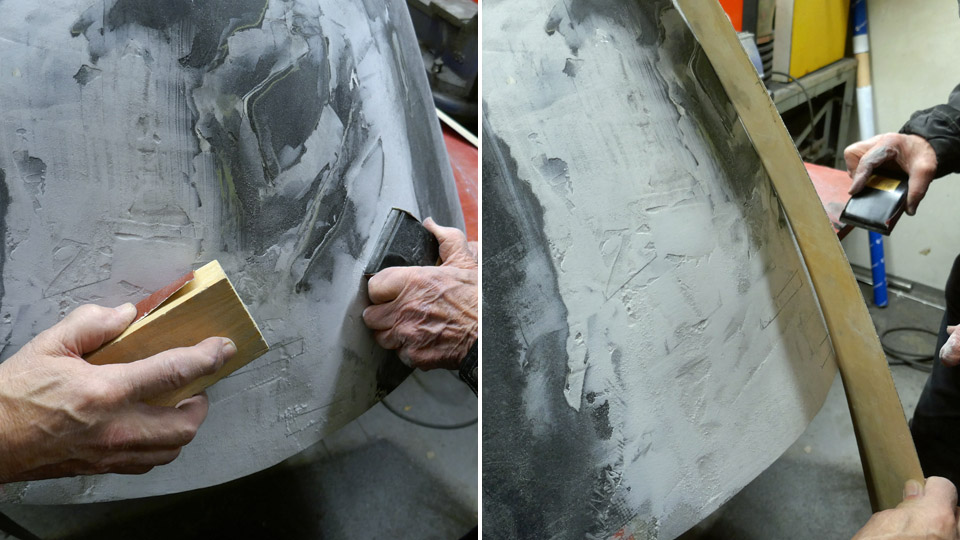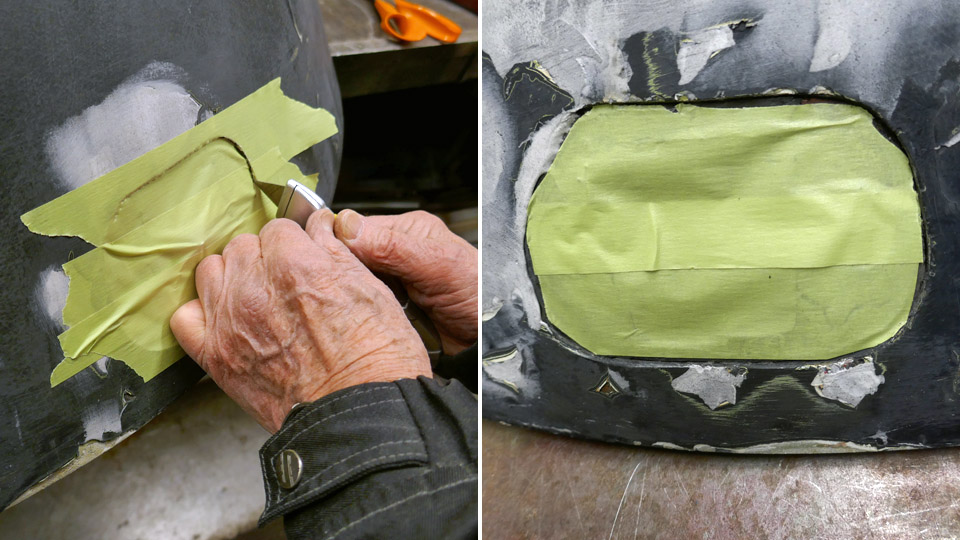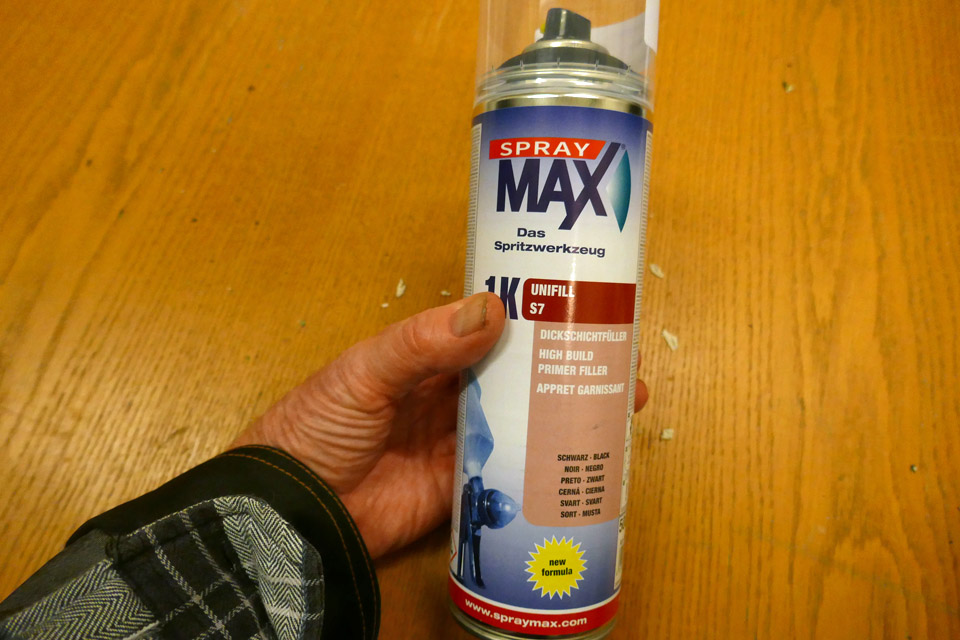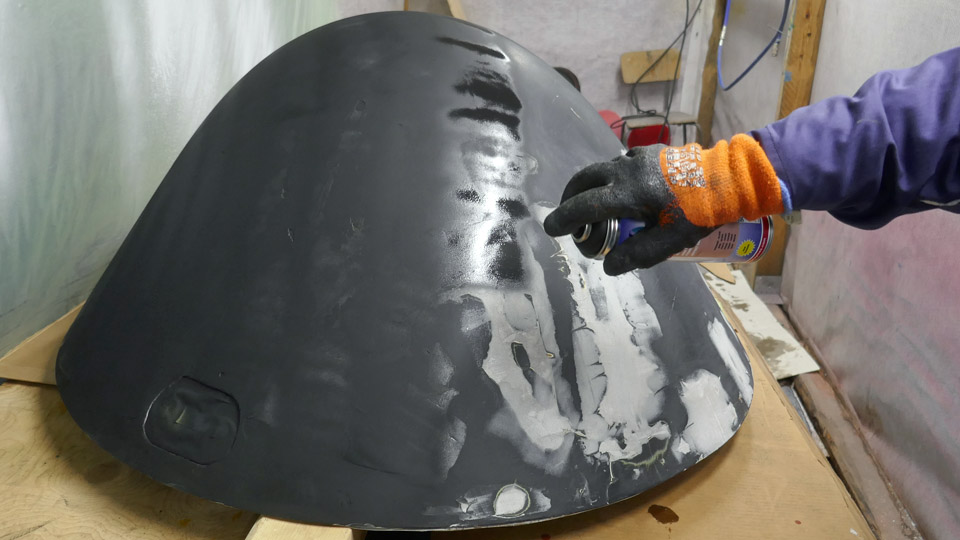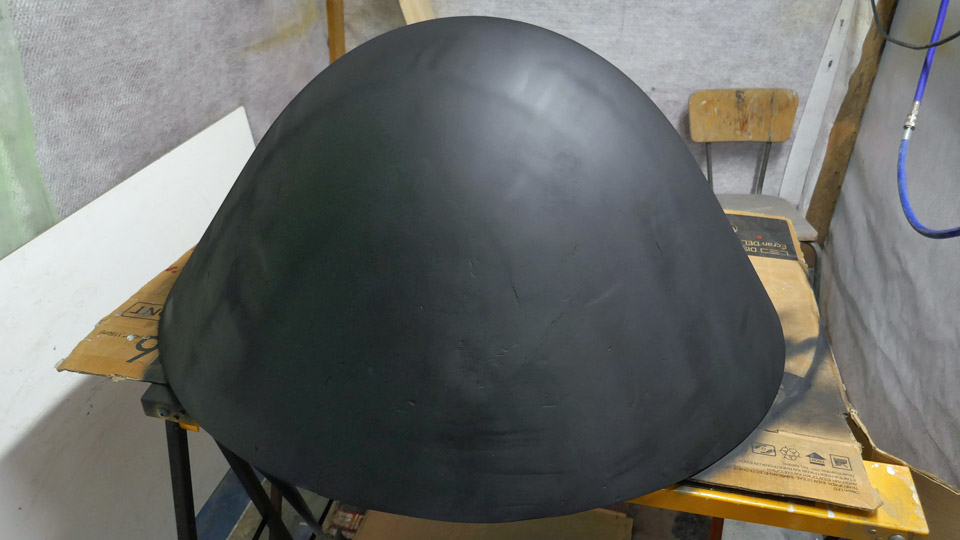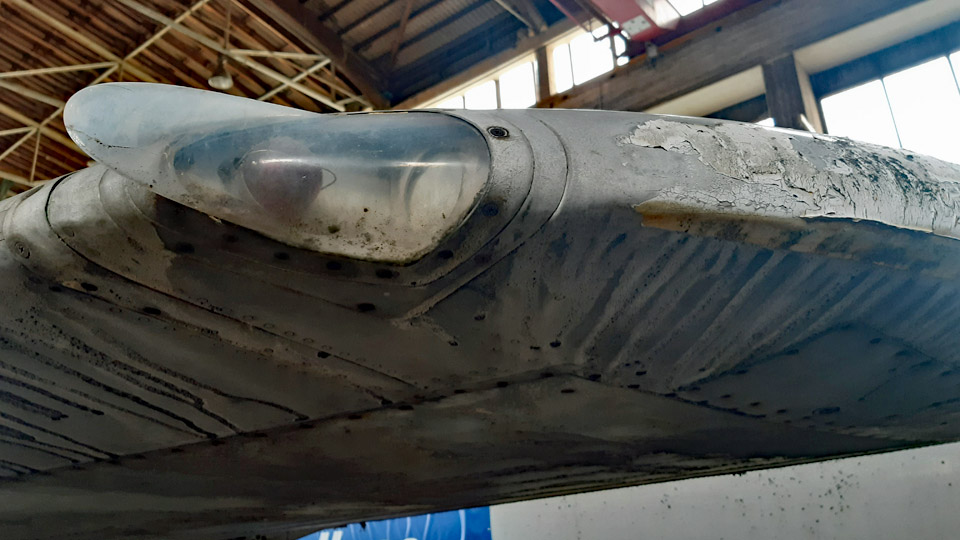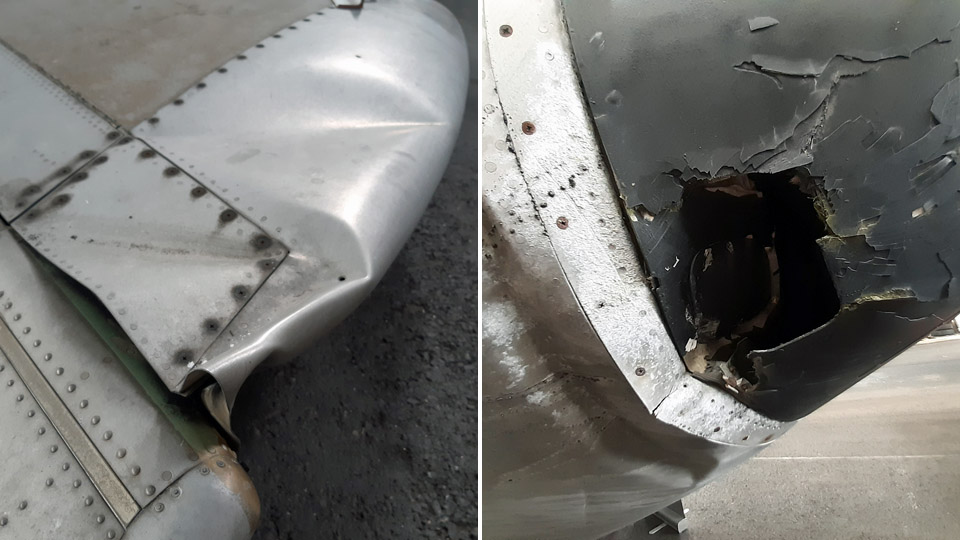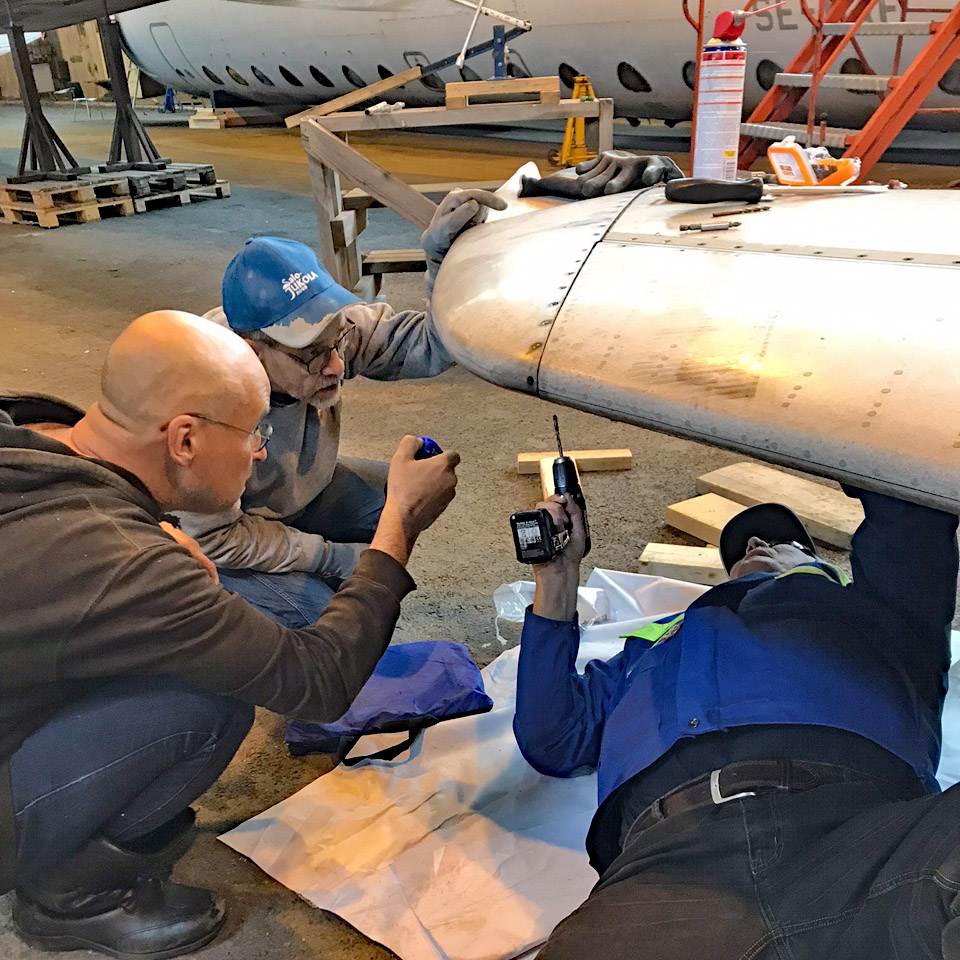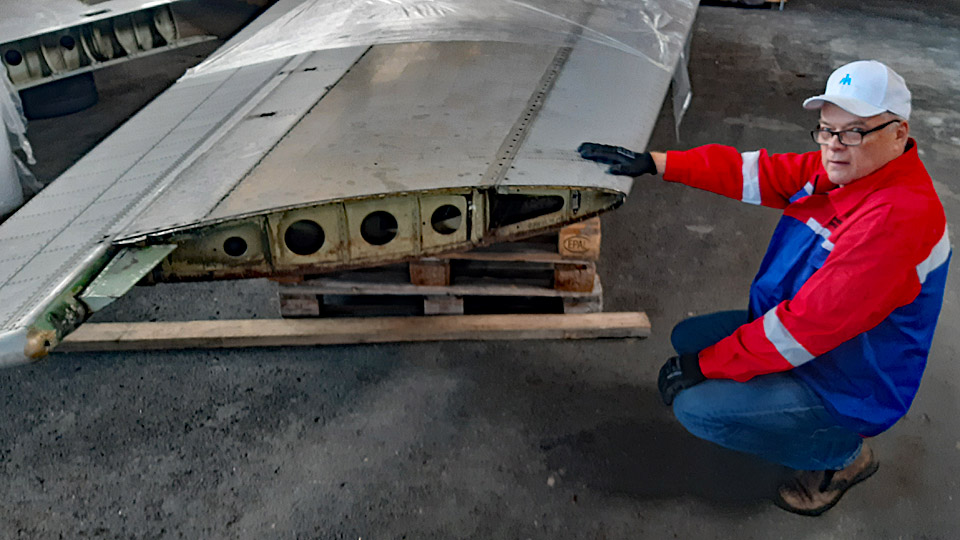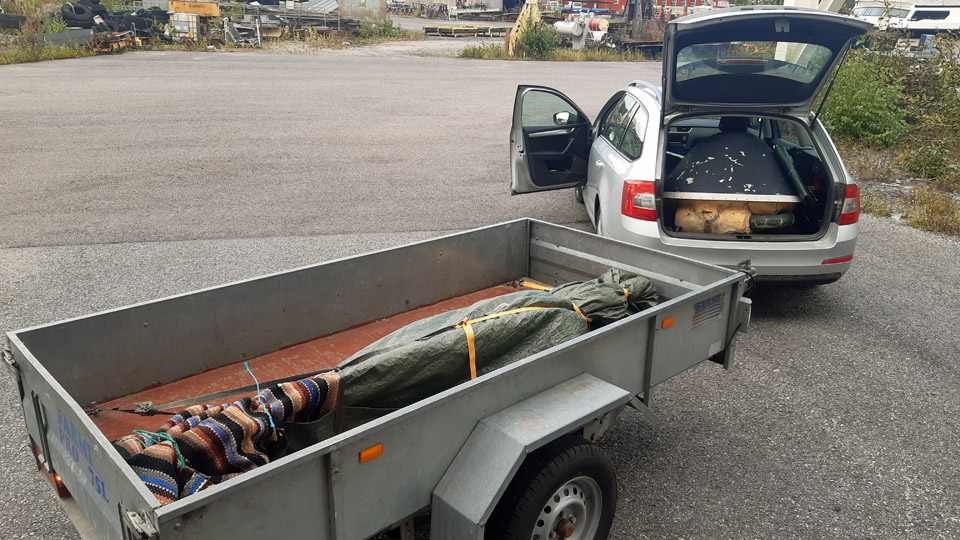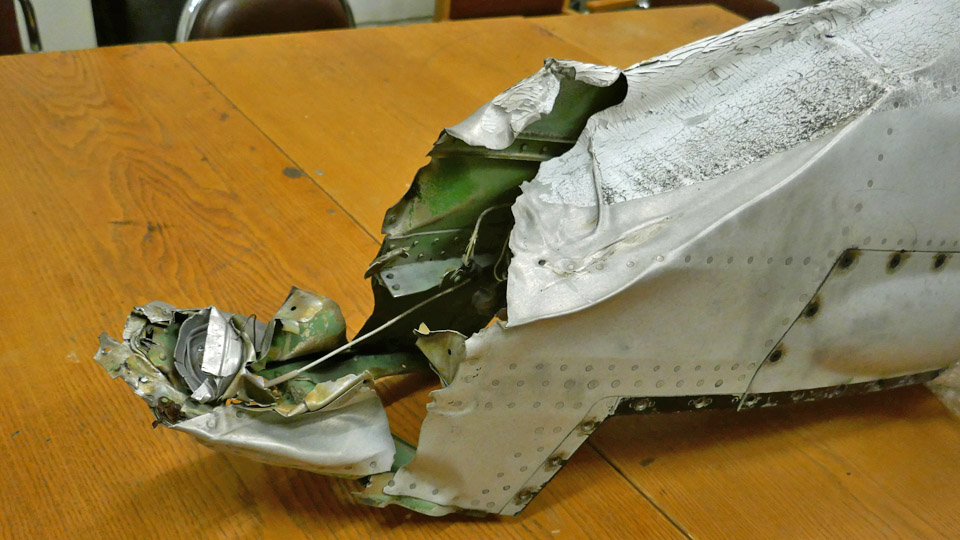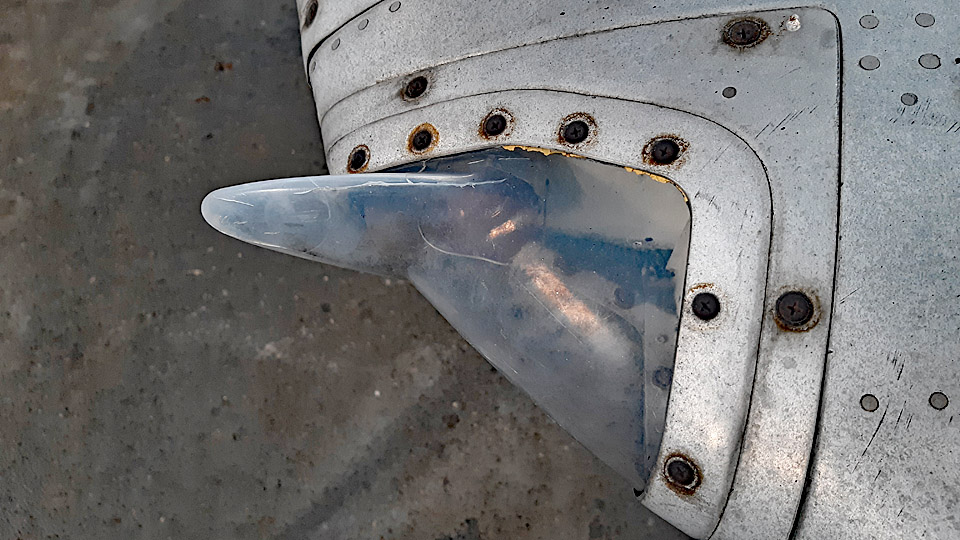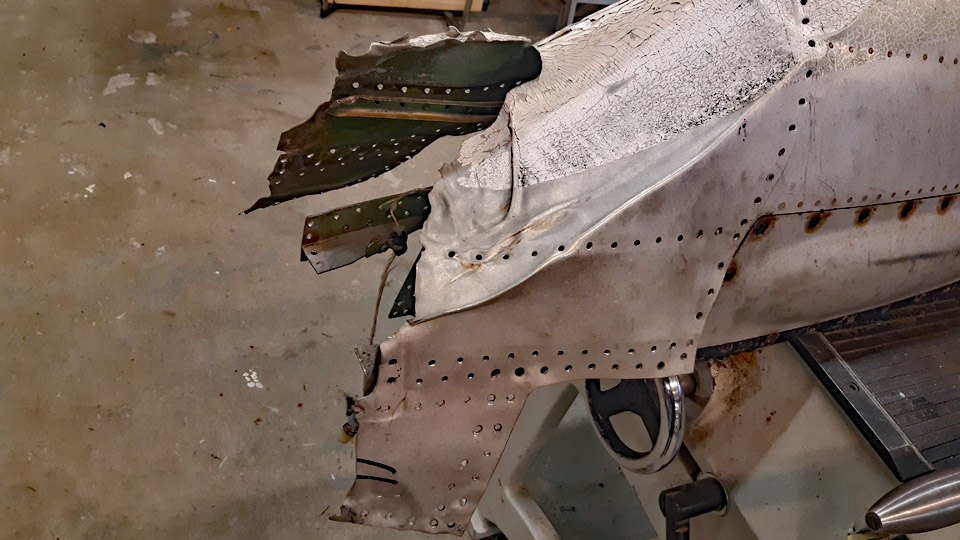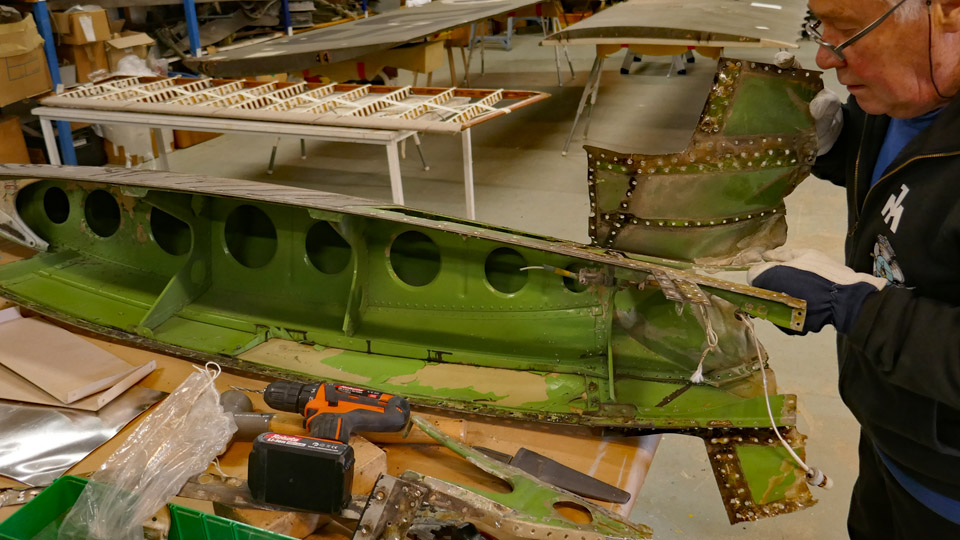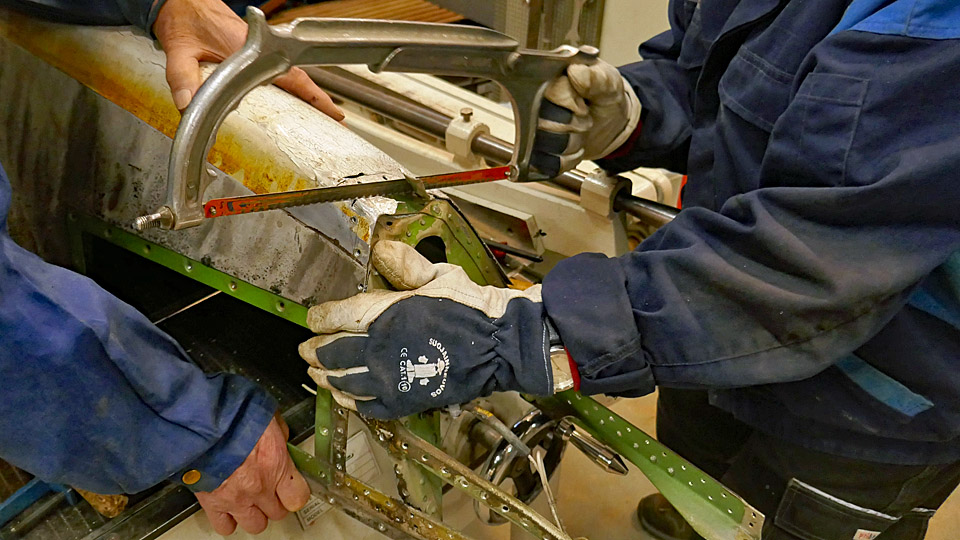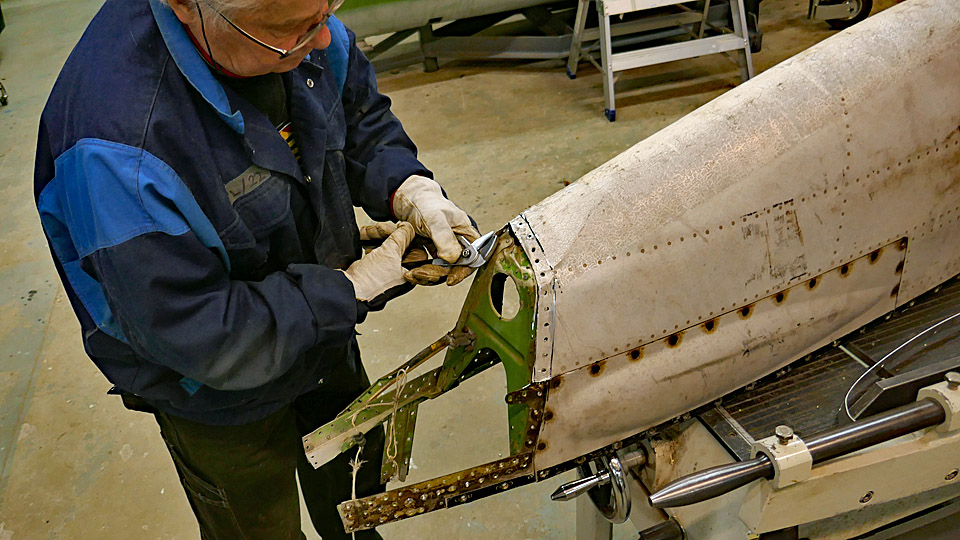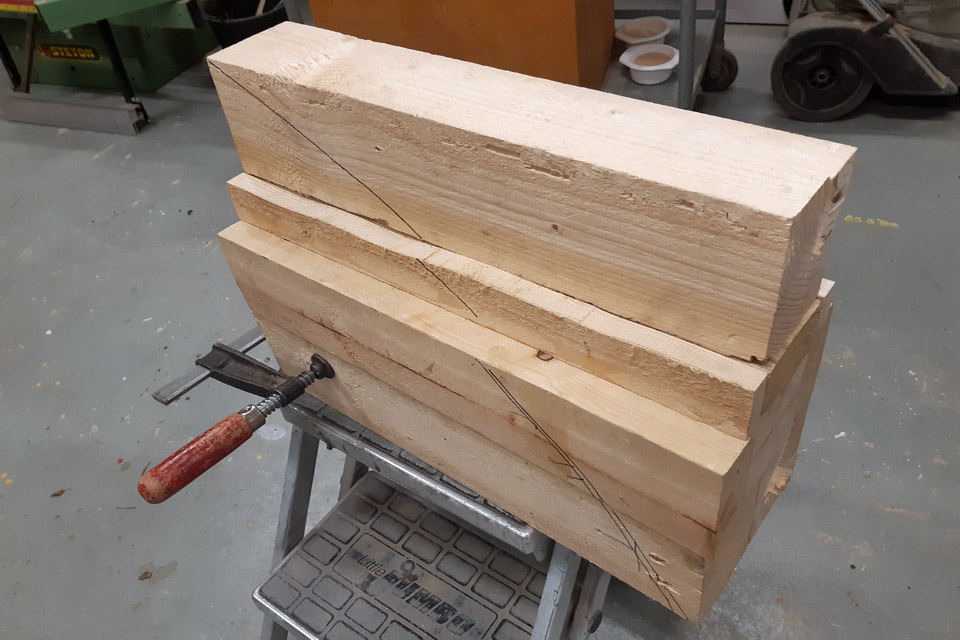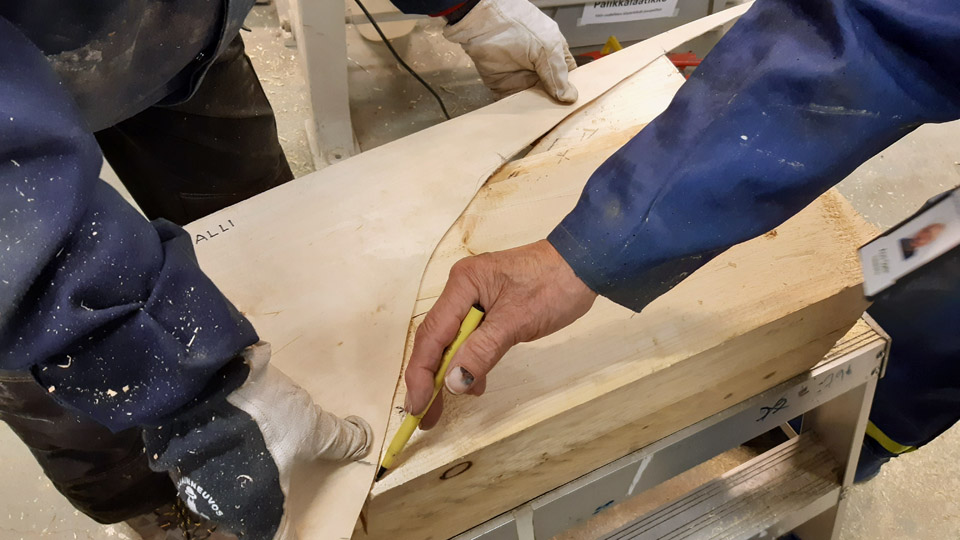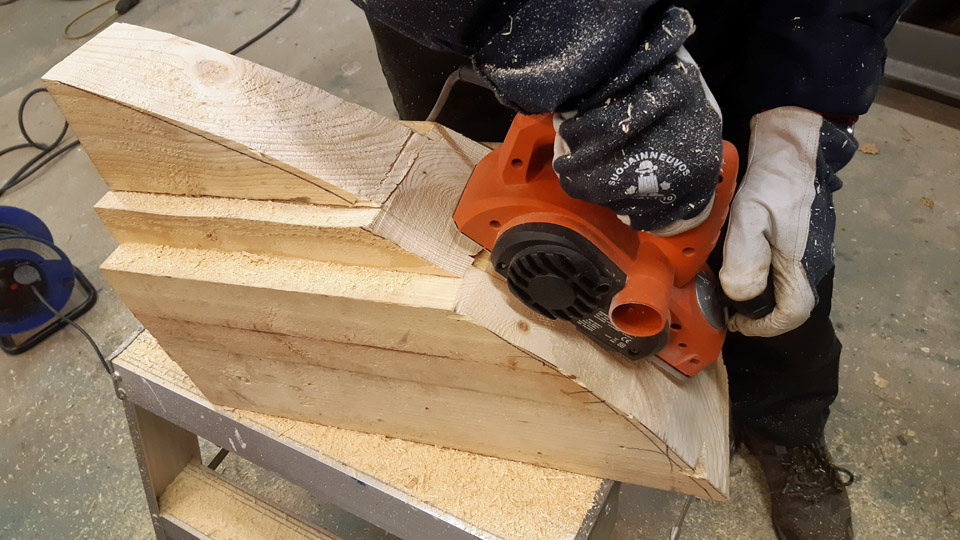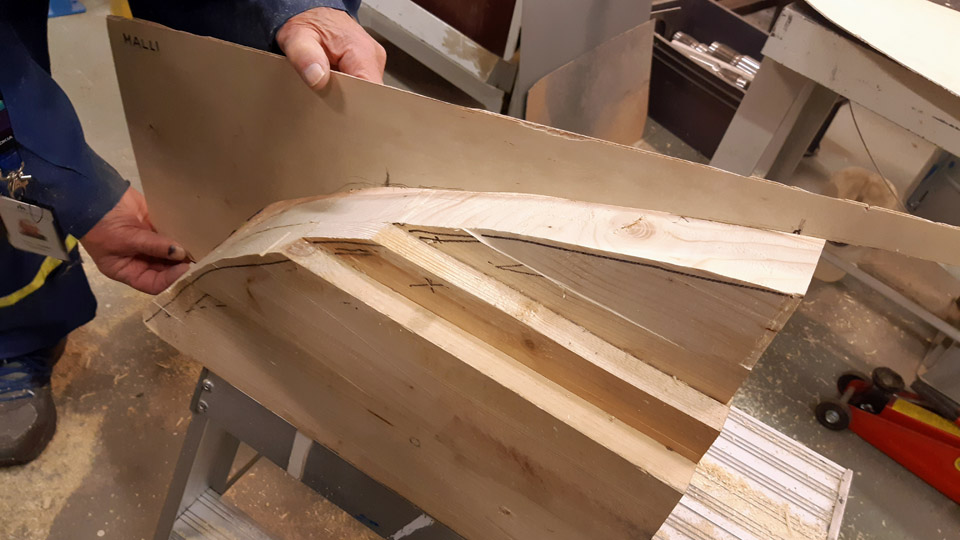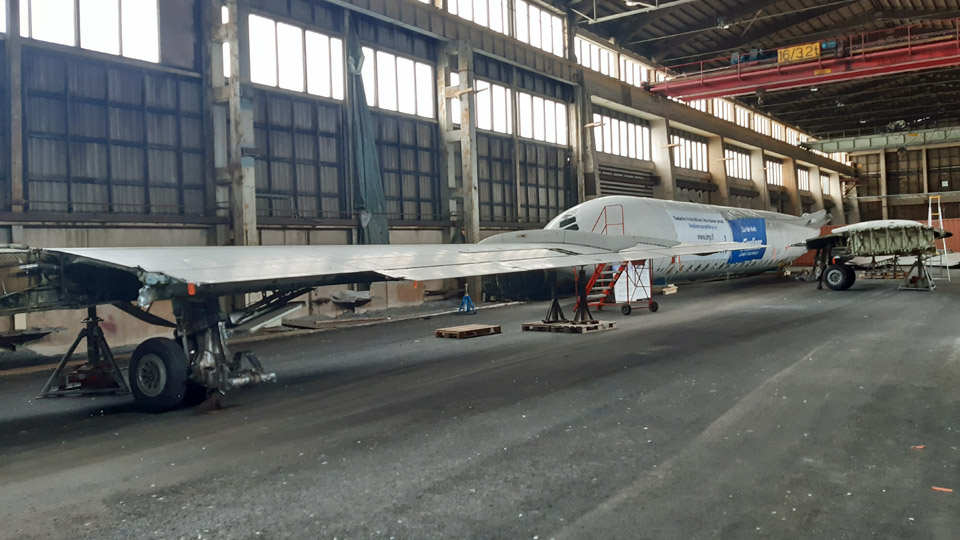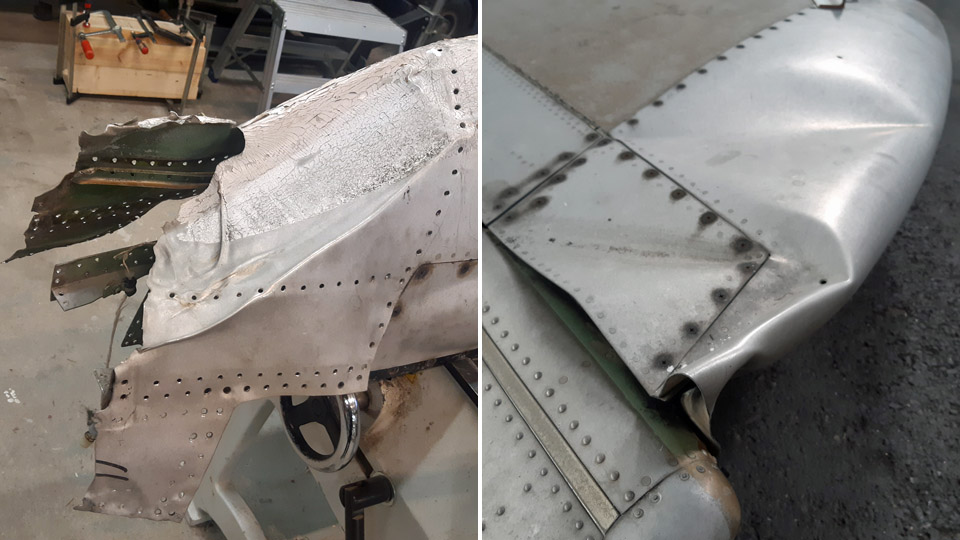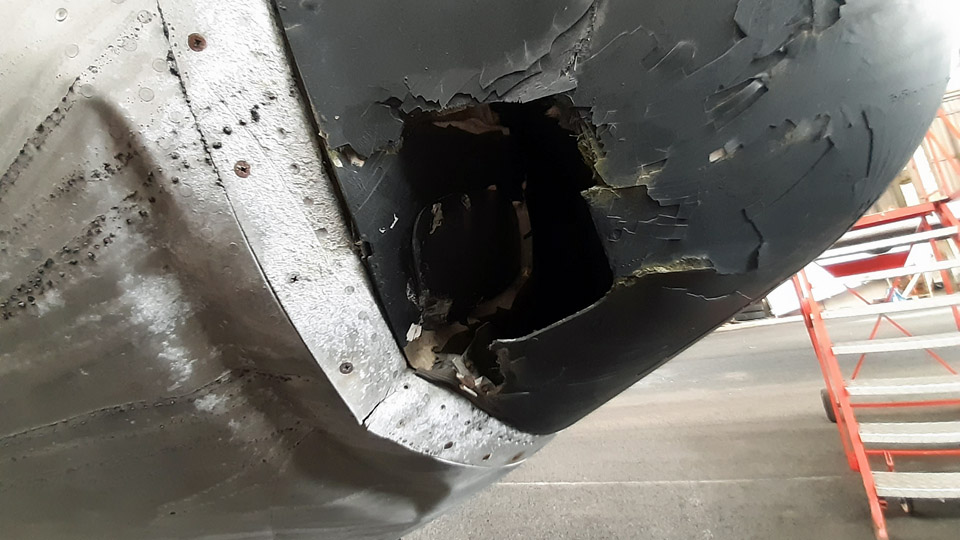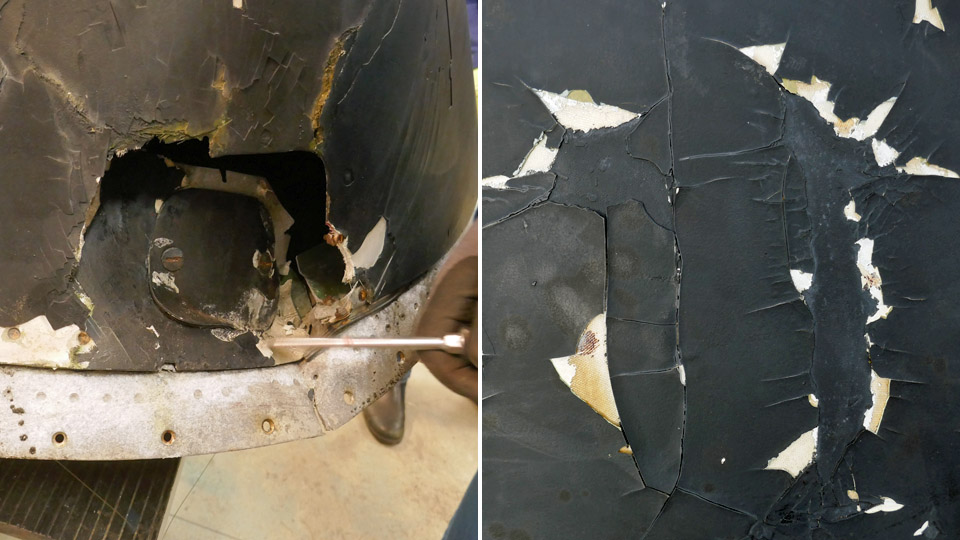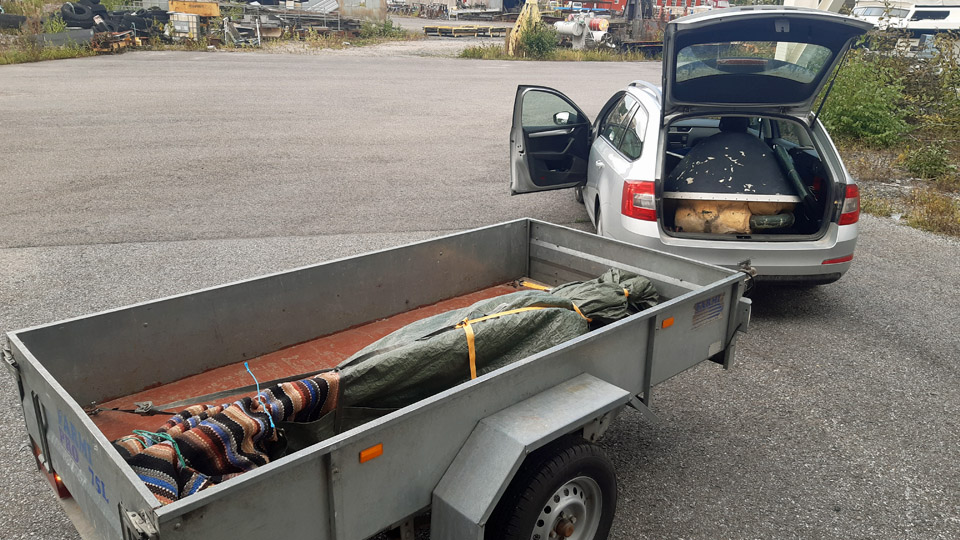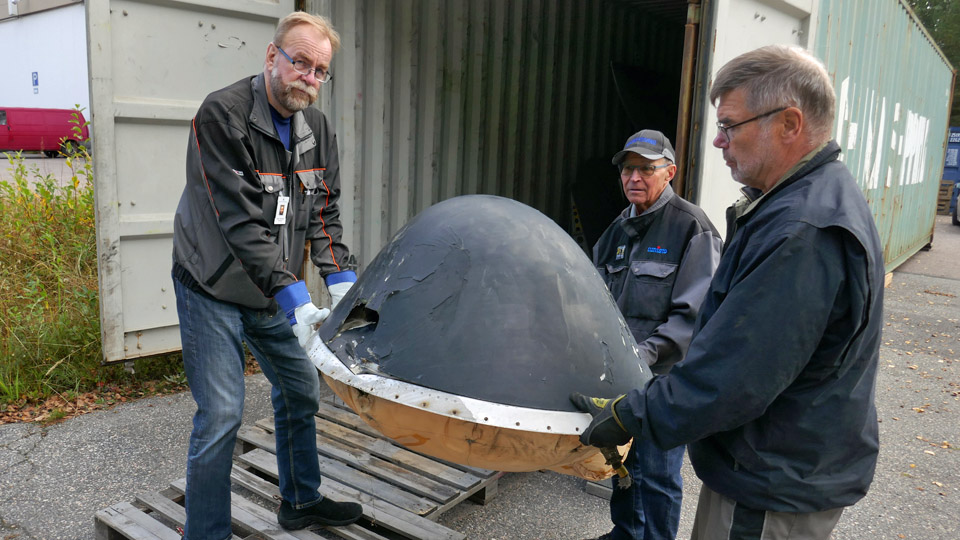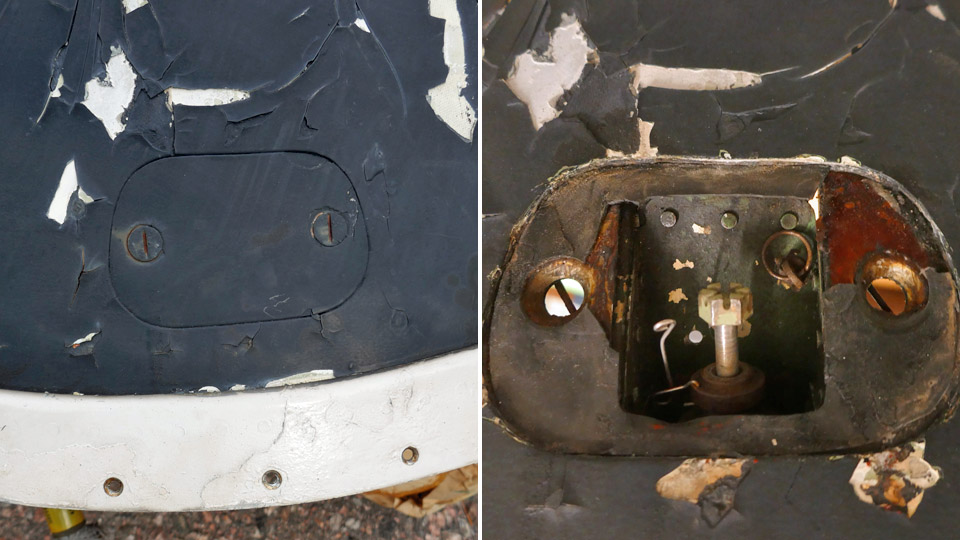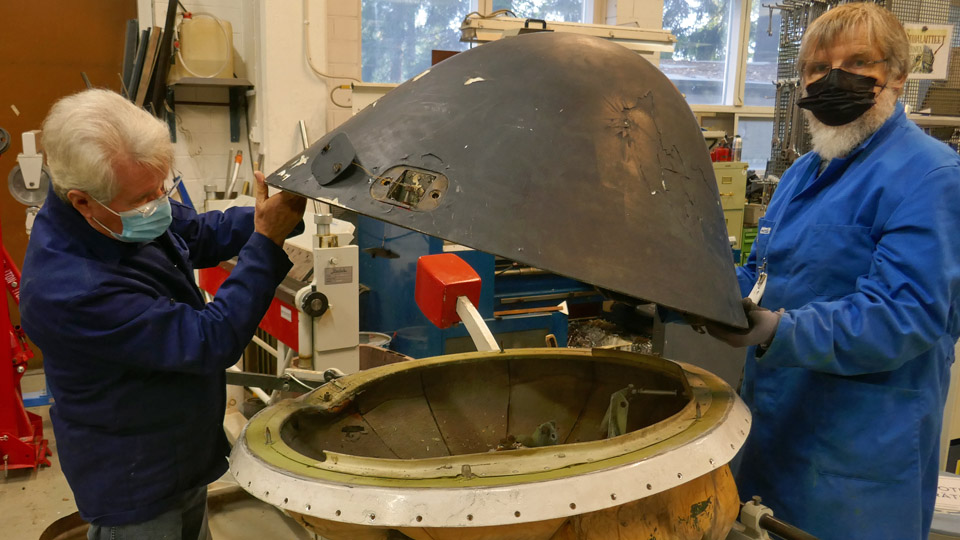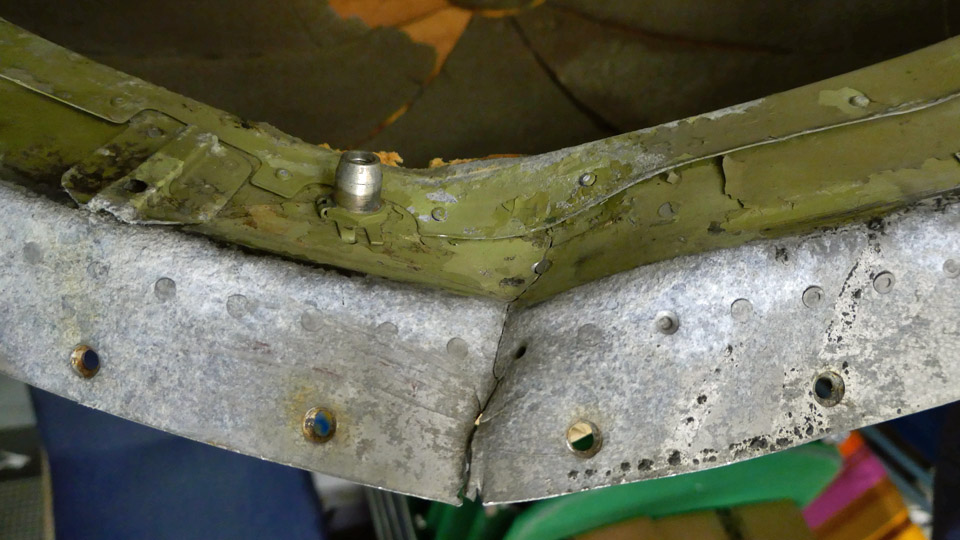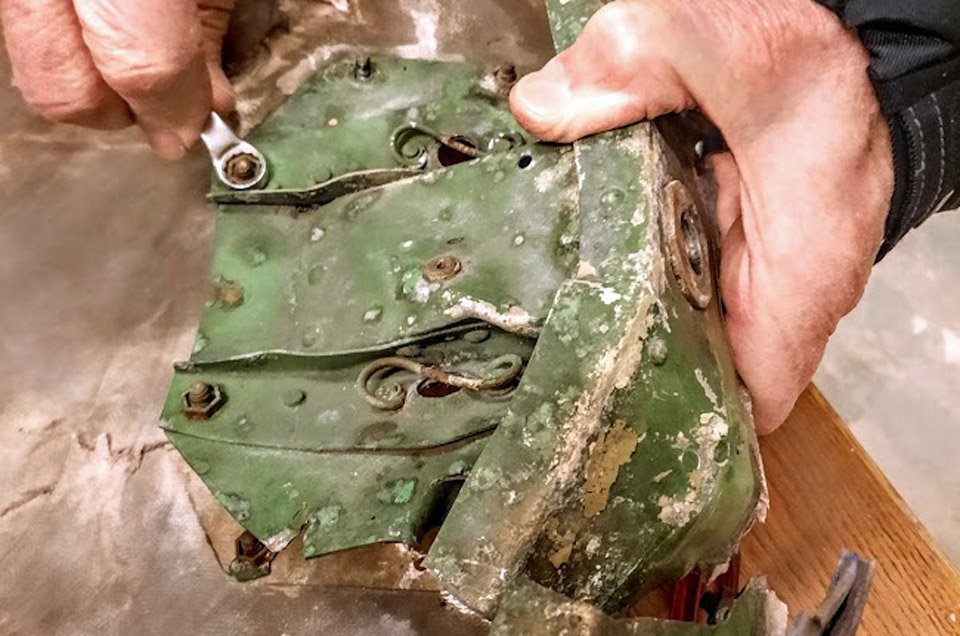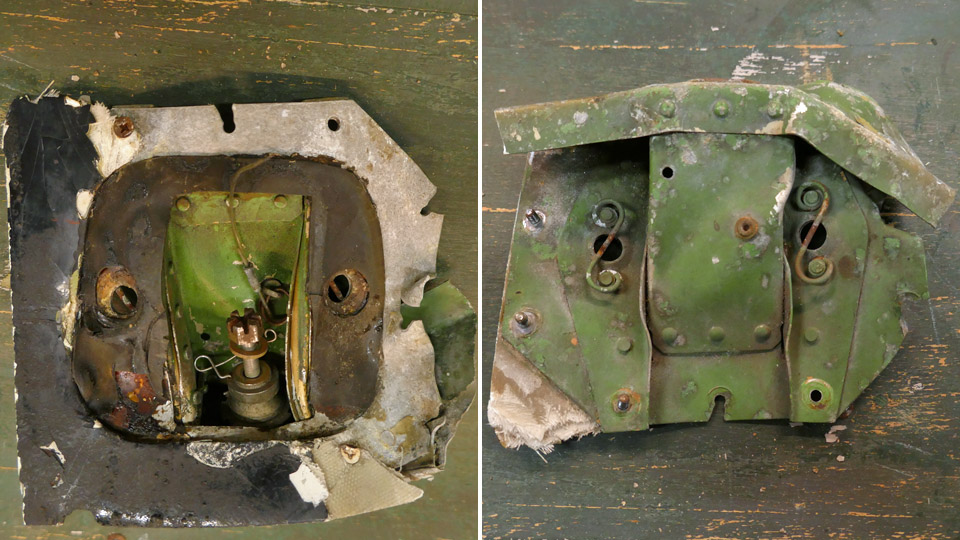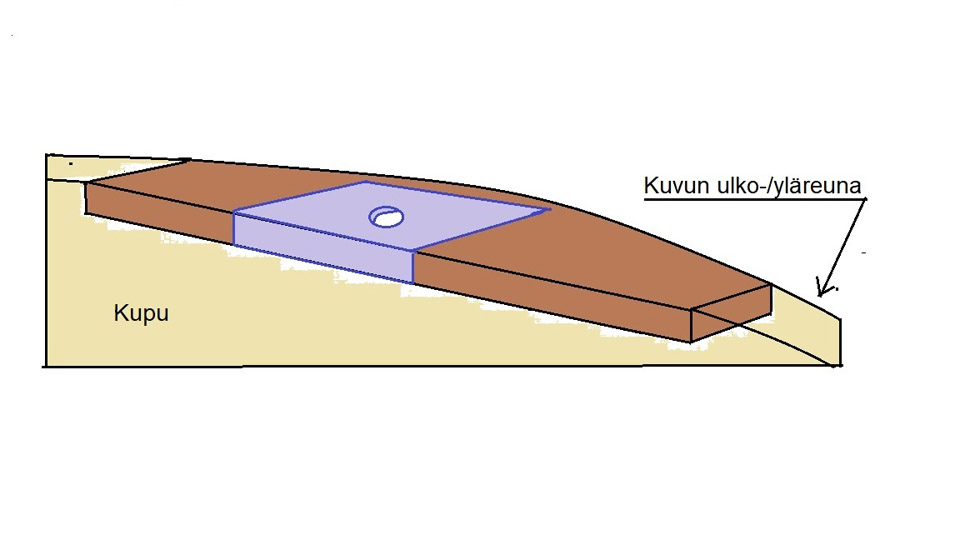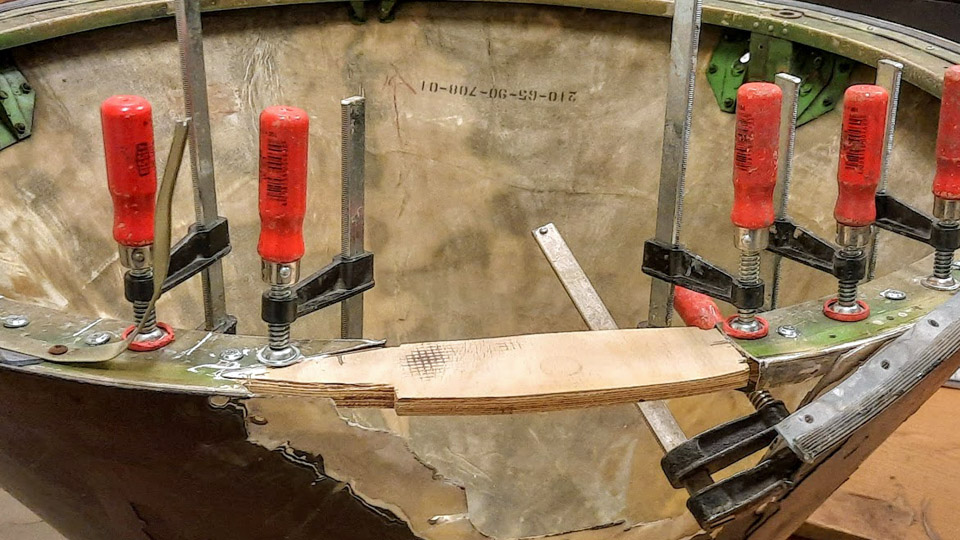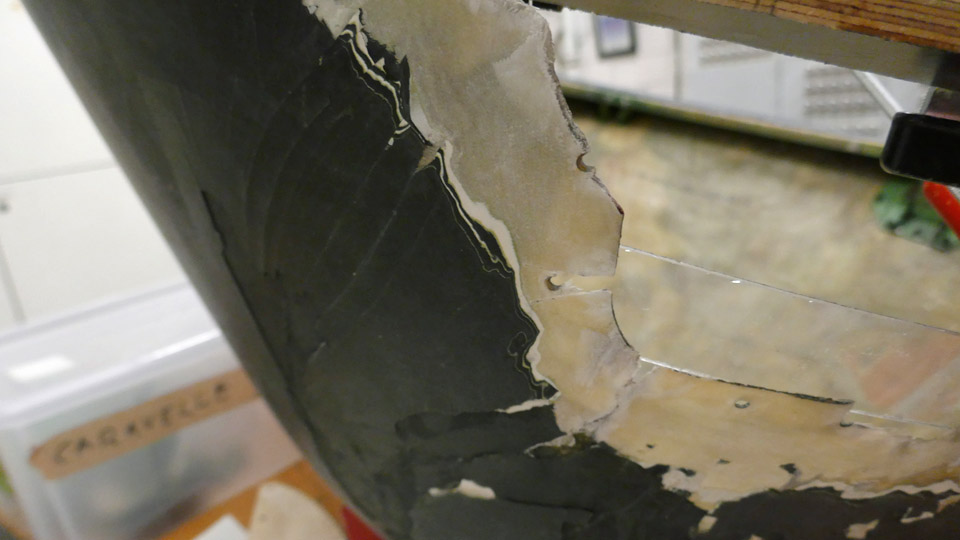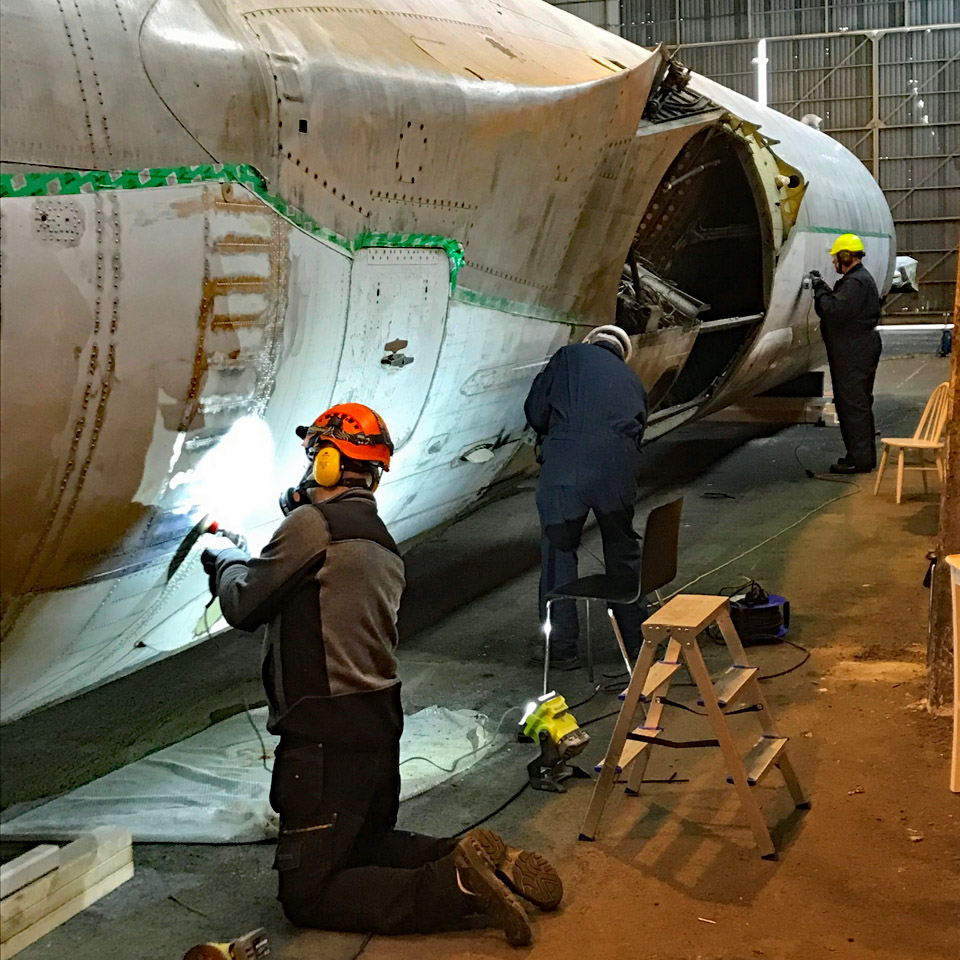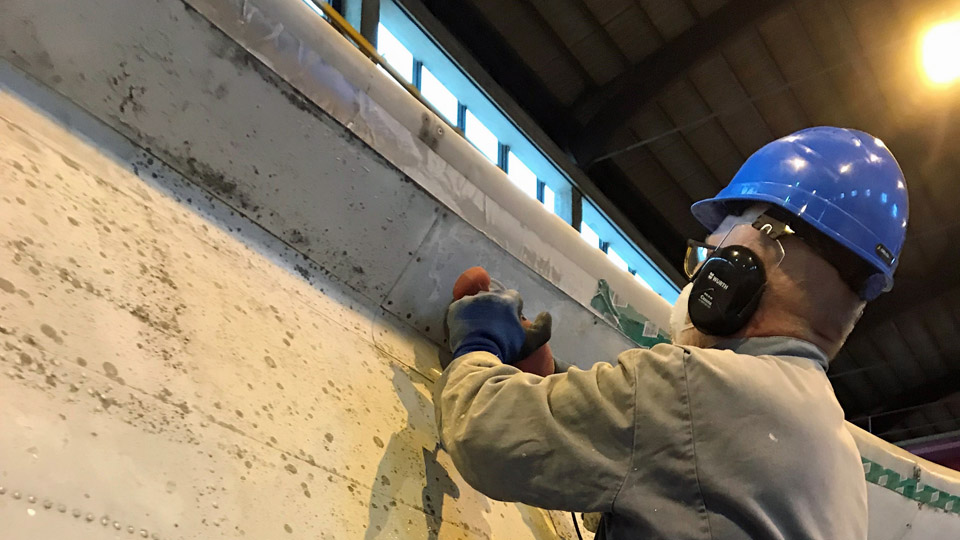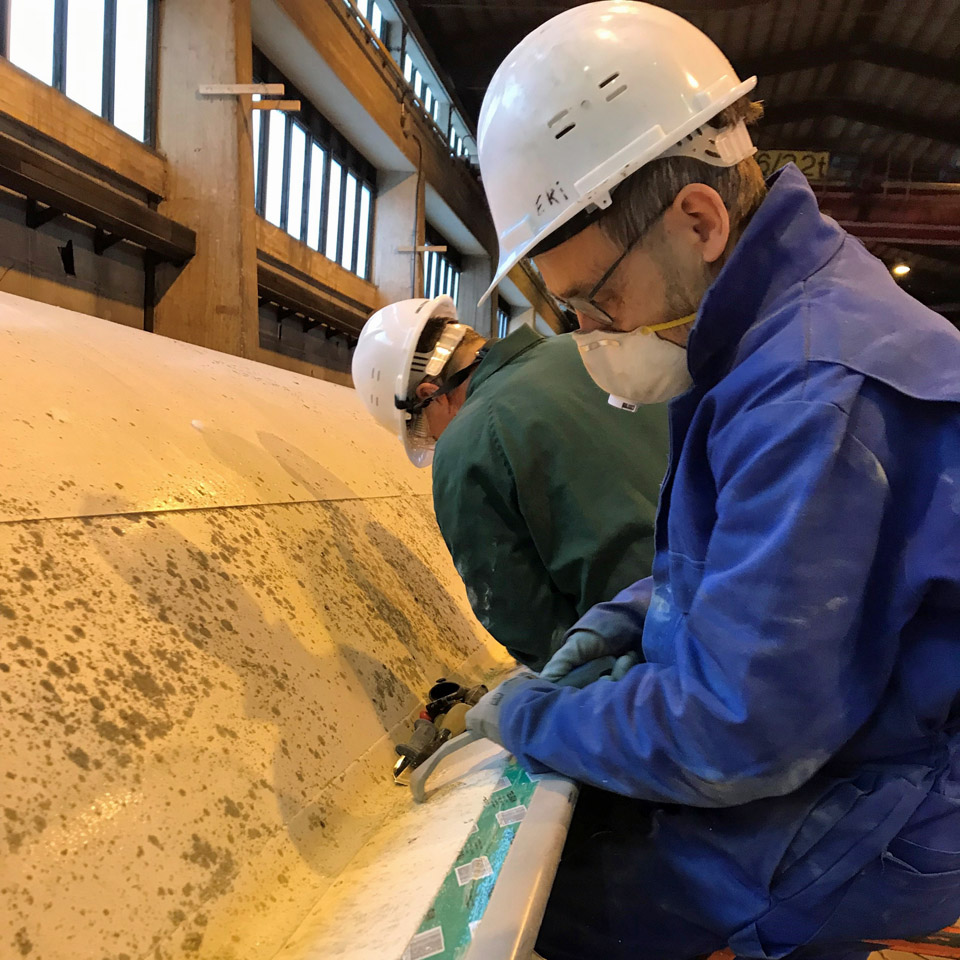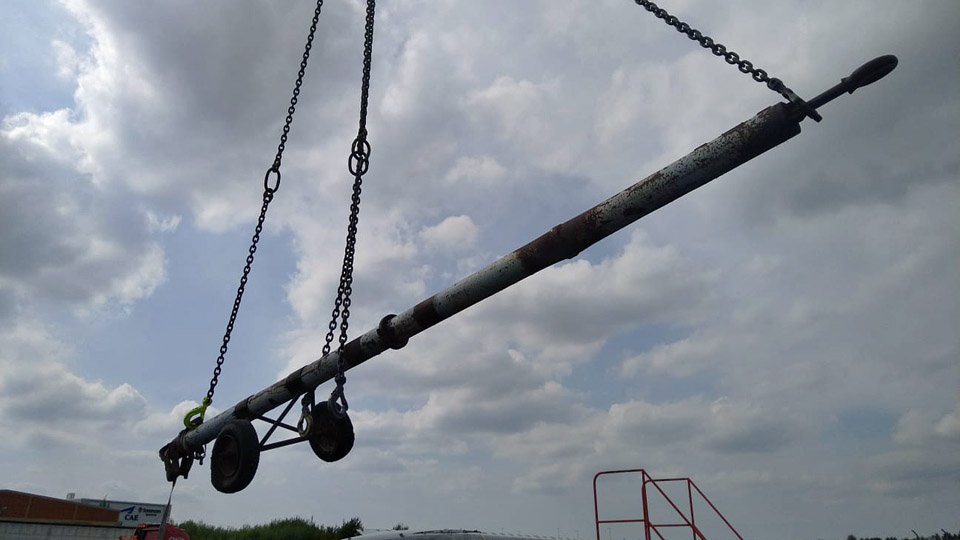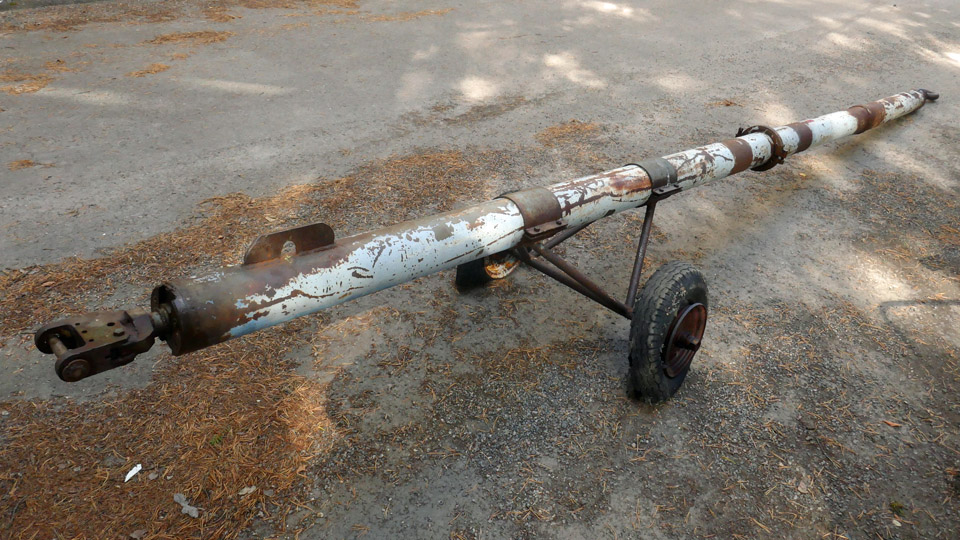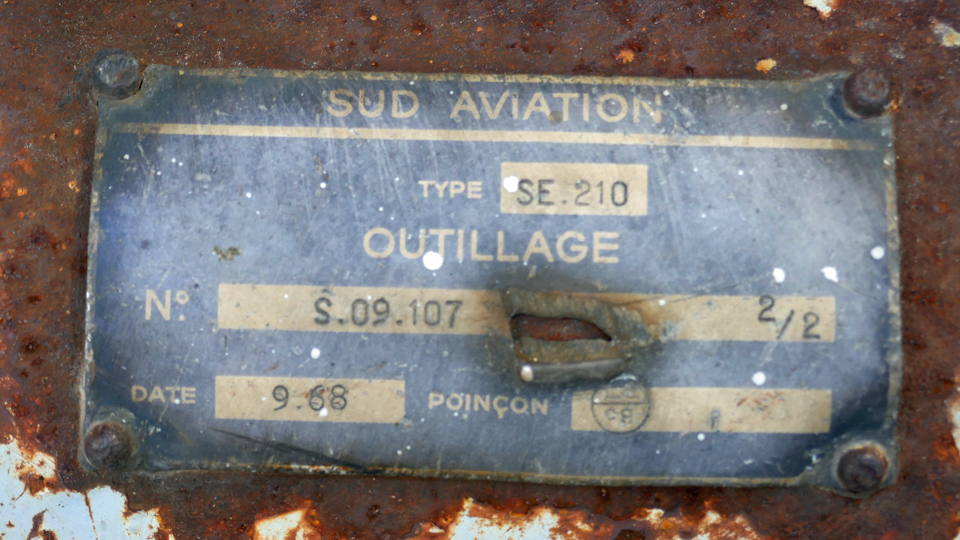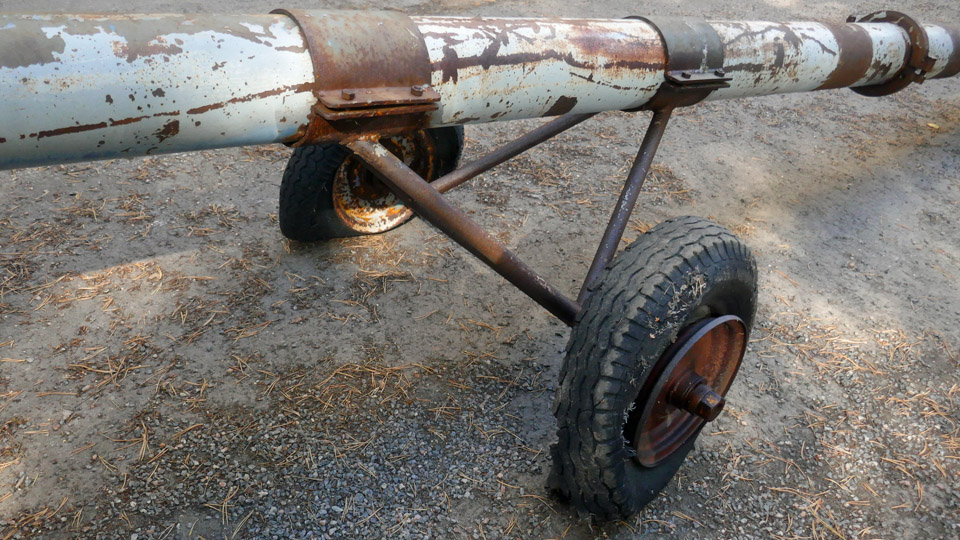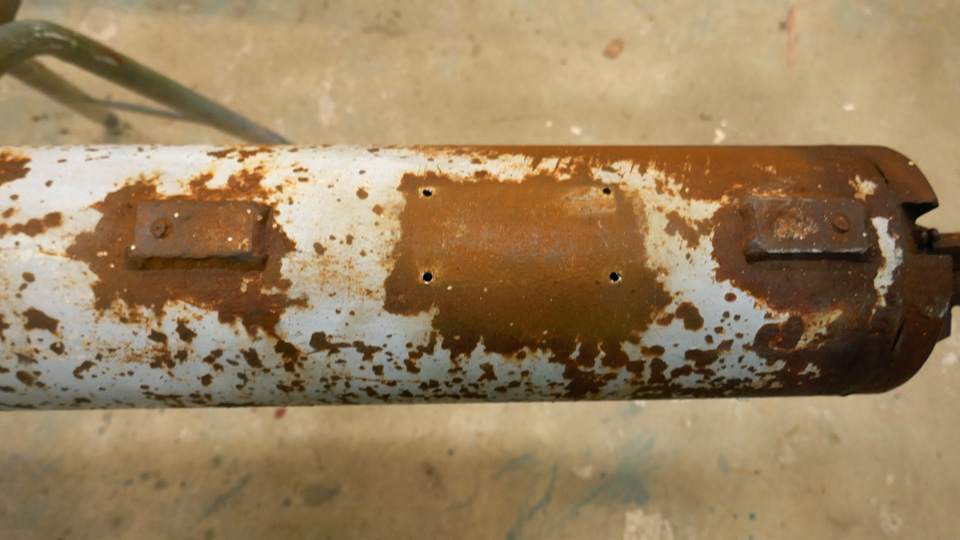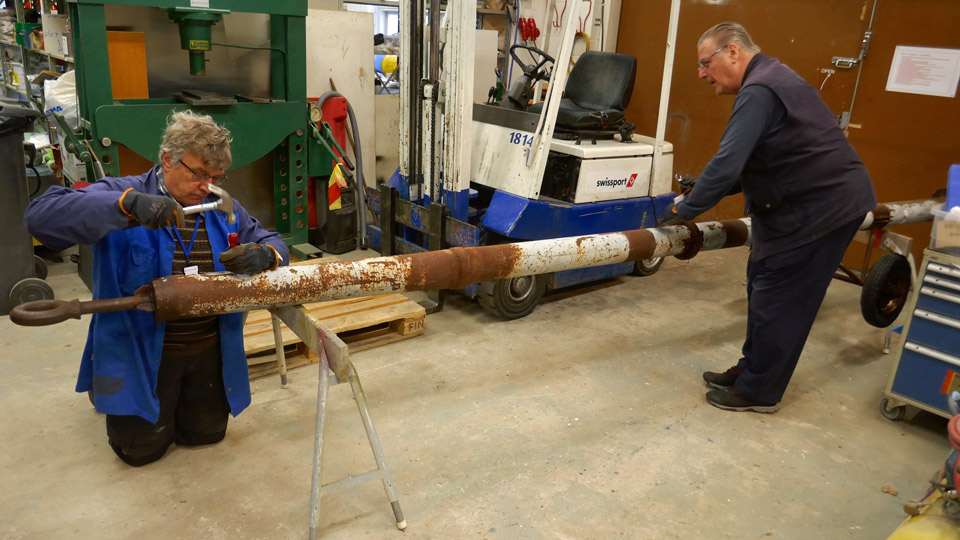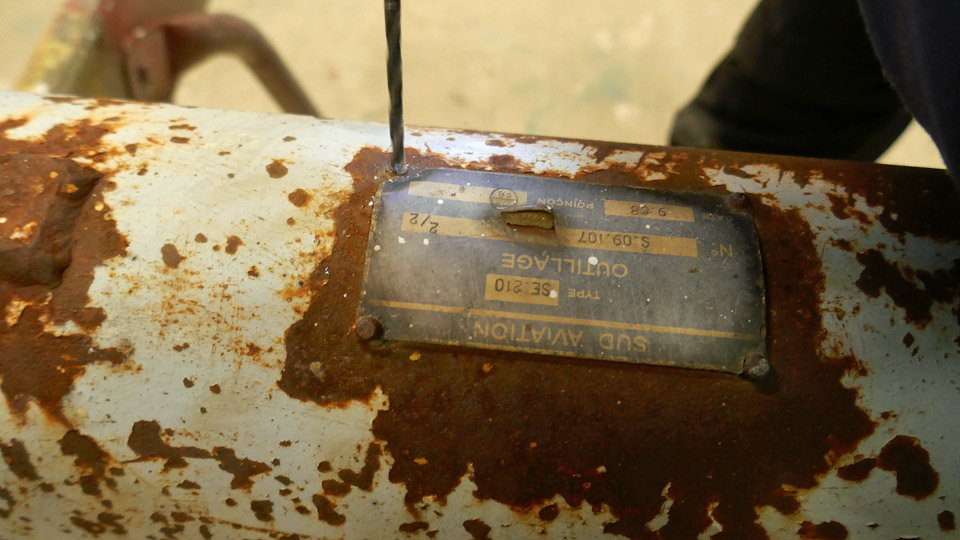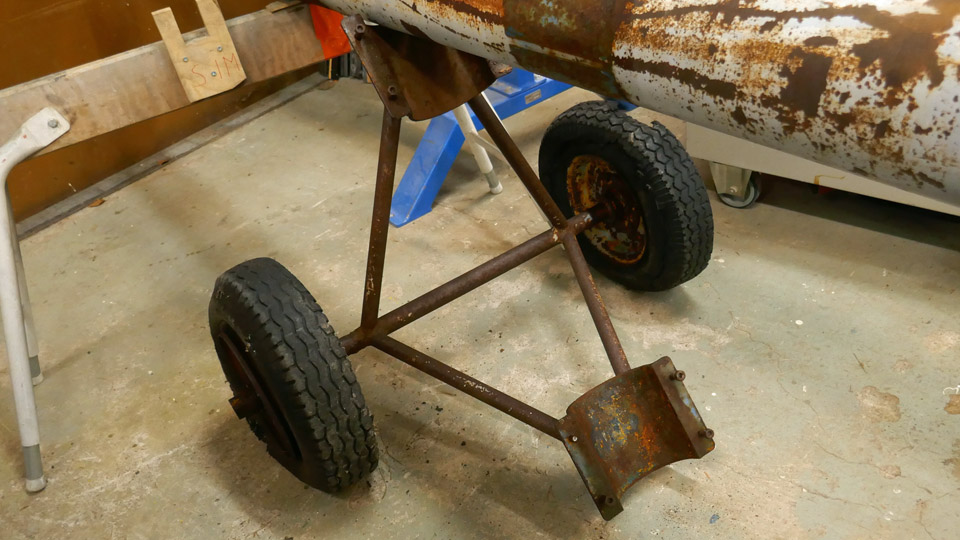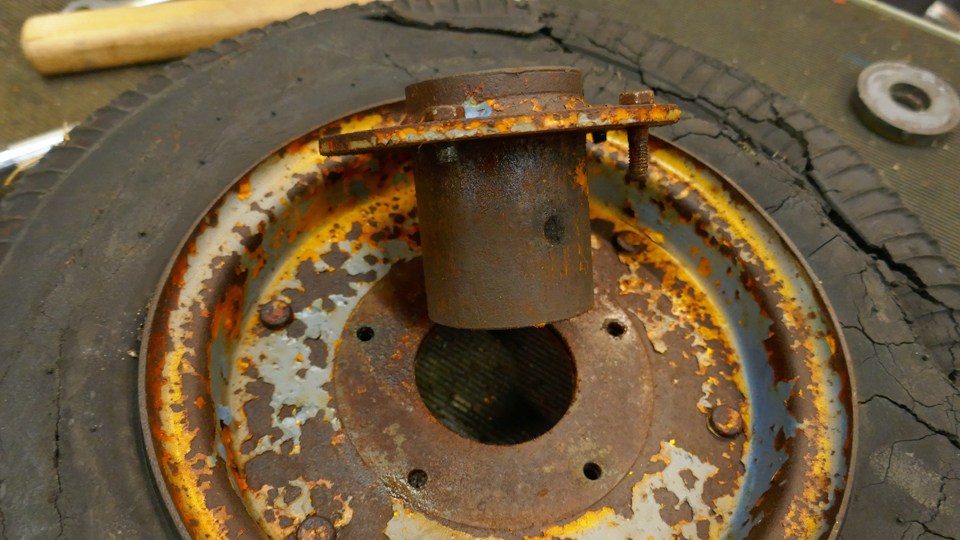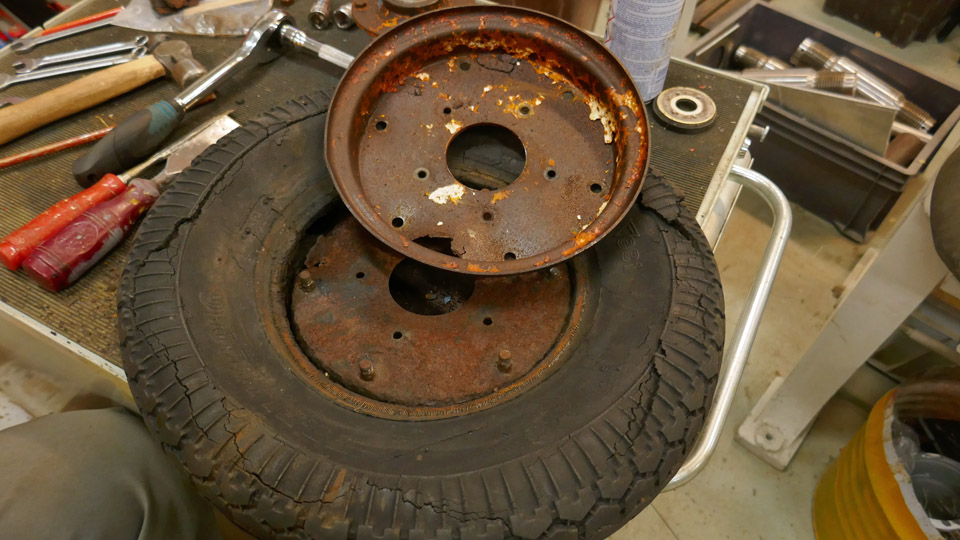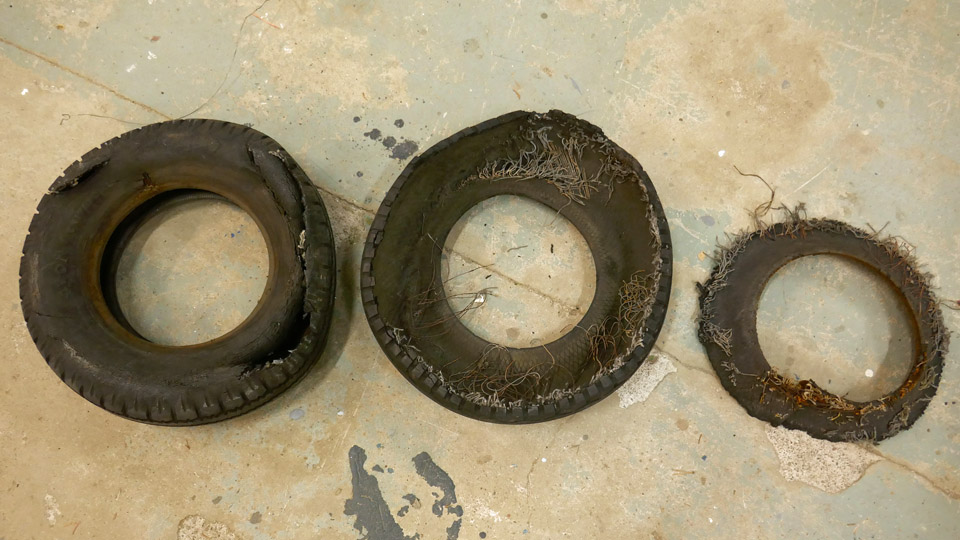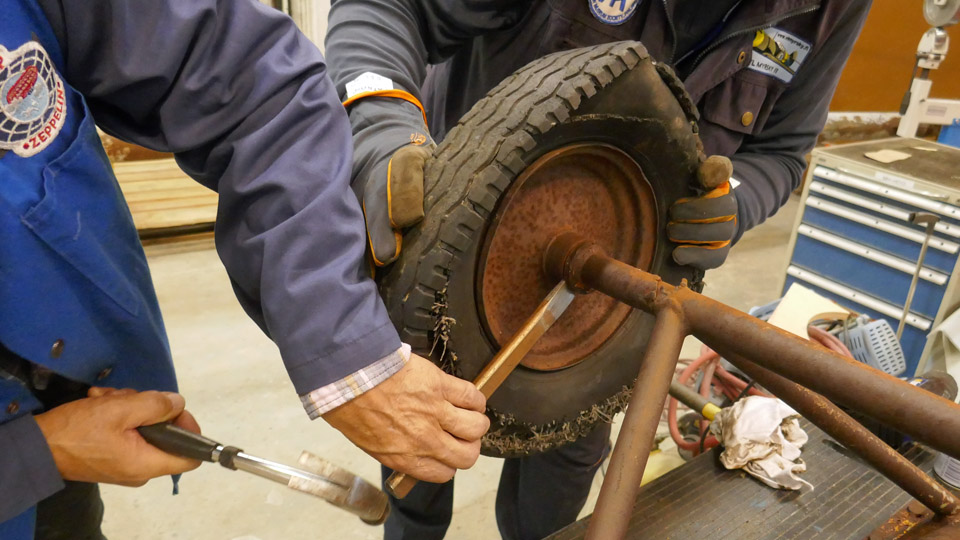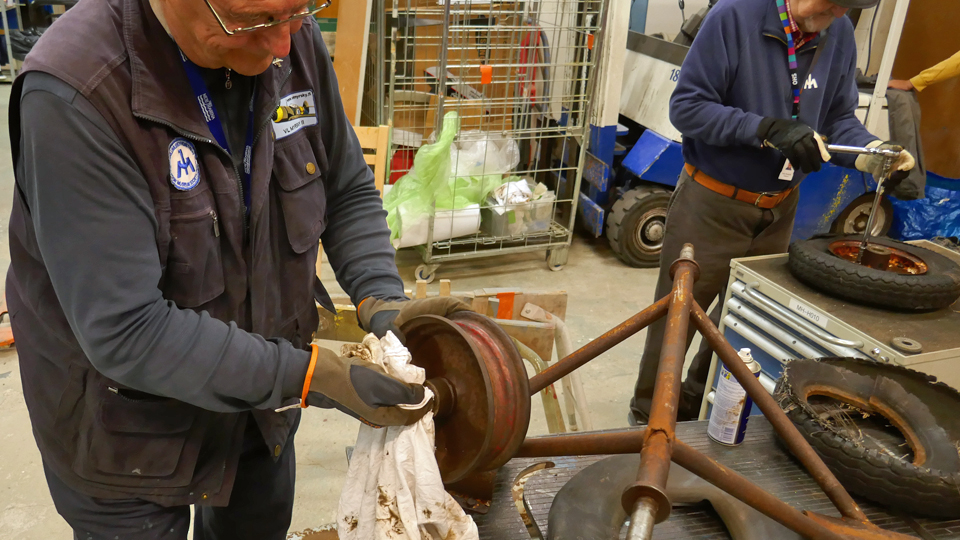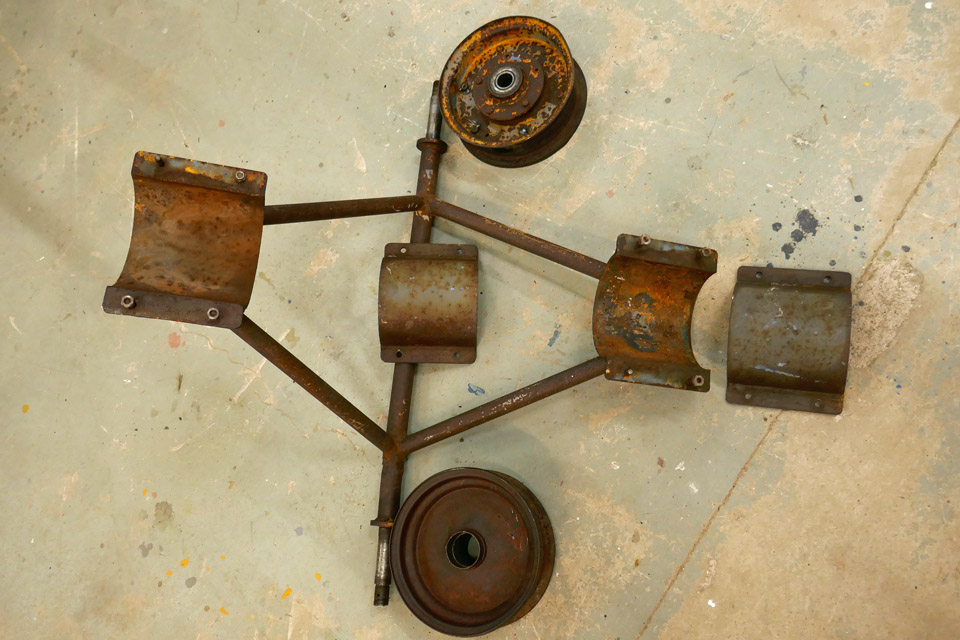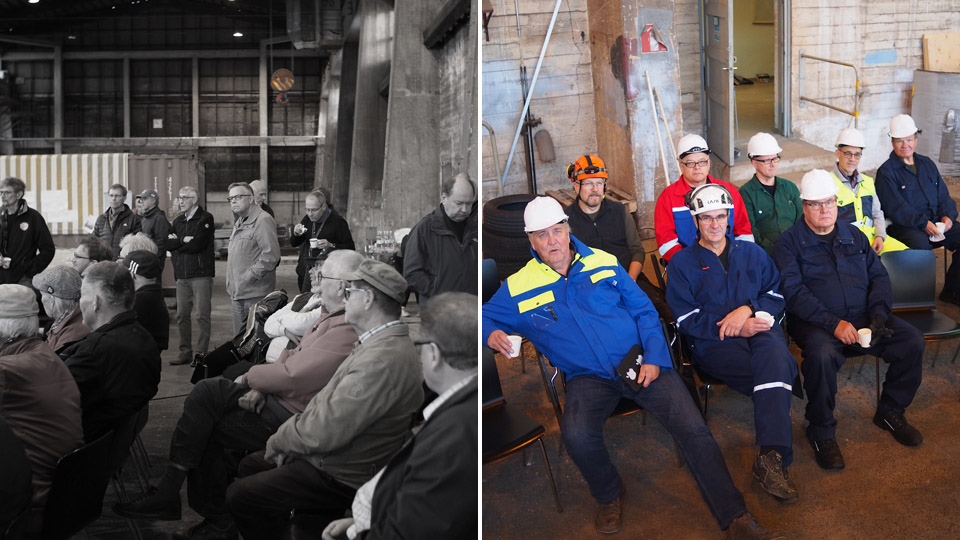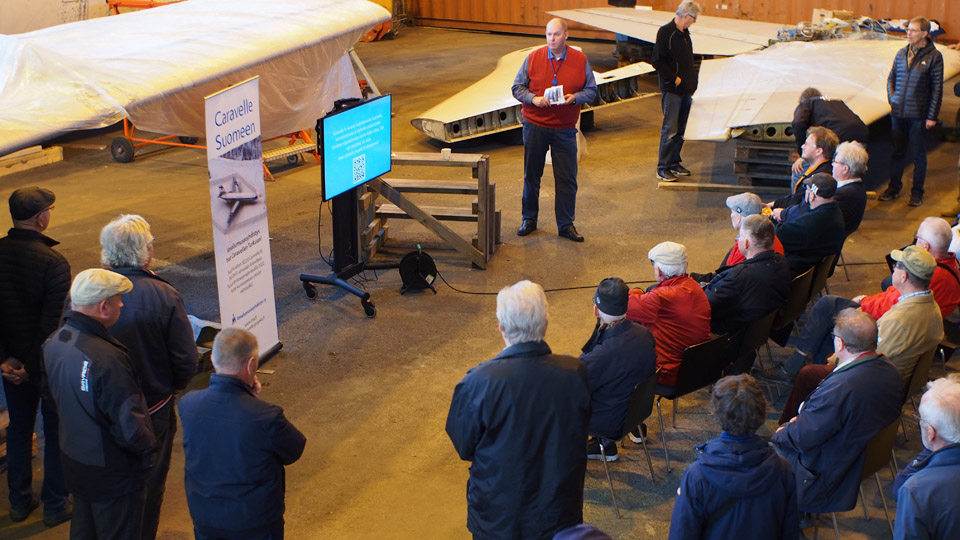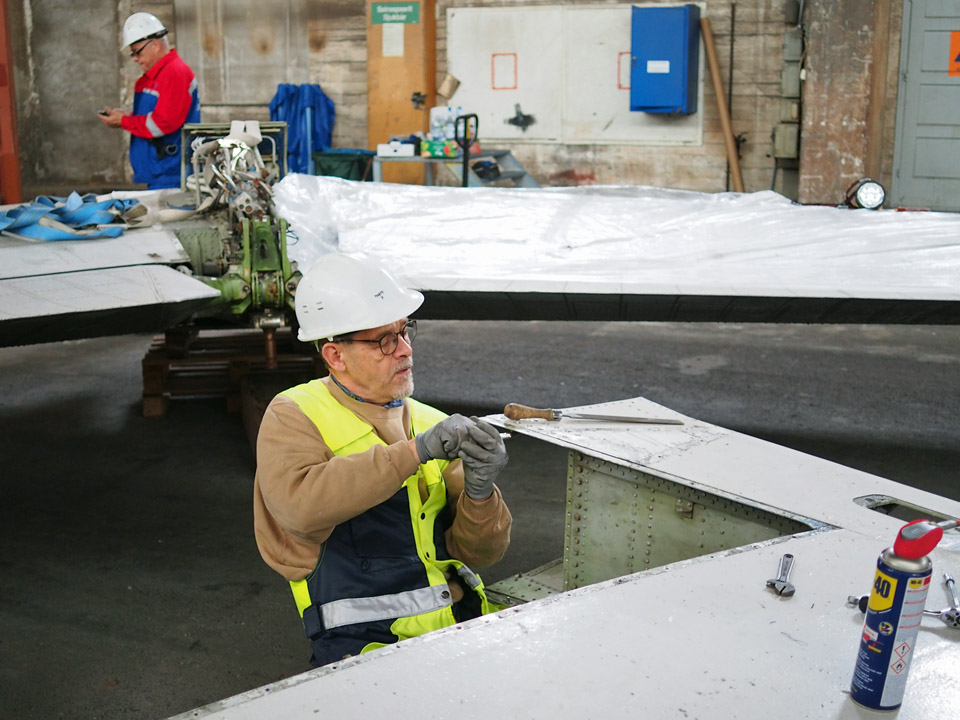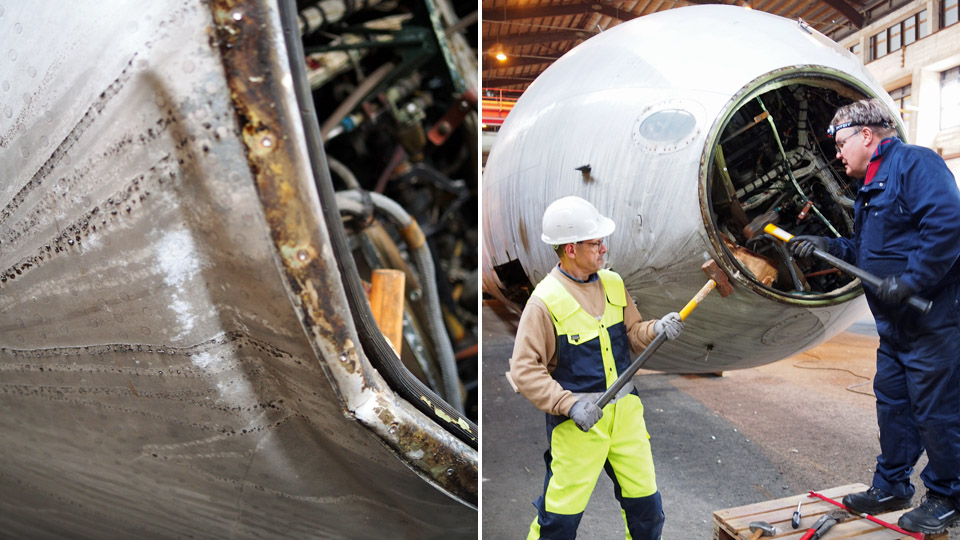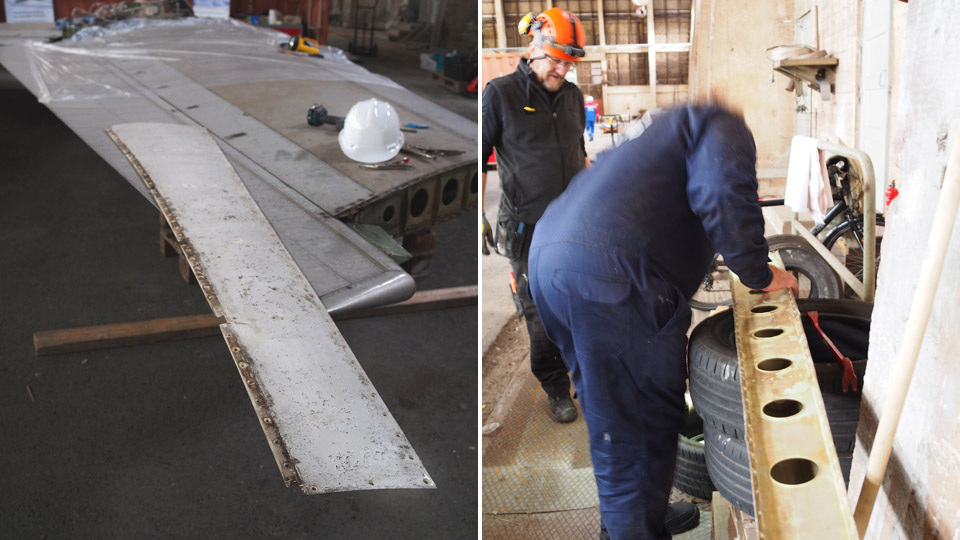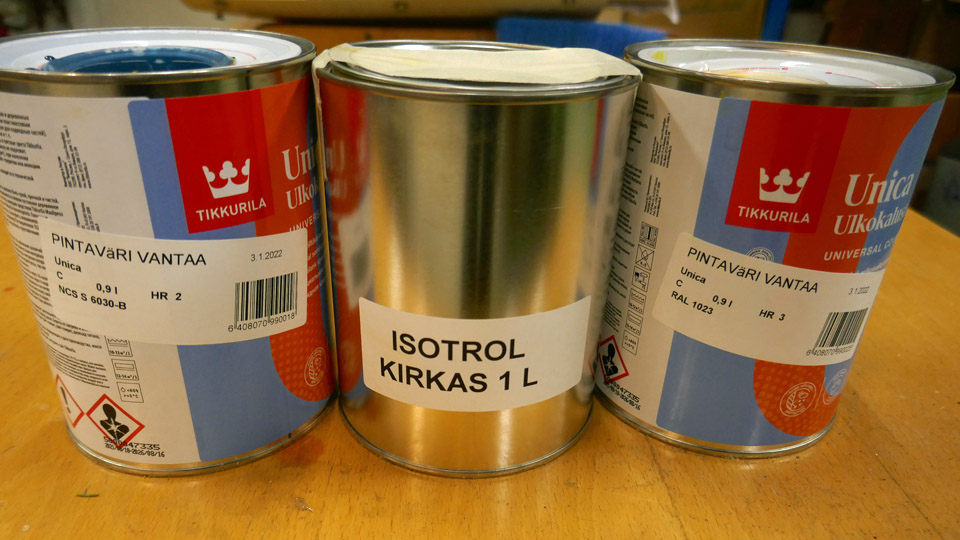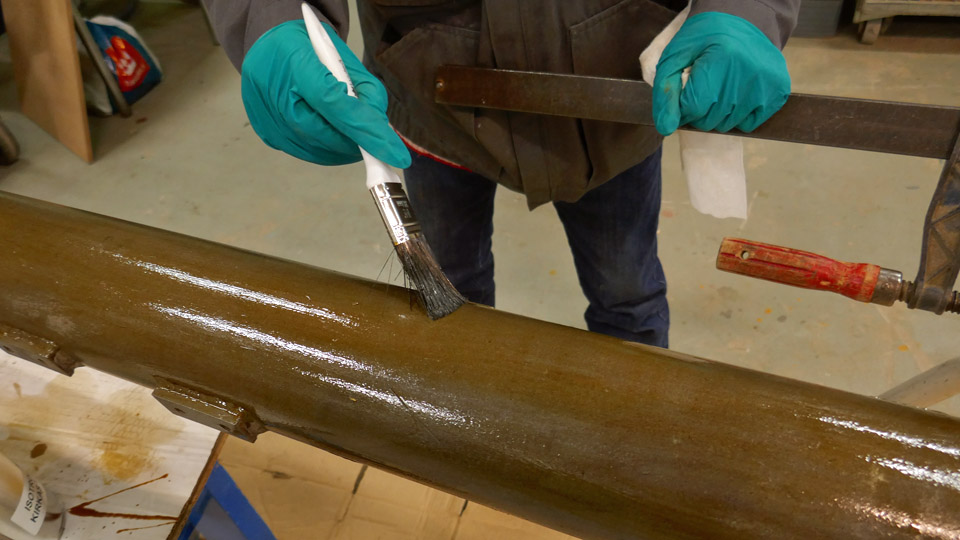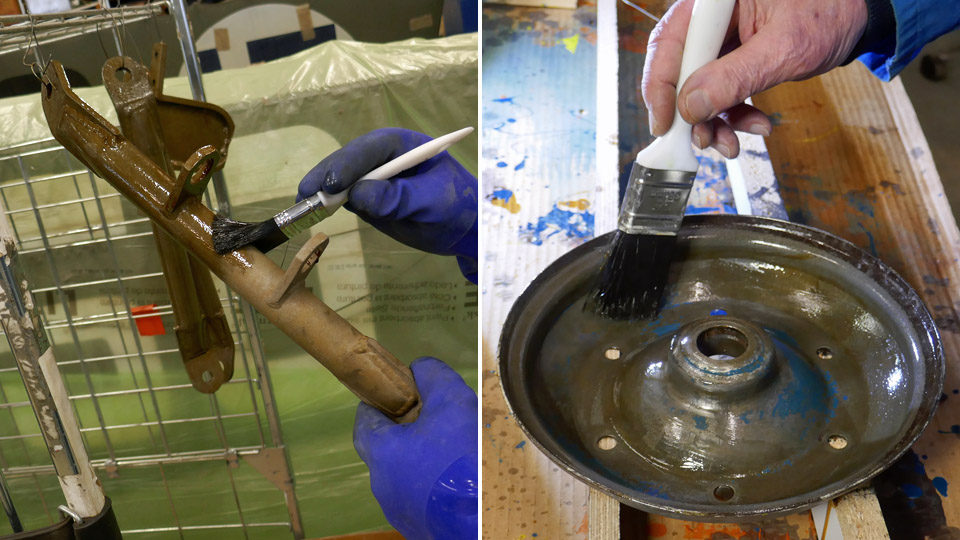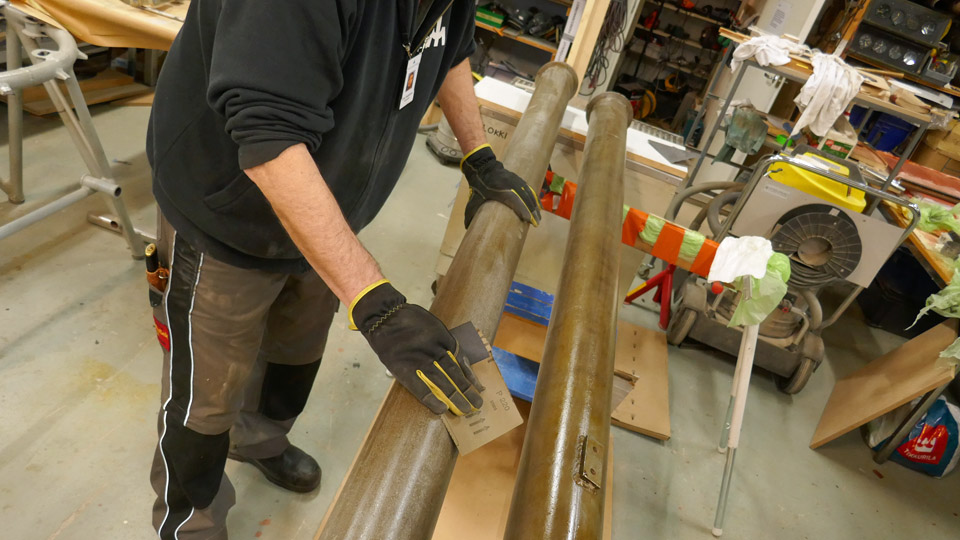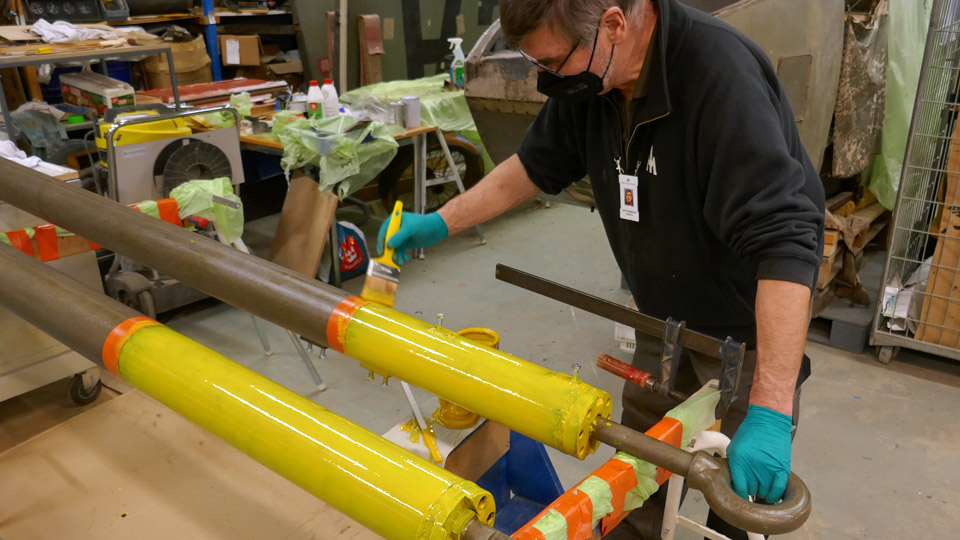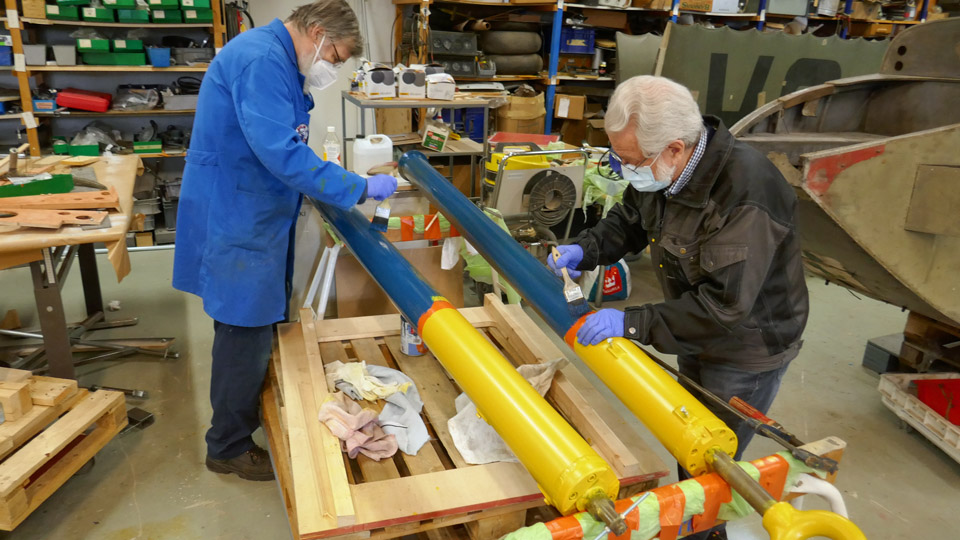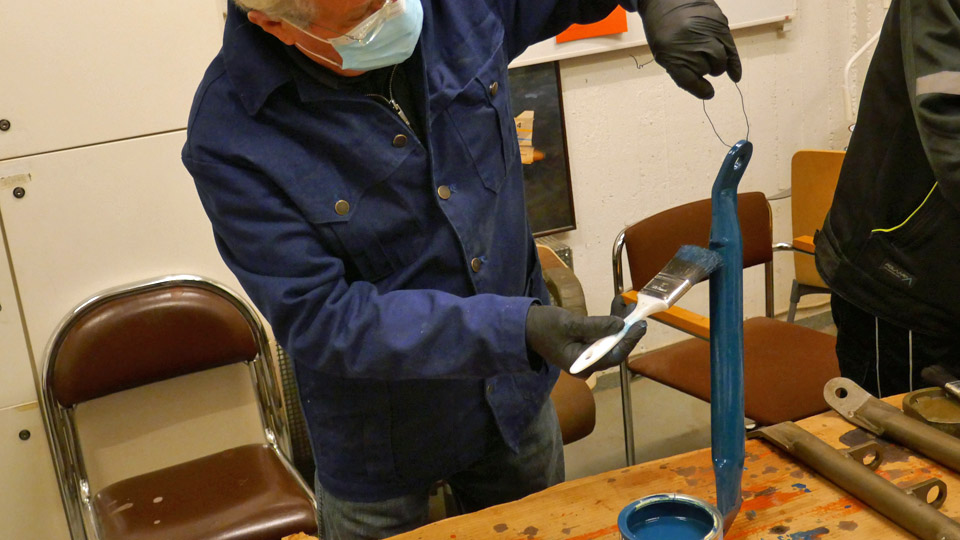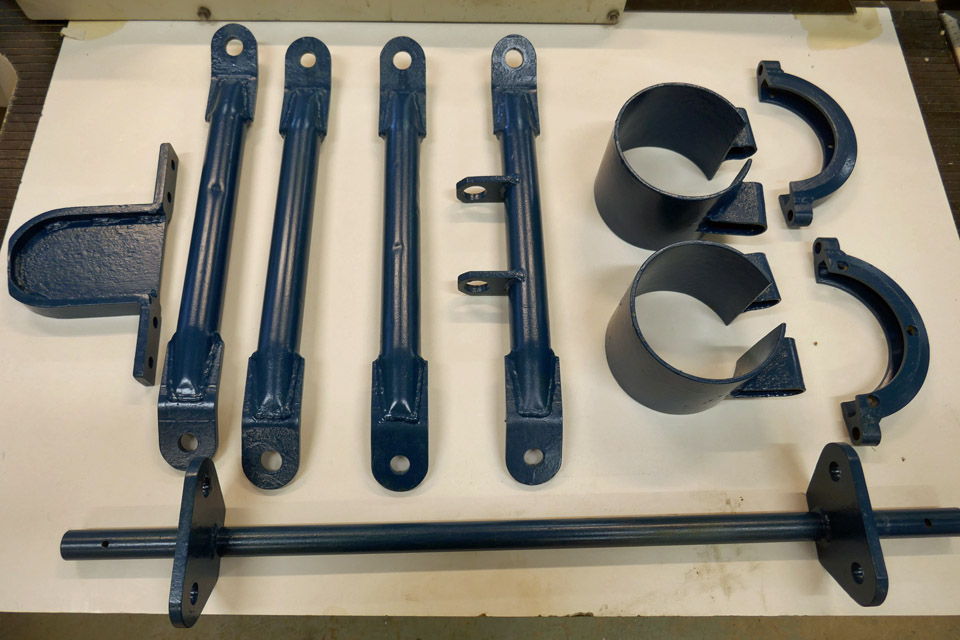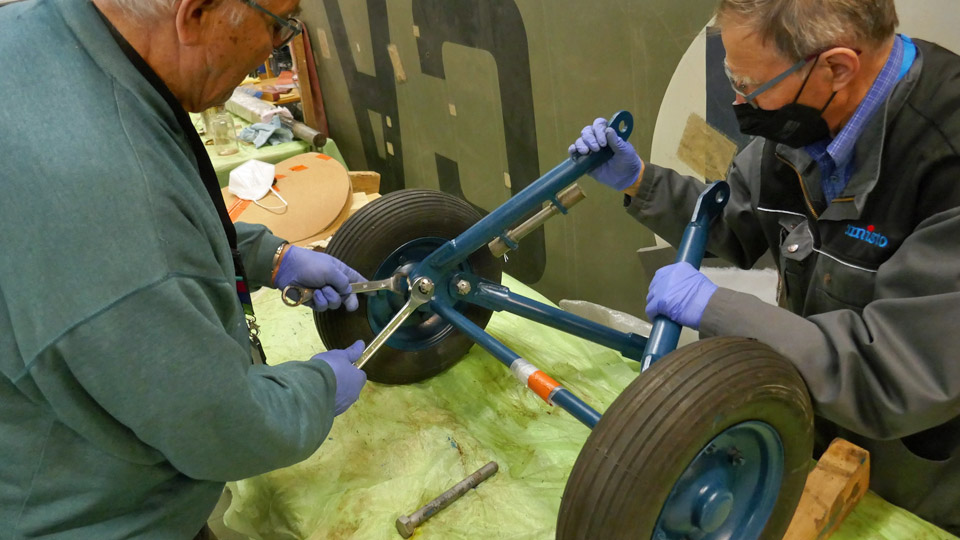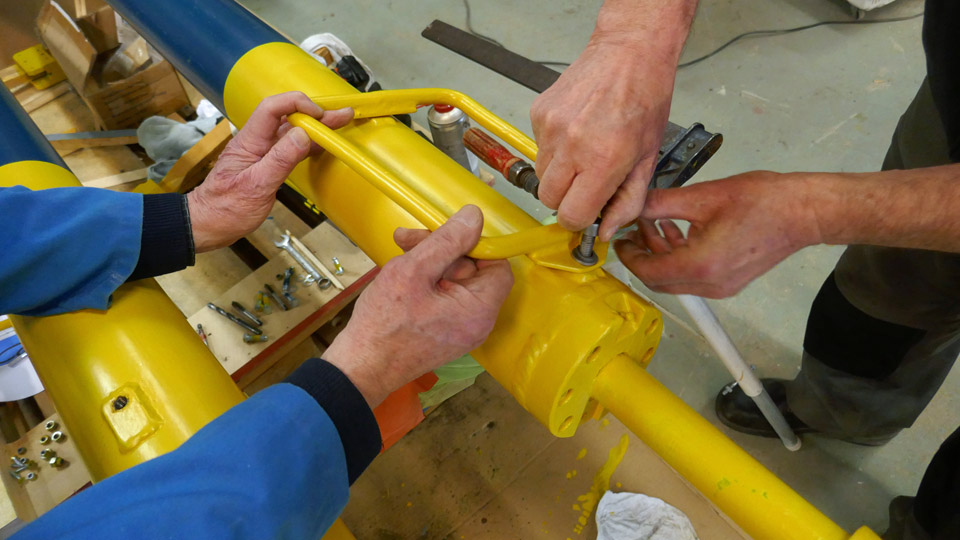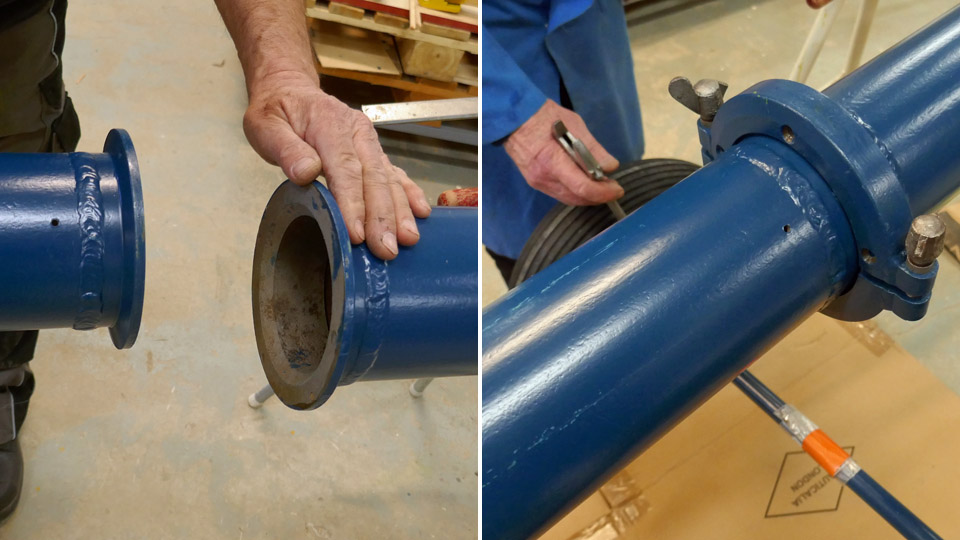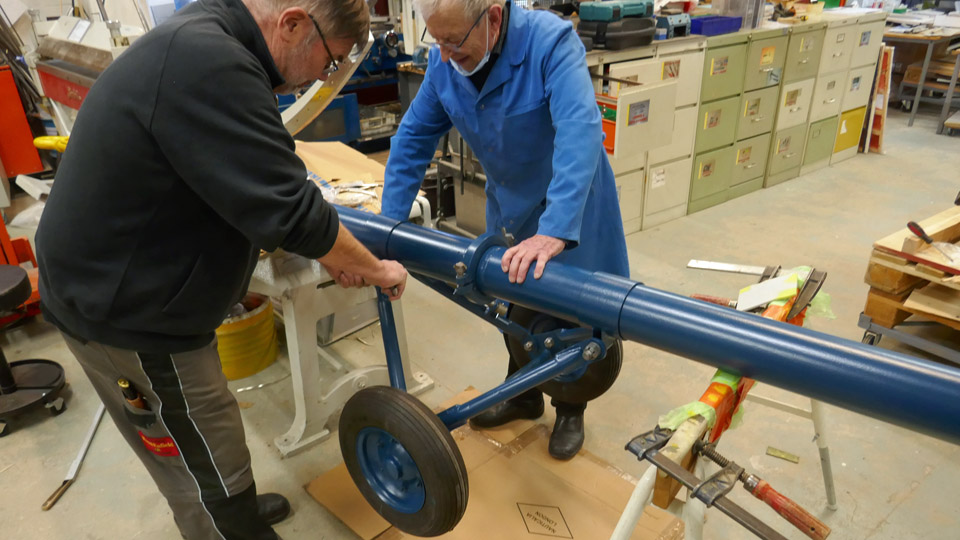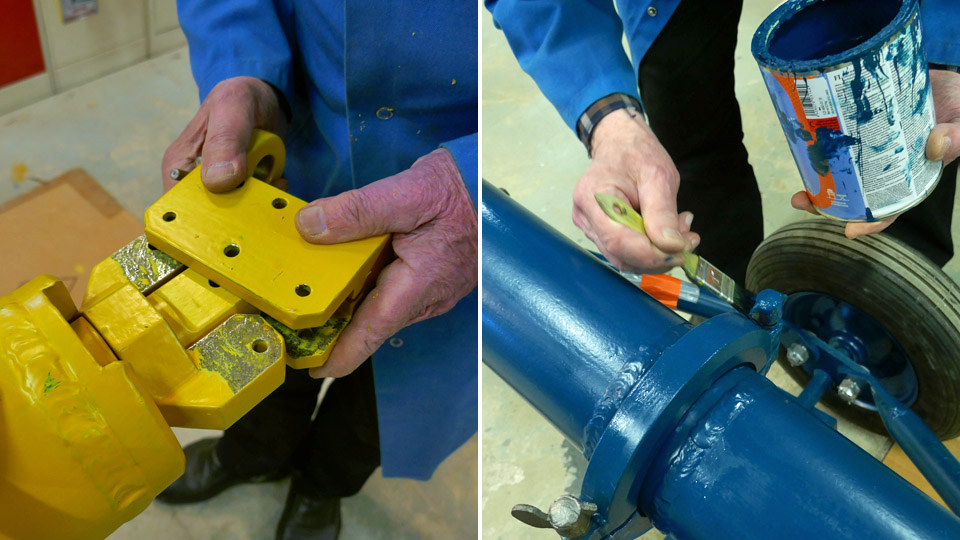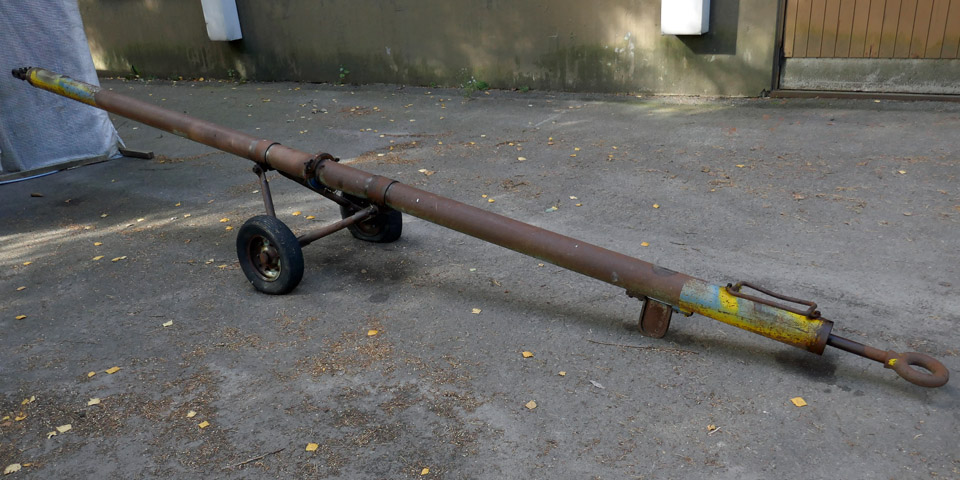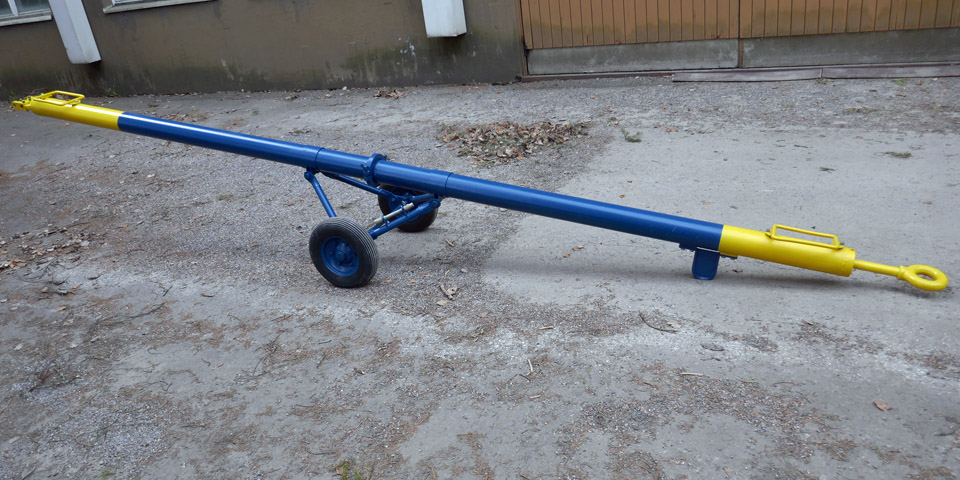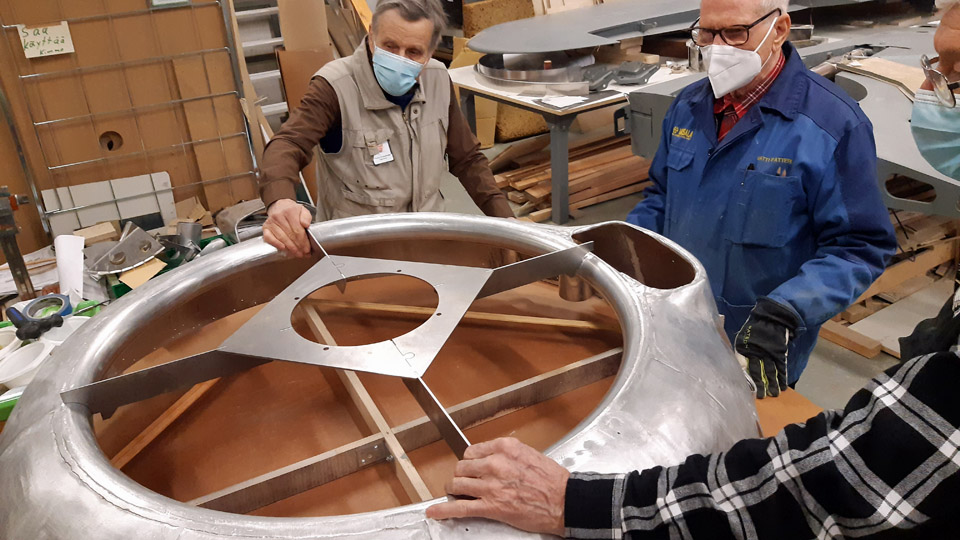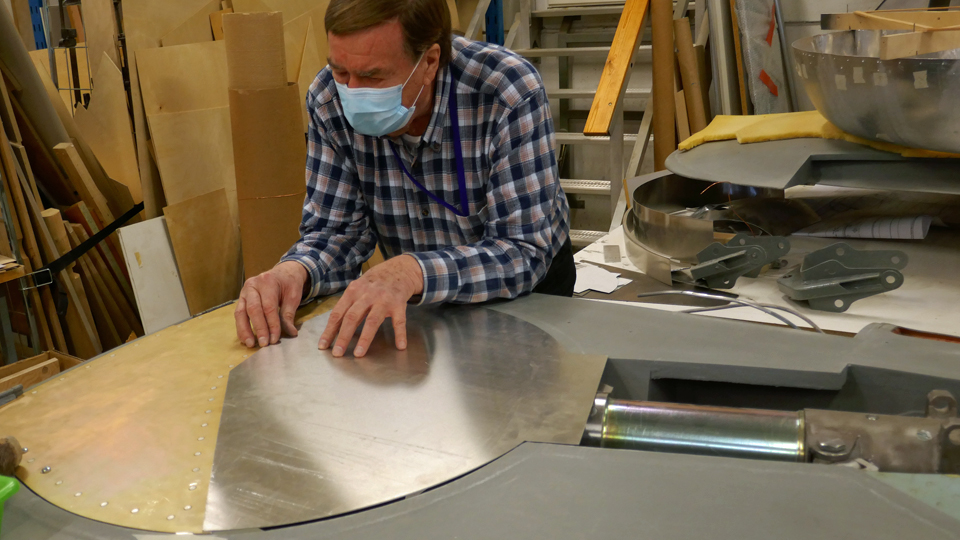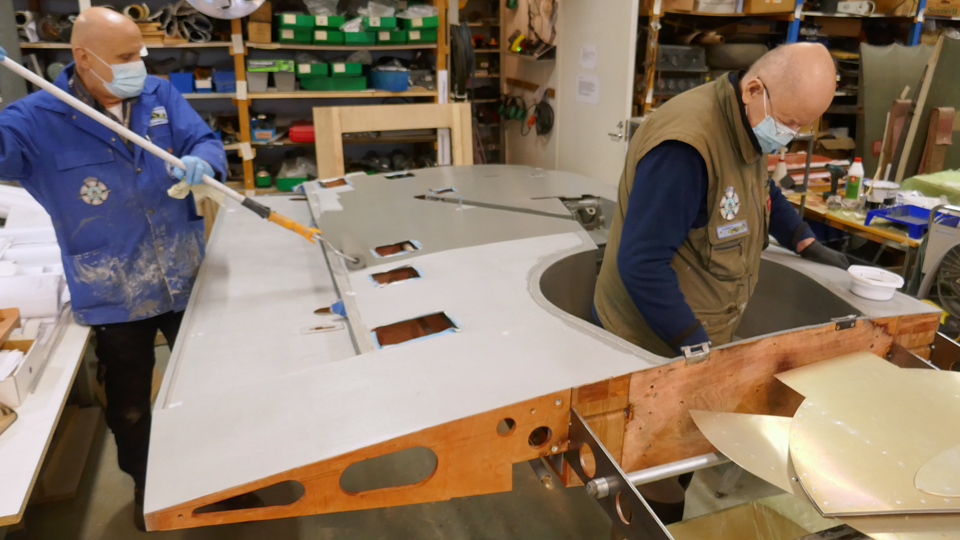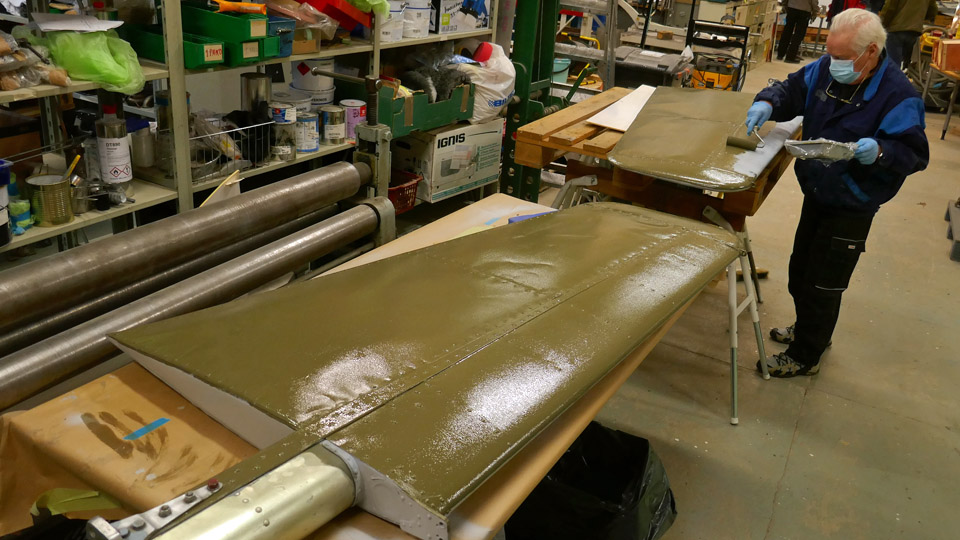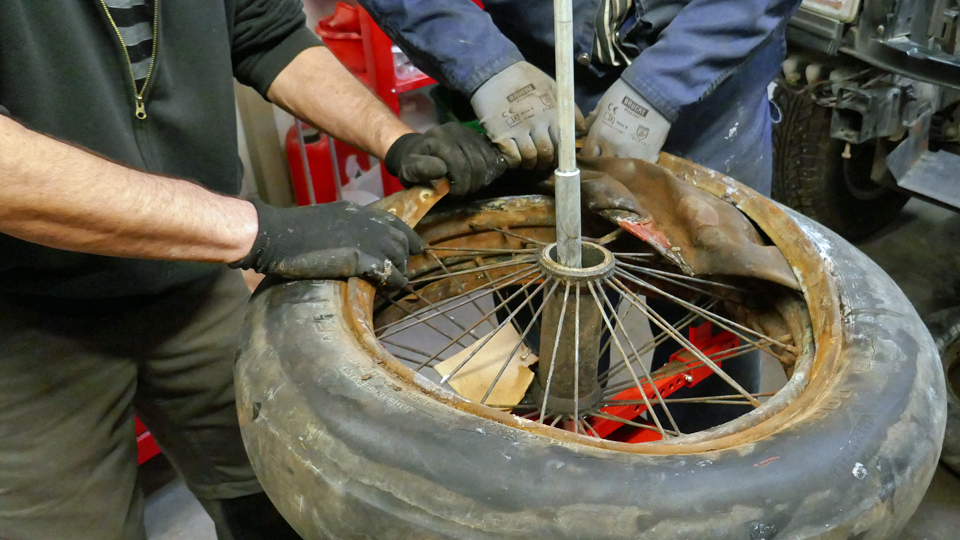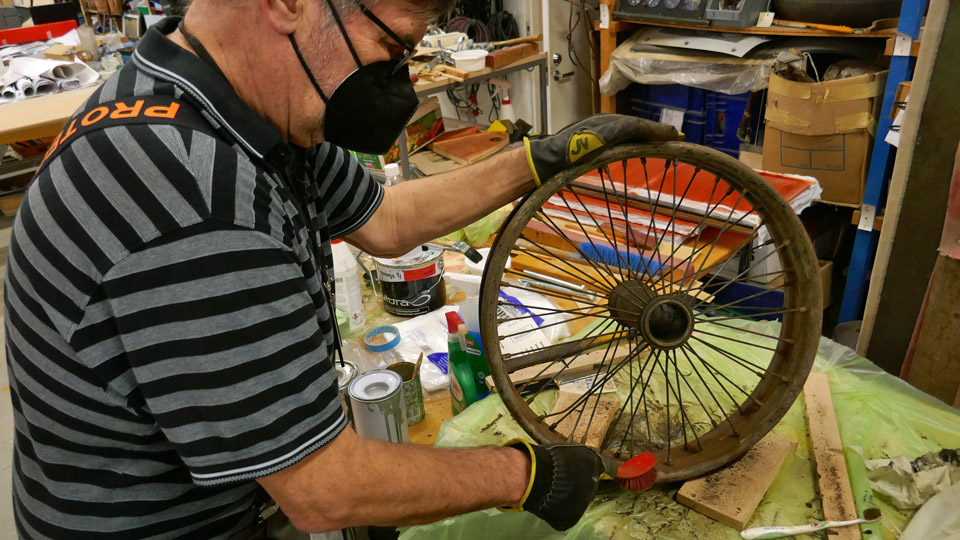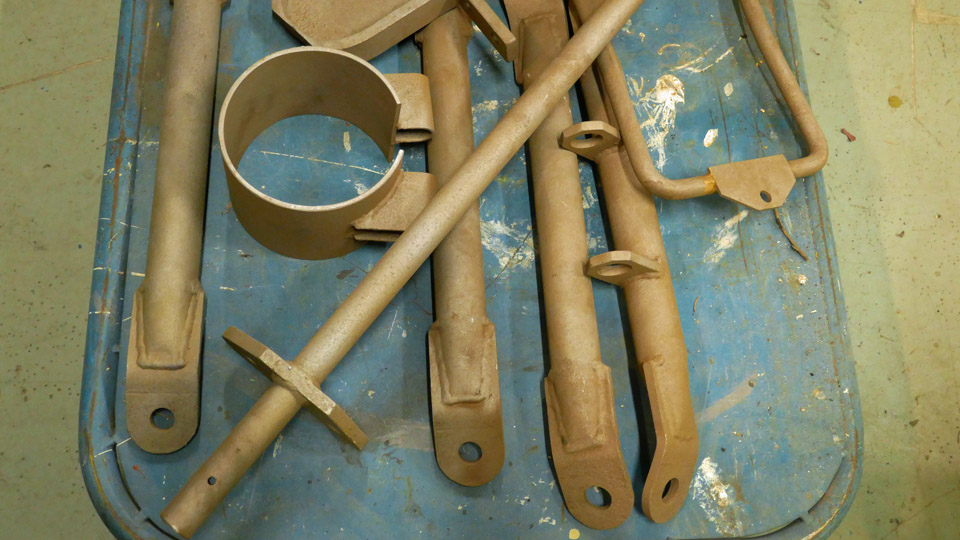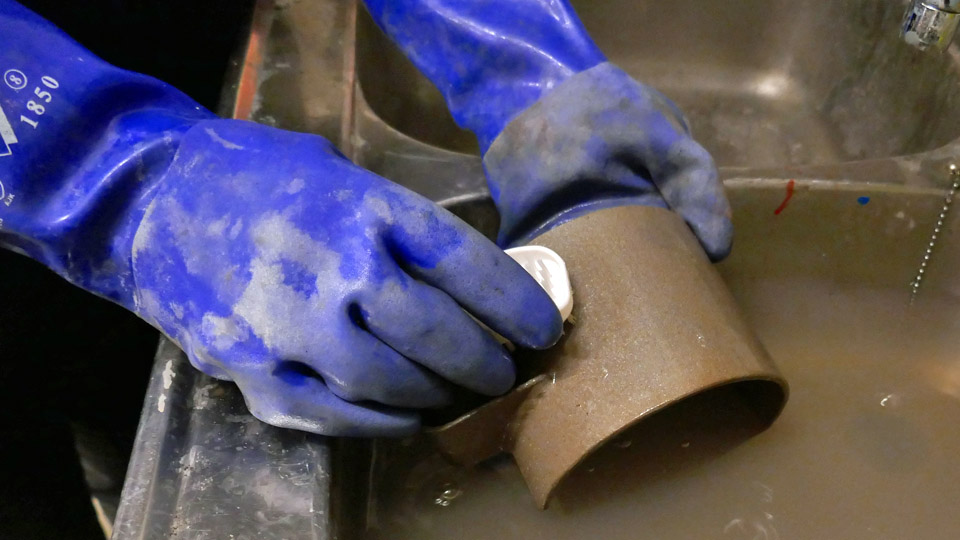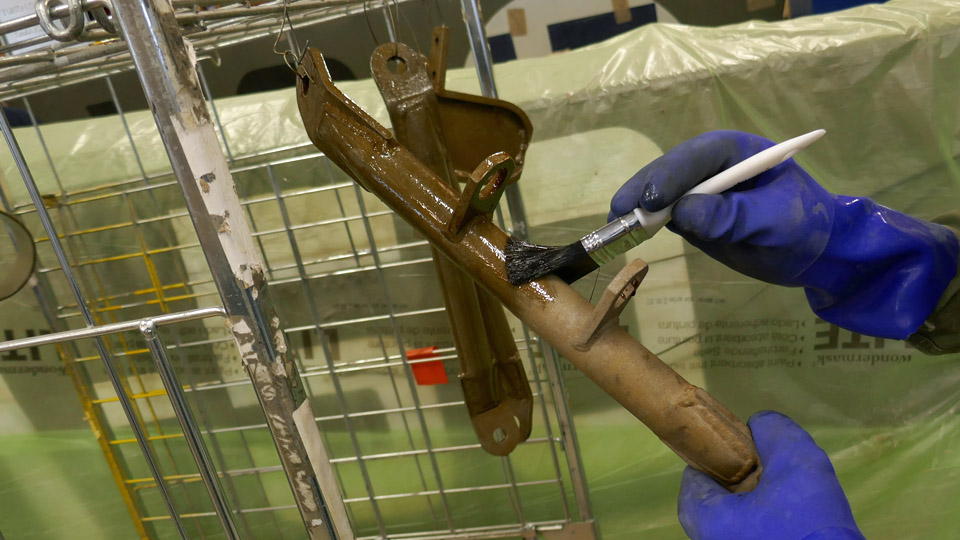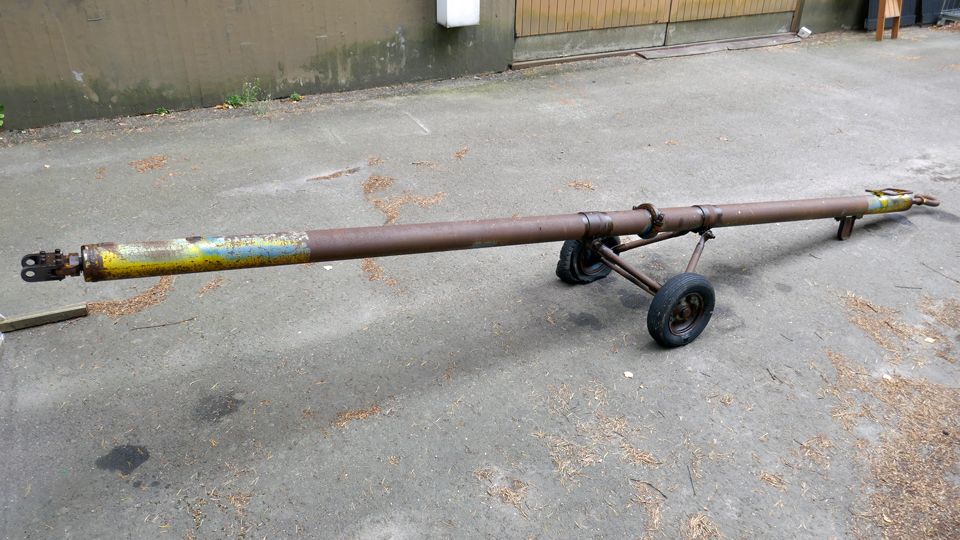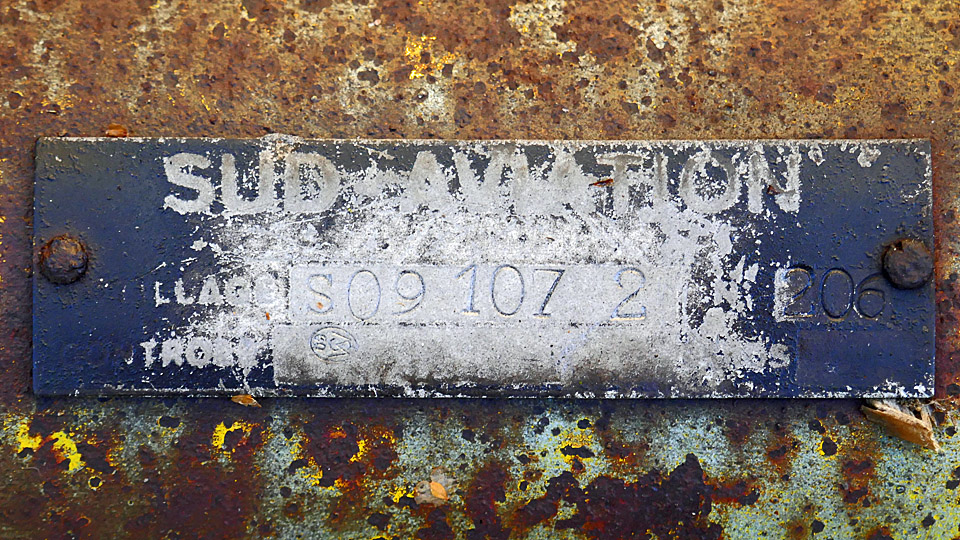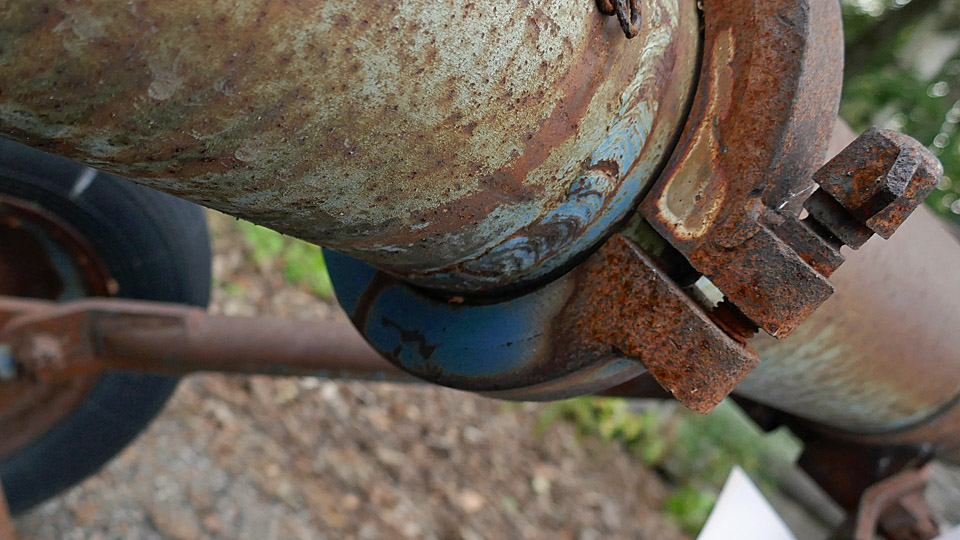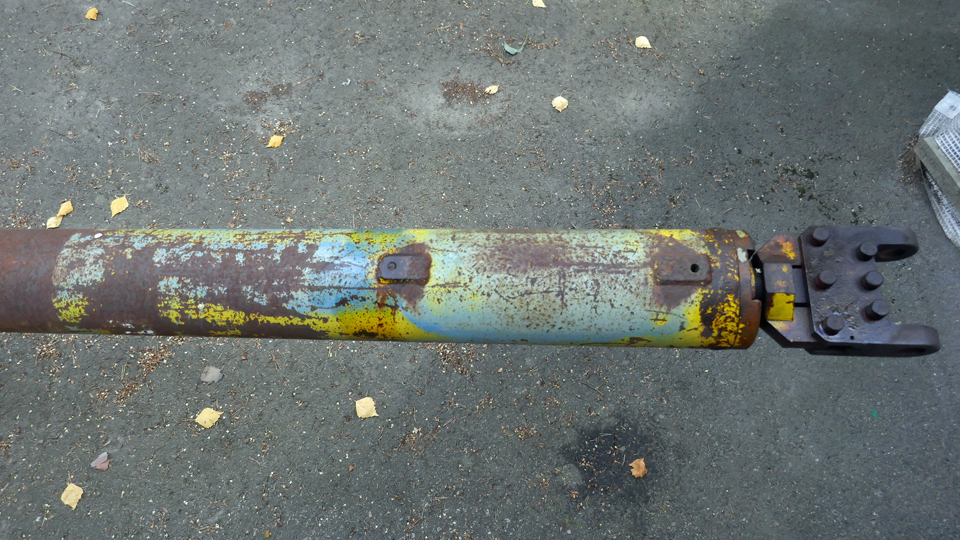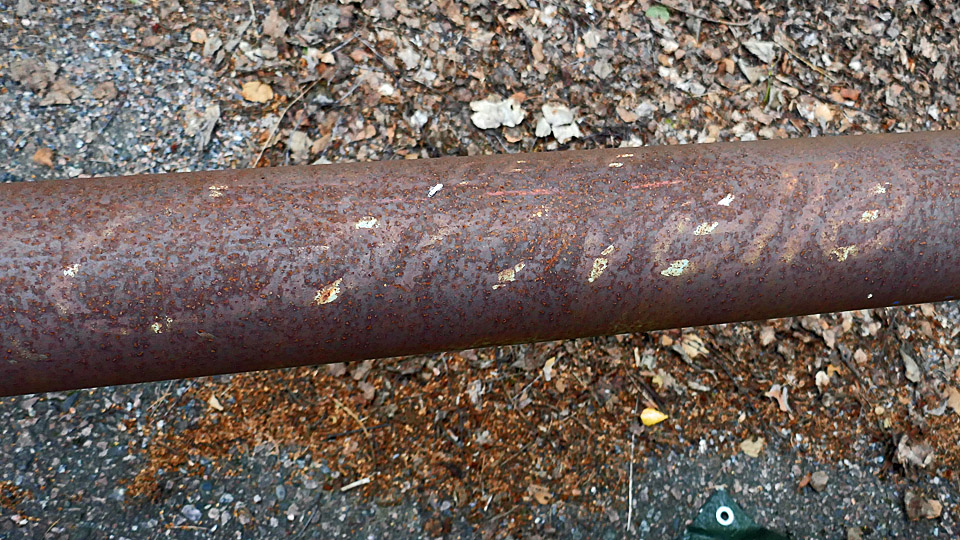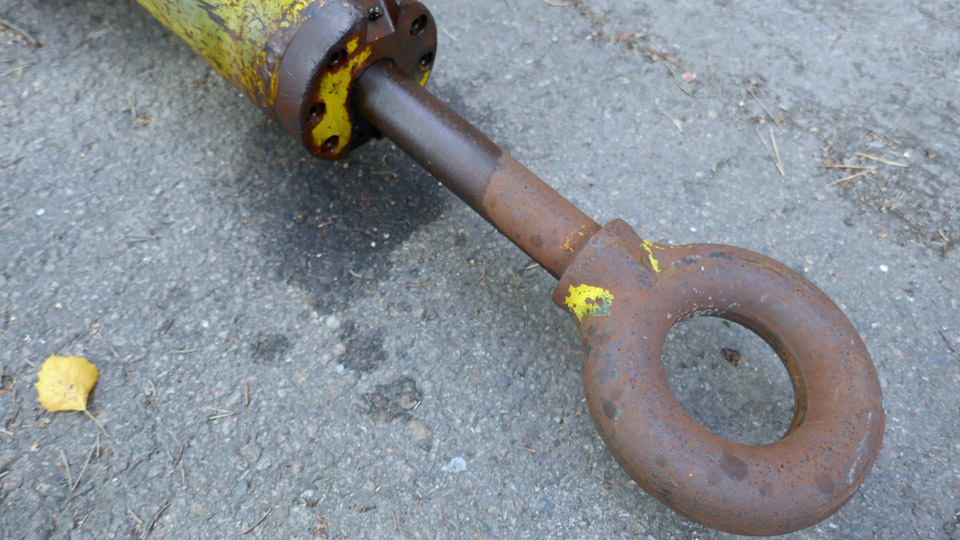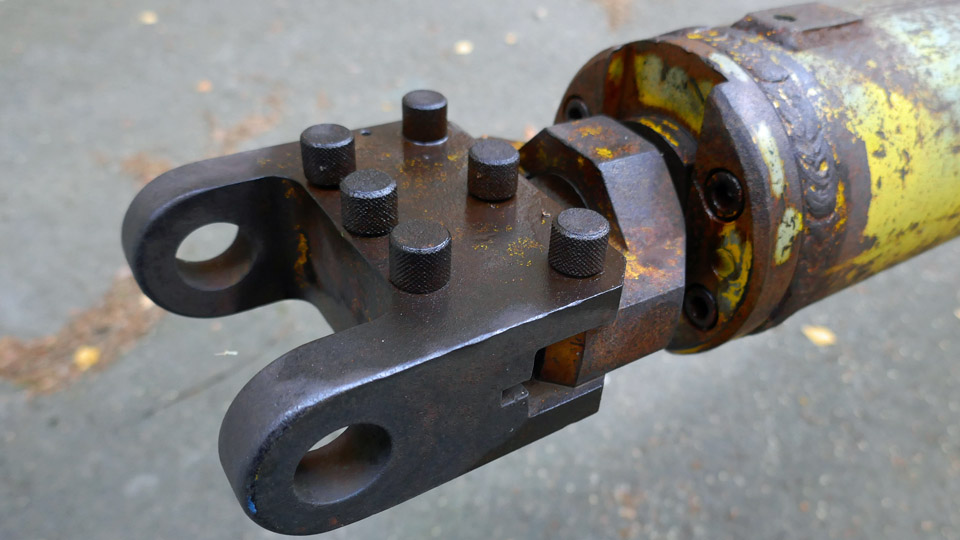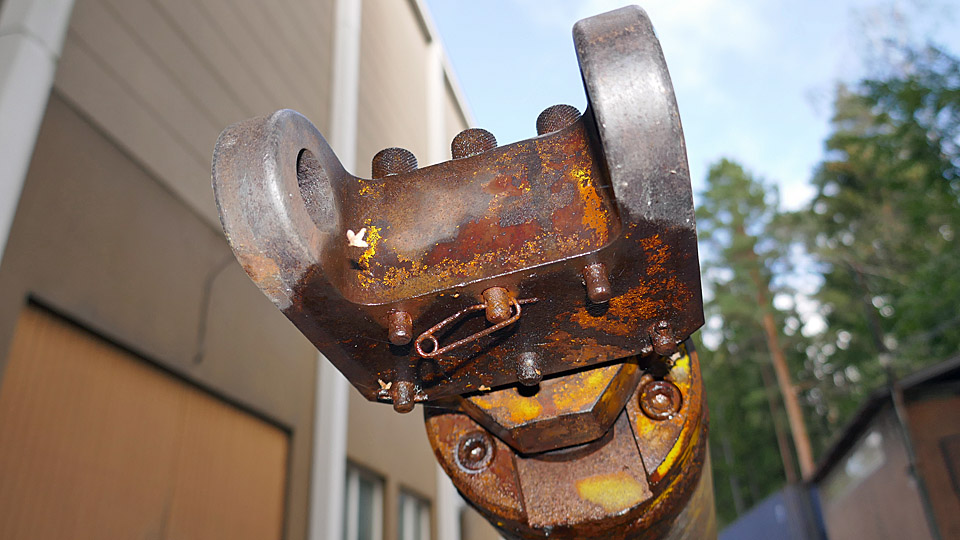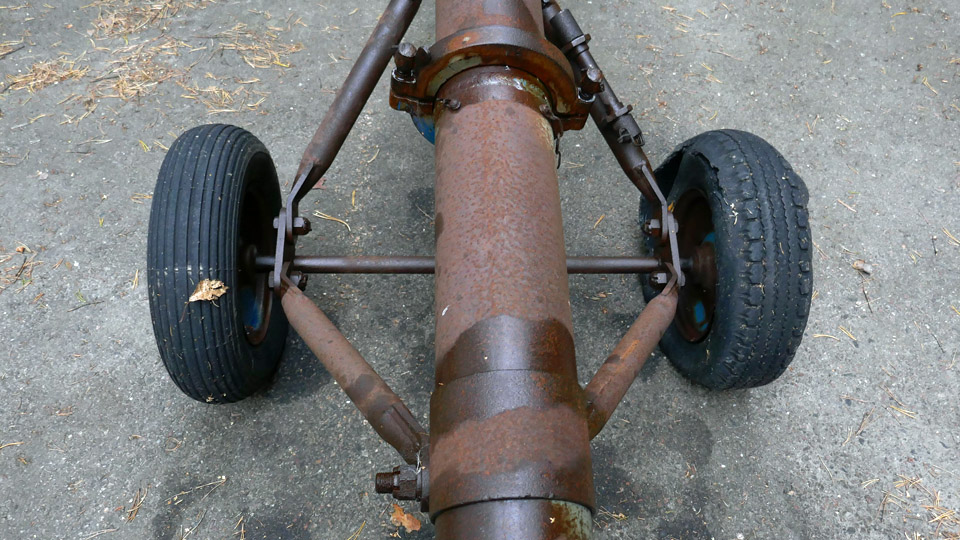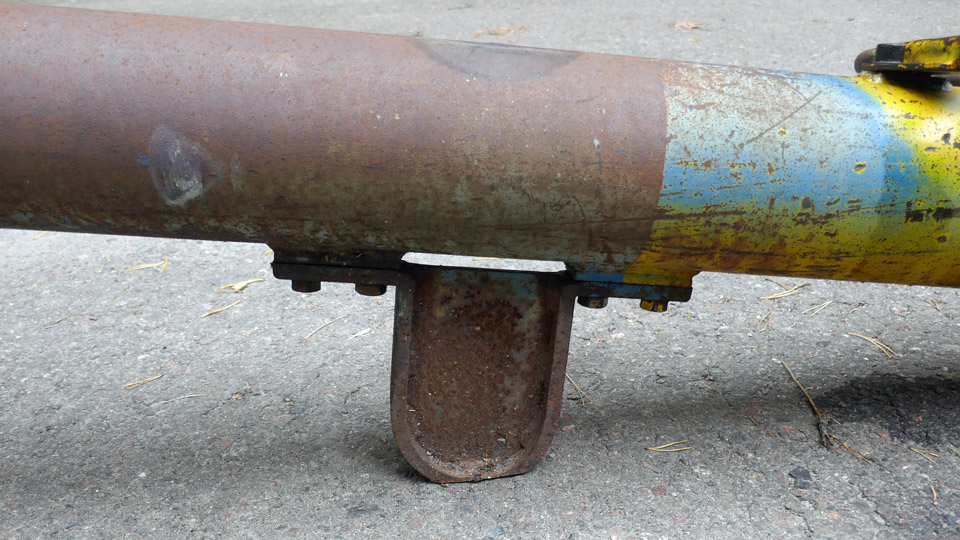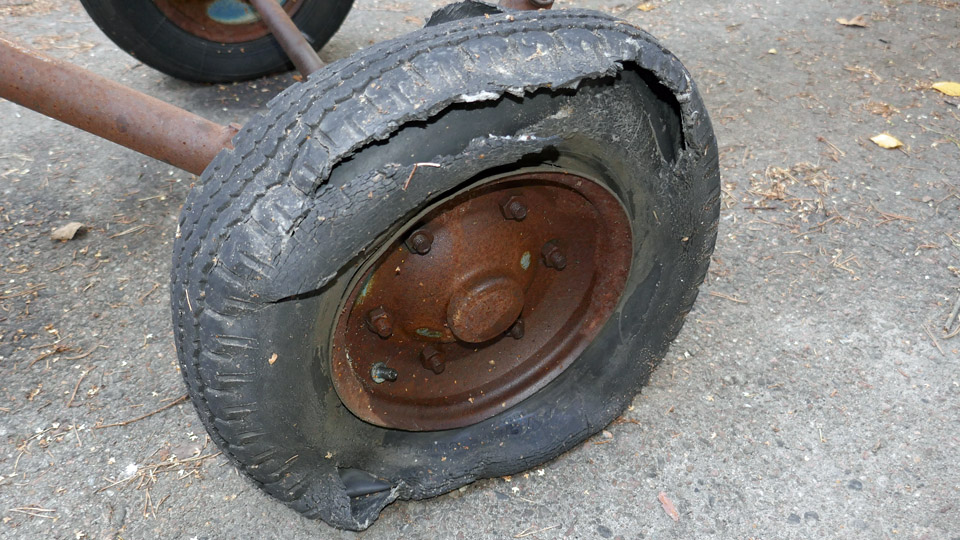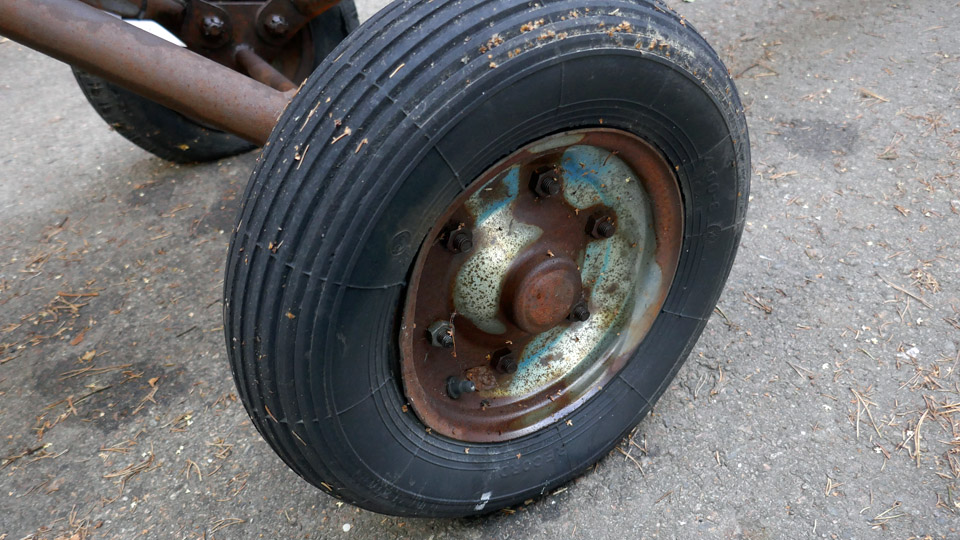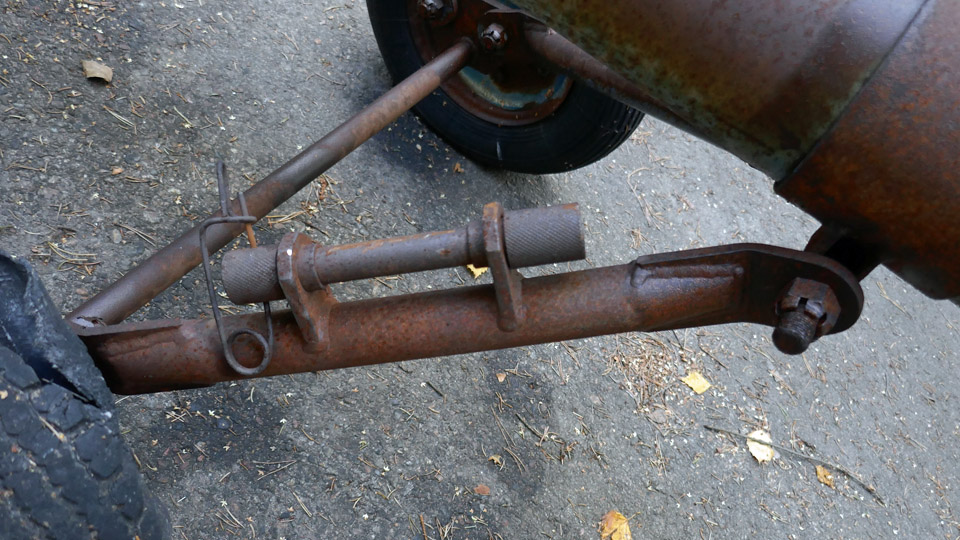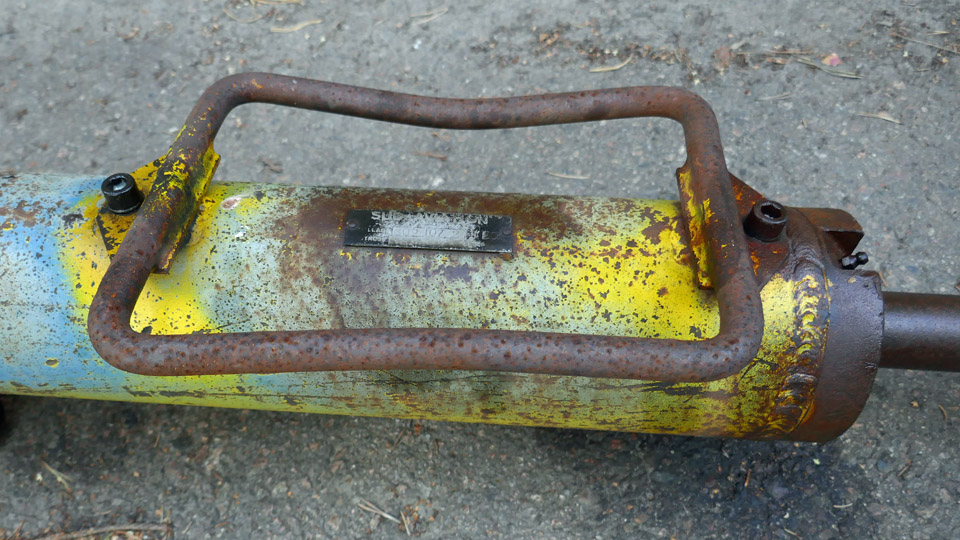Caravelle's inside worksMaanantai 20.3.2023 - Erja Reinikainen Last week the Caravelle’s sanding work progressed in Pansio, but also new work areas were started. The preliminary preparations inside the aircraft were started and the first experiments in painting are also under way.
Panels were dismantled from the wall between the cabin and cockpit. They were taken to the Tuesday Club in Vantaa to be cleaned and restored. In the cockpit the shading cover above the instrument panel proved very difficult to unfasten. A small part, but very tightly fastened.
The torn insulation material and its plastic covers hanging from the cabin ceiling were removed together with some tubes and wires hanging above the aisle. Some old and dry tape lines were removed from the cabin floor. A couple of kilos of small bolts, nuts and washers were vacuumed from the cabin floor. They have probably been used for fastening either the passenger seats or the cabin panels on the walls and ceiling.
Photo by Erja Reinikainen. Two maintenance panels in the cabin floor were opened to allow future work on the aircraft’s doors. Photos by Jouko Tarponen except if otherwise mentioned. |
|
Avainsanat: aviation history, restoration, Caravelle, SE-DAF, Sven Viking |
Caravelle SE-DAFSunnuntai 19.3.2023 - Jan Forsgren These blogs talk about the Sud Aviation Caravellle III SE-DAF. We think it is appropriate to tell something about what has happened to the SE-DAF before it arrived in Pansio to be restored. The original article “SE-DAF to Finland” about SE-DAF was written in English by Jan Forsgren / Arlanda Flygsamlingars Vänner, the summary has been edited by Erja Reinikainen. The whole article was published in Aviation Museum Society Finland’s aviation history magazine Feeniks, 3/2022. One of the first operators, and, in fact, the first airline to use the Caravelle in regular service was Scandinavian Airlines Systems (SAS). In SAS service, the Caravelle proved to be extremely popular among crews and passengers alike. Between 1959 and 1974, SAS operated on the European and Near East routes a total of 21 Caravelle I, IA and III variants. The Caravelle I and IAs were later modified to Caravelle III standard. The fifteenth Caravelle III SAS purchased has the serial number c/n 112. After roll-out from the Sud Est factory at Toulouse, Caravelle III c/n 112 was temporarily registered as F-WJAO prior to the first flight on February 8th, 1962. On February 17th, 1962 the Caravelle was flown to Arlanda airport just north of Stockholm. On March 5th, 1962, it was registered as SE-DAF for AB Aerotransport (ie the Swedish part of SAS). Later the same month, the aircraft was named Sven Viking. Most of the SAS Viking names used were of historical individuals from the Viking era. Sven was Sven Haraldsson, better known as Sven Tveskägg (in English; Sweyn Forkbeard). He ruled Denmark, southern Norway and England around year 1000 AD.
Photo by Wikimedia Commons.
Photo by Wikimedia Commons. Taken in December 1964.
Photo by Lars Söderström via Wikimedia Commons. Taken in 1966. When Flygvapnet (the Swedish Air Force) bought two Caravelles from SAS in 1971, it had originally been planned to buy a third aircraft as well for use in the personnel transport, and as (later on) a source for spares. As it was only possible to take Swedish-registered Caravelles into consideration, this third Flygvapnet Caravelle was to have been SE-DAF. However, for various reasons, SE-DAF remained with SAS.
Photos via Wikimedia Commons. Taken in 1971 on Oslo Fornebu Airport. The 1973 oil crisis saw a rapid increase in fuel prices. With the Avon engines being very ’thirsty’, the SAS Caravelle fleet was withdrawn from use earlier than originally planned. The last flight of SE-DAF, between Copenhagen and Arlanda, took place on September 23rd, 1974, with the registration SE-DAF being cancelled on December 3rd, 1974. A total of 27 321 hours were logged.
Photo by Peter Bakema via Wkimedia Commons. Taken in 2004. After being withdrawn from use, SE-DAF was donated to Luftfartsverkets historiska samlingar (The Swedish CAA Historical Collection). The engines were removed, with the cabin seats and interior also being largely removed. Some of the cockpit instruments were also removed. A preservative coat of Tectyl was then applied to the fuselage to prevent corrosion. Originally parked at Ramp Kalle, the Caravelle was later towed to Ramp Ivar, which was located outside the security area. It is believed that the damage to the right wingtip was sustained when towed to Ramp Ivar. Members of AFV took care of filling air in the tires every sixth month, as well as moving about 30 cabin seat frames (mainly from Caravelle 10B1R SE-DEC) into the cabin. However, a multitude of other projects, as well as a constant lack of resources, meant that no proper work in restoring the Caravelle to her former glory could be accomplished.
Photo by Juha Klemettinen. Taken in 2011. Due to Ramp Ivar being located near a taxi runway, literally thousands of airline passengers could see the Caravelle. Due to the rather worn and tatty SAS colour scheme, SAS paid for over-painting this in white. SE-DAF appeared briefly in the 2013 movie Monica Z, about the singer Monica Zetterlund. In the movie, SAS colours were applied digitally to SE-DAF during postproduction, but not painted on the actual aircraft. Shortly afterwards, the aircraft was towed back to Ramp Kalle. It was to remain there for the next eight years.
Photo by Ulf Nyström. Taken in 2020. After SMTM took ownership of Arlanda Flygsamlingar in January 2018, Le Caravelle Club, following negotiations, received permission in late 2019 to remove certain parts of the interior from SE-DAF, including some of the overhead luggage shelves, and the galley in order to restore SE-DAI back to SAS colours. In the spring of 2020, the owners of Arlanda Flygsamlingar, Statens Maritima och Transporthistoriska Museer (National Maritime and Transport Historical Museums, SMTM), decided to dispose of the Caravelle due to lack of resources, and the onslaught of the Corona Pandemic. To scrap the aircraft would have cost SEK 200,000. It was obvious that an alternative solution had to be sought. A volunteer member of Arlanda Flygsamlingars Vänner (Friends of Arlanda Flygsamlingar, AFV), Jan Forsgren, contacted Janne Salonen, tentatively asking if IMY would be interested in acquiring the Caravelle. Janne Salonen responded quickly to Jan Forsgren’s e-mail, saying that IMY were indeed interested in obtaining the Caravelle for preservation in Finland. And the rest is history. Blog was shortened by Erje Reinikainen from Jane Forsgren's article. |
|
Avainsanat: aviation history, restoration, Caravelle, SE-DAF, Sven Viking |
About Caravelle's sandingMaanantai 6.3.2023 - Erja Reinikainen Caravelle’s sanding work is progressing well in the port hall in Pansio. During the autumn season work methods were developed and now the best practices are producing results. The first phase in cleaning the Caravelle’s surfaces was to remove the black tar streaks and blotches left by rainwater and air pollutants during the decades when the aircraft stood outside at Arlanda airport. After some experimenting it was noticed that persistent scratching was the best work method. Different chemicals for removing graffiti and even oven cleaner foam were tested, but the results were not mentionable. Angle grinders have been used in the sanding work, starting with coarse sanding discs, and progressing to finer ones. Sanding discs P240 grit have been used for removing old paint. The surfaces which will be painted are left to this sanded coarseness, which is sufficient for the new paint to cover the surface well. The surfaces which will be polished have been sanded first using discs with P500 grit and then with P1000 grit.
The most burdensome areas for sanding have been the round head riveted painted areas on the rear fuselage and flaps. There the first grinding phase has been to use a steel-wire brush before moving to sanding discs.
The sanding work was started on the left side of the fuselage and on the lower side of the right side. After the transportation from Sweden, for some time the fuselage was resting tilted 45 degrees to the left, and this made it possible to restore the bottom on the right side and sand the left side at the top of the fuselage. The fuselage was lifted upright in the beginning of November. Before the Christmas break the 18 cm wide white strip of SAS-paint scheme white paint under the windows was sanded away on the left side, below the window line. It has been agreed that the aircraft will be painted to the 1960s Finnair paint scheme used on the Caravelle OH-LEA. There the lower side of the fuselage is polished up to the window level and the top part of the fuselage and the vertical stabilizer are painted white. The window area is painted blue with a narrow white line below. On the other side of the fuselage the paint-removing work was finished in the beginning of February. Also the sanding of the horizontal stabilizer, vertical stabilizer and engine nacelles was finished in early February.
Now also on the upper sides of the wings the middle sections have been sanded. The wings’ middle sections will be painted, and the leading edges and flaps will be polished. There the sanding work is under way. The lower sides of the wings were cleaned with dry-ice blasting, and they are ready for painting.
Before polishing, the finer grit discs (P3000 or P4000) are used at the final phases of sanding, when necessary, to remove the scratches caused by sanding. On a surface which is in poor condition, or which hasn’t been polished before, there are microscopic “hills” and “valleys” and these differences on the surface are smoothed out by moving material from the high points to the low ones (this is called compounding). This surface processing requires a lot of polishing power and therefore a rotary polisher and a wool disc are used. After using a rotary polisher the surface has a bright finish, but the wool disc has left thin spiralling scratches on it. To remove these the final polishing must be done using a double-disc random orbital polisher, “cyclo”. As you can see, there is a lot of polishing ahead before all Caravelle’s surfaces are shining bright. The use of polishing abrasives requires a temperature of +5…+10°C, so polishing work in Pansio will have to wait for spring weather. Translation with help of Martti Saarinen. Photos by Jouko Tarponen |
|
Avainsanat: aviation history, restoration, Caravelle, SE-DAF, Sven Viking |
The Caravelle's cockpit is missing instruments and equipmentKeskiviikko 1.3.2023 - Erja Reinikainen At the moment, the Caravelle SE-DAF’s cockpit looks rather bare and stark. There are a lot of instruments missing and the surfaces and fittings are shabby. The decades of being stored outdoors at Arlanda have left their mark.
Photo by Ismo Matinlauri. We will not let this discourage us, instead we take this as a challenge. Our aim is to find the missing instruments and equipment and restore the cockpit and its surfaces as well as we can.
Now we are looking for analogue instruments which were used in the 1960s’ and 1970s’ aircraft and we turn to our readers for help. The instruments don’t have to be original ones which were used in the Caravelles, a similar style is sufficient. A list of the missing instruments is below, we need two of each. Flight monitoring instrumentsThe size of the flight monitoring instruments varies. Some have a rectangular housing 82 x 82 mm, others a round housing with a diameter of 80 mm. The housing for the Flight Director Indicator / Attitude indicator is rectangular 100 x 100 mm. A round instrument can be installed instead, using a reducer plate.
Engine monitoring instrumentsThe engine monitoring instruments have a diameter of 49 mm. A different size can be used but will be difficult. Instruments with the original displays will probably not be found but the dial face can be changed. The following instruments are missing.
Photos by Ismo Matinlauri.
Radio control panelsThe following items are missing:
If you happen to know anything about the items listed above or if you know where they could be found, please contact Caravelle project manager Janne Salonen, mobile +358 50 5291135 or email janne.salonen@imy.fi Translation with help of Martti Saarinen. Photos by Jouko Tarponen except if otherwise separately mentioned. |
|
Avainsanat: aviation history, restoration, Caravelle, SE-DAF, Sven Viking |
The restoration of the Caravelle III towbar is progressingKeskiviikko 1.3.2023 - Tuesday Club member During Tuesday Club’s autumn season the Caravelle III towbar restoration work reached the point where the majority of the towbar parts had been painted with Isotrol primer, which prevents rusting. Half of them were painted with dark grey Isotrol and the other half with pale grey. We could see that the paint made the corrosion marks on the towbar surface clearly visible.
Photos by Juha Veijalainen.
We made a test where a small area of the towbar was painted with Teknos adhesive primer to see whether it would cover the corrosion. It did, indeed, but the corrosion marks were still visible. The next step would have been to spackle the whole towbar to make the corrosion marks disappear. However, we decided not to. We shall let the corrosion spots show and prove that the Caravelle III towbar has been rusting under the open sky for fifty years at Arlanda airport.
The towbar will be painted to the same paint scheme we used for the Finnair Super Caravelle towbar when it was restored last year. Just to refresh your memory, the towbar now under restoration was brought from Sweden together with the Sud Aviation Caravelle III (SE-DAF), which was acquired by Aviation Museum Society Finland. This towbar has been used by SAS, but we will restore it to Finnair colours. After restoration the towbar will be placed on display at Turku airport together with the Caravelle III, which will be restored to the Finnair 1963 paint scheme as OH-LEA “Sinilintu” (Bluebird).
The main colour on the towbar is the Finnair blue, with 50 cm of the towbar’s pull loop end and 73 cm of the aircraft towhead end painted yellow. The blue paint is Unica outdoor furniture paint NSC S 6030-B and the blue paint Unica outdoor furniture paint RAL 1023.
Photos by Juha Veijalainen.
The top coat painting was started from the smaller parts of the towbar. The towbar wheel rack with its fastening flange was the first part to be painted blue. The paint was applied with brushes. After the first layer we noticed that the covering wasn’t sufficient yet. The surfaces were sanded manually with sandpaper and painted with another layer of blue paint. The result was fairly good. We don’t think the wheel rack needs to be painted a third time.
The bar section of the towbar had been dismantled into two parts. The painting with finishing paint was started with the yellow paint. It was soon noticed that already the first layer of yellow paint covered well the bar which had been painted with pale grey Isotrol primer. However, the yellow paint didn’t cover so well the other half of the bar which had been painted with dark grey Isotrol. It would have been better if both halves of the bar had been painted with the pale grey primer. Well, this means only that we will have to apply several yellow layers on the half which was painted with the dark grey. At this point two layers of yellow paint have been applied.
In addition to painting, also other restoration work has been done. Both ends of the towbar lack the rectangular handlebars made of round metal rods. The Super Caravelle towbar we restored earlier has similar handlebars. We unfastened one of them to use it as a model when building the missing handlebars for the Caravelle III towbar. This Caravelle III towbar is the first version of the towbars manufactured by Sud Aviation, its model number is S.09.107 and the Super Caravelle towbar we restored last year is the factory’s last and third towbar version with model number S.09.107 2.
First we started making the fastening plates for the handlebars, using the Super Caravelle towbar handle as a model. There is a fastener plate welded to both ends of the handlebar. There is a 10 mm hole in the plate for a bolt, which fastens the handle on the towbar.
We found a suitable piece of 4 mm thick and 10 cm wide flat bar iron in the metal storage of the Finnish Aviation Museum’s hot work container. Rust was sanded off the flat bar iron and then four 8 cm pieces were cut from it with an angle grinder. The shape of the Super Caravelle towbar handle fastener was drawn on all of them. The extra material was cut off and their corners and edges were shaped round using an emery and an abrasive band. The fastener plates are now ready to be welded on the handlebar, but the holes for the bolts are missing. The following phase will be to make the actual handles for the handlebars.
On the surface of the Caravelle III towbar there are the remains of the broken handlebar fastening bolts. The bolts were drilled out, first using an 8 mm drill bit. Then a hole was made for a M10 bolt using a larger drill bit. A thread was made into the hole for a 10 mm hexagon head bolt, using a threading tap. The bolt holes are now ready for fastening the handlebars on the towbar. Translation by Erja Reinikainen. Photos by Lassi Karivalo except if othewise separately mentioned. |
|
Avainsanat: aviation history, restoration, Caravelle, SE-DAF, Sven Viking, Tuesday Club |
Caravelle restoration - a Week of LiftsLauantai 4.2.2023 - Ismo Matinlauri During last week we performed several lifts using the bridge cranes in the hall where the Caravelle III (SE-DAF) is under restoration. First we turned around the horizontal stabilizer and then we installed the left side engine nacelle. Finally we lifted the rudder to the working area.
The horizontal stabilizer was turned around because we completed the grinding work on the upper side, and it is now waiting for the temperature to rise to a level where polishing and painting is possible. After the turn we can now do the same work phases to the lower side as well. Then we will polish and paint it before the next lift and turn, after which we can polish and paint the upper side. Then the horizontal stabilizer is ready and the right side up for the installation work.
The engine nacelle required some sheet metal work before it could be installed. Some corroded plates needed to be changed or repaired. Time was also needed to fix some screw holes on the fuselage so that they would be ready when the nacelle was in place and the fairings are assembled into place. Finally the nacelles were ground on the outside, now they are ready for painting. Then everything was ready for the nacelle lift.
The left side engine nacelle was lifted back to its place under the supervision of Markku Ahokoski. We used lifting chains tailored for the purpose and connected to the original lifting holes on the nacelle. Fitting and tightening the nacelle’s four fastening bolts took more time than estimated but with some adjustments we managed to do it.
It has been decided that the engine nacelles will be painted with silver colour paint and not polished. This is because the surfaces are worn and there are marks of use. Polishing would lead to an uneven surface and would not look right. The other engine nacelle will be lifted to its place in about two weeks’ time, when the same preparation work as with first one has been completed. Photos by Jouko Tarponen Translation by Erja Reinikainen |
|
Avainsanat: aviation history, restoration, Caravelle, SE-DAF |
The repairs of the Caravelle radome are almost finishedLauantai 4.2.2023 - Tuesday Club member The repairs of the damaged parts of the Caravelle III (SE-DAF), which was brought to Finland from Sweden, have been continued at the Aviation Museum Society Finland’s Tuesday Club. The repairs of the radome, the bulkhead rim under the radome, the wing tips and the tip of the starboard side horizontal stabilizer are all under way.
Photos by Reijo Siirtola The collision damage, which made a hole in the radome, has been repaired. There was a hole of about 30 x 20 cm on the edge of the radome and this was covered with laminated fibreglass. The collision has occurred right at one of the radome’s three fastening bolts and the hatch above it. In the collision the bolt and its cover frame have been damaged beyond repair, but we managed to straighten the badly bent bolt hatch and it can be reused. The radome is fastened on the outer rim of the nose bulkhead with three bolts.
When the hole on the radome had been laminated and the radome’s crackled surface had been repaired, a base layer of black spray paint was applied. The surface was spackled and sanded to smooth the uneven areas. A final layer of paint will be added when the reparation of the damaged area has been completed.
Photos by Reijo Siirtola Now it was time to make an opening on the radome for the fastening bolt’s hatch. The shape of the opening was drawn on the radome surface, using the original hatch as stencil. Then the opening was sawn along the drawn line, using a compass saw. The edges of the sawing line were ground smooth with a file. The opening edge needs also a collar against which the hatch is pressed, and which will have holes for the two quick-lock screws on the hatch. The locking springs of the two locking screws will be fastened inside the collar under the screw holes.
Photos by Reijo Siirtola The collar for the opening was made by laminating. Pieces of fibreglass mat were cut for the collar, with a hole in the middle. Then the bolt hatch was taped onto the edges of the opening and supported on it with two strips of plywood. The inner surface of the hatch was protected with plastic foil so that the hatch doesn’t get glued on the layers of fibreglass which are laminated under it. This way the hatch worked as a supporting wall for the laminating work. The fibreglass pieces were soaked in epoxy, and they were laminated with a roller, layer by layer, to cover the hatch opening.
Photo by Reijo Siirtola When the laminated area had dried, the hatch was unfastened and the opening with its collar could be seen. The edges of the collar opening were smoothed. Then the holes were drilled on the collar for the two fastener screws of the hatch. The original locking springs of the screws were fastened on the lower edge of the collar, under the holes.
Left photo by Reijo Siirtola The functioning of the hatch was tested by pressing the hatch against the collar so that the lock screws were pushed into their holes. Then the hatch was locked by pressing the screws inwards and simultaneously turning them 90 degrees. The nick at the end of the screw locked on the spring under the collar. This functioned well so we had managed to assemble the hatch of the fastening bolt on the repaired radome.
Photos by Reijo Siirtola The following task will be to build a new bolt fastening into the damaged area so that the edge of the radome can be fastened on the rim of the Caravelle’s nose bulkhead below. The original bolt fastening was destroyed in the collision which hit the radome. Photos by Lassi Karivalo except if otherwise separately mentioned. Translation by Erja Reinikainen.
|
|
Avainsanat: aviation history, restoration, Caravelle, SE-DAF |
Caravelle's restoration work is continued in PansioPerjantai 20.1.2023 - Reino Myllymäki The restoration work of the Sud Aviation SE 210 Caravelle III SE-DAF continues in Pansio after the short Christmas break.
Photo by Ismo Matinlauri. A workshop has been established in the cold port hall’s heated staff rooms. Even the old shower room has now got a new purpose as a workspace.
In the unheated large hall area some work can be done during the winter. Grinding and polishing of the aircraft fuselage is possible, but it can’t be painted during the cold season. Some grinding is necessary to remove a section of the white paint which in the former SAS paint scheme reaches down the sides of the fuselage. In the spring the aircraft will be painted to the Aero Oy paint scheme. The section which needs to be removed by grinding gets wider towards the tail of the aircraft.
Some dismantling and assembling will be done during the winter. The Pansio restoration teams aims to work every week on Mondays, Wednesdays and Fridays. Photos: Jouko Tarponen if not mentioned otherwise. |
|
Avainsanat: aviation history, restoration, Caravelle, SE-DAF |
Caravelle - Dry-Ice in the AirTorstai 15.12.2022 - Ismo Matinlauri At the end of the restoration team’s autumn session we managed to clean the lower surfaces of the wings using dry-ice blasting method. This method was selected for cleaning the worst (i.e. dirtiest) areas fast, and in a safe and clean way. The achieved time saving was also considerable, shortening the overall project time. This means that when spring arrives, our volunteers can continue grinding and polishing the fuselage and wings, and we can also start installing the engine nacelles.
The dry-ice blasting was done professionally by Dry Ice Finland in a few days. The methodology in brief: Dry-ice (carbon dioxide) is pure carbon dioxide in solid form, the temperature is about -79 °C. In dry-ice blasting the dry-ice pellets are blown with high pressure to the surface to be cleaned. Once the pellets hit the surface, they evaporate (sublimate) into the air and the dirt removed will fall down for easy cleaning as needed. Dry-ice blasting is a totally dry, chemical-free and almost wasteless method.
The photos of the aircraft’s wing surface before and after cleaning show the results of dry-ice blasting.
While the dry-ice cleaning was going on, the Pansio volunteers managed to grind from one side of the fuselage under the windows an 18 cm wide belt of white paint, which originates from the SAS paint scheme. The aim is to follow Finnair’s OH-LEA paint instructions, and we shall polish the lower part of the fuselage, up to the lower edge of the windows. The other side will have to wait until the weather warms up – it is a good starting point when our work continues next spring. Photos: Ismo Matinlauri. |
|
Avainsanat: aviation history, restoration, Caravelle, SE-DAF |
Caravelle's radome is repaired and repaintedKeskiviikko 7.12.2022 - Tuesday Club member The radome, disassembled from the nose of the Caravelle III (SE-DAF) which is now owned by Aviation Museum Society Finland, is being repaired at the Tuesday Club. Its painted surface has cracked, and it has been also badly damaged in a collision.
The radome is made of Kevlar and its surface has originally been puttied and painted with matt black paint. The black paint surface has cracked and peeled off in several places. The white putty and the Kevlar surface under it are visible in the damaged areas.
The cracked paint and the white putty on the radome surface were chiseled off down to the Kevlar surface. This caused grooves and holes on the radome’s surface. The Tuesday Club team decided to fill the grooves and holes with epoxy filler. This material was also a good choice for smoothing and levelling the radome’s damaged area which had been patched with glass fibre fabric.
Light epoxy filler (Lightweight Epoxy Filler) and hardening agent were purchased from Biltema. Following the product instructions, a portion of filler was mixed. The filler was spread with metal spatulas on the holes on the radome’s surface and on the damaged area, which had been laminated with glass fibre fabric. A thin flexible plywood veneer was also used when spreading the filler, pulling it on the radome’s surface, following its curved shape. The filler followed well the curved shape of the radome. Several portions of filler had to be mixed before all the grooves had been filled and smoothed.
When the filler had dried, it was sanded, mainly manually. Sanding by hand gives a better touch on the radome’s curved surface than working with a grinder. After sanding the filler treatment was repeated and sanded again to get a smooth surface, matching the radome’s curved shape as accurately as possible.
After two rounds of filling and sanding, the team decided to paint the surface with a primer. Spray MAX Primer filler was chosen, and it was purchased from the Pintaväri store. This primer fills well the small roughness on the sanded surface and it can be re-sanded and re-painted.
Two layers of Sprey primer were spread on the sanded radome surface. Before applying the paint, the cover holes of the radome’s fastening bolts were protected. Although the result after the primer paint looked quite good, the smooth mat black paint surface revealed some uneven areas, and we will still have to fill and sand the radome’s surface in some areas before it is completely smooth and ready for the finishing paint. Photos by Lassi Karivalo. Translation by Erja Reinikainen. |
|
Avainsanat: aviation history, restoration, Caravelle, Tuesday Club, SE-DAF |
The repairing of the Caravelle's right wingtipMaanantai 21.11.2022 - Tuesday Club member The right wingtip of the Caravelle III (SE-DAF), which was acquired from Sweden by Aviation Museum Society Finland and is now in a hall in the Pansio port area in Turku, has been badly damaged at its leading edge. The damage has been caused by some airport vehicle which has hit the Caravelle’s wingtip during the decades when the aircraft stood on the side of the airfield. There is a dent also in the middle of the tip of the left wing. Furthermore, the trailing edge of the horizontal stabilizer tip and the radome at the nose of the aircraft have been damaged in collisions. The wings, the horizontal stabilizer and the radome will be repaired at the Tuesday Club.
Fortunately, the tips of the Caravelle’s wings and the horizontal stabilizer can be detached. The Aviation Museum Society’s volunteer team in Turku detached the wing tips, the damaged tip of the horizontal stabilizer and the radome to be taken to Vantaa. These parts were brought from Pansio in the boot of a car and on a trailer to Vantaa, to be repaired at the Tuesday Club.
The leading edge of the right wingtip is broken along a distance of 40 cm. The navigation light and its uniquely shaped lamp shade are broken too. The navigation light shade on the left wing is unbroken. When repairing the right wingtip, the left wing will be used as a model.
The navigation light is badly broken. It may be possible to make a new lamp socket for the light bulb, but it will probably be impossible to make the navigation light shade which has a complicated shape. It can hardly be found as a spare part, either. Well, we can surely ask Le Caravelle Club in Sweden, they have restored a former SAS Caravelle.
The repair of the right wingtip was started by drilling out the rivets which fastened the crumpled aluminium sheets on the wingtip. After this the sheets could be bent open, and we could get a better view of the damaged tip’s structure.
We tried to mould the damaged aluminium sheets and see if they could be bent into their original shape. However, the duralumin sheets on the wingtip are made of such hard aluminium that they broke when they were bent back into their original shape. We had to admit that the damaged wingtip can’t be repaired by using the original sheets. The wingtip and its supporting structures will have to be rebuilt from new aluminium sheets. Fortunately, we have the unbroken tip of the left wing to use as a model. We dismantled the whole damaged area of the right wingtip.
We analysed different alternatives for building the right wingtip and concluded that the broken part will be rebuilt from several sheets of aluminium, which are moulded into the shape of the wingtip and riveted together. For this purpose, a wooden last will be made, shaped as the unbroken left wingtip, but its mirror image. Each sheet of aluminium will be bent into shape against this last and then riveted to each other to form the new wingtip. Before riveting, a new supporting structure for the wingtip will have to be built.
We started to build the wooden last by gluing together some pieces of plank to make a piece of wood, larger than the wingtip. This piece of wood will be gradually shaped by sawing, carving, planing, and grinding to match the shape of the wingtip’s leading edge. To make the piece of wood exactly match the shape of the wingtip, profile jigs, made of plywood and shaped as the unbroken wingtip, will be used. When the shaping progresses, the profile jigs will be used for testing where the wooden last still needs to be shaped.
When the glue had dried, we could start shaping the chunk of wood into the wooden last. First the curved side profile of the wingtip was drawn on the piece of wood. A band saw was used for sawing along the drawn line and almost one half of the piece of wood was cut off. Then the shaping continued with a hand milling machine and a plane. When the shaping work is continued, the shape of the last will be checked with the profile jigs. There is still a lot of work ahead before the wooden blank matches the shape of the wingtip’s leading edge and can be used as a last for moulding the aluminium sheets for the broken wing. Photos by Lassi Karivalo Translation by Erja Reinikainen. |
|
Avainsanat: aviation history, restoration, Caravelle, Tuesday Club, SE-DAF |
The repair of the Caravelle III (SE-DAF) radome has been startedLauantai 12.11.2022 - Tuesday Club member The Caravelle III, owned and brought from Sweden by Aviation Museum Society Finland, is stored in a hall in Pansio port area near Turku. There it is being restored before placing it on display at Turku airport. In Turku the local volunteer team is working on the restoration, which started with cleaning the aircraft’s surfaces before painting. The Tuesday Club has been given the task to repair the damages which have been caused on the aircraft during its long storage period. There is damage on e.g. the right wing-tip, the left tip of the horizontal stabilizer and the radome on the aircraft’s nose. We just can’t help wondering which airport vehicle at Arlanda has managed to bump into the Caravelle so many times.
Annoyingly, the damage caused by the collision on the radome happens to be right on one of the hatches which cover the fastening bolts of the radome. The radome, made of glass fibre, has bent inwards at an area of about 20x15 cm. The collision has also broken the edge ring of the radome and damaged the rim of the bulkhead on the aircraft’s nose, under the radome. There is also damage on the aircraft’s nose under the bulkhead edge, the metal edge of the nose is bent, and the aluminium covering is creased. The painted surface of the glass fibre radome is also badly flaking.
The Turku team disassembled the damaged tips of the right wing and the left horizontal stabilizer and the nose bulkhead, with its radar and radome. We fetched the bulkhead and the tips of the wing and horizontal stabilizer from Pansio to be repaired at the Finnish Aviation Museum in Vantaa. The repair of the radome and the wing tip are well under way, the tip of the stabilizer will be repaired later.
Before repairing the radome, it had to be disassembled from the nose bulkhead. The radome is fastened on the bulkhead rim with three fastening bolts and three guide pins. The bolts can be seen when the hatches on the radome, one above each bolt, are opened. First the hatches above the two unbroken fastening bolts were opened. Under each hatch a supporting frame could be seen, it is fastened on the radome glass fibre and on the radome’s metal edge. There is a crown-headed fastening bolt in the middle of the frame. The two bolts on the edge could be easily opened and unfastened from the threaded sleeve on the metal rim of the bulkhead. Fortunately also the bolt under the damaged hatch could be opened and after this the radome could be lifted from the bulkhead. We could now see that the radar space under the radome was empty. The radar had been disassembled at some point during the Caravelle’s storing period, but obviously before the radome was damaged.
When the radome had been disassembled, we could see the damage on the bulkhead’s metal rim, under the radome’s edge. The bulkhead rim is badly bent inwards and broken. It must be repaired before the radome can be assembled back into its place after repair.
Photo: Reijo Siirtola
As a preparatory task before repairing the glass fibre radome, the damaged metal frame of the fastening bolt was disassembled. The metal frame has been tightly riveted on the damaged edge of the radome, we didn’t even try to unfasten it in other ways than just by cutting through the radome’s metal edge on either side of the bolt’s frame. The broken area of the radome could now be removed together with the bolt frame.
Photo: Reijo Siirtola. The repair plan is to first build a replacing piece for the removed section of the radome’s metal edge. The broken metal frame for the bolt can’t be used any more, so we came up with a solution where a bridge between the radome’s cut edges will be made from strong plywood. The third radome bolt can be fastened on the threaded sleeve on the bulkhead’s rim through the plywood bridge. A metal collar for the bolt will be inserted on the hole on the plywood. This repaired joint of the third bolt will not be as strong as the original, but it will be quite ok for the radome of a non-flying display aircraft. From outside the difference won’t be seen.
Photo: Reijo Siirtola. When the radome’s cut edge has been repaired in the way described above, a sufficient number of glass fibre fabric layers will be laminated with epoxy resin on the collision hole on the radome. The laminated area will be ground to match the level of the dome’s original surface. A hole for the bolt hatch will be made into the laminated surface.
We started to build the piece missing from the radome’s metal edge. A piece of strong plywood was cut, imitating the shape of the missing edge piece. The piece of plywood was glued with epoxy glue as a bridge between the ends of the metal edge. There is still some work needed before the bridge is ready. After that we will laminate the hole in the radome. The edges of the damaged area in the glass fibre dome have already been ground thin for the laminating work. Photos by Lassi Karivalo except if otherwise mentioned. Translation by Erja Reinikainen. |
|
Avainsanat: aviation history, restoration, Caravelle, Tuesday Club, SE-DAF |
Restoration of Caravelle in progressSunnuntai 23.10.2022 - Ismo Matinlauri In October the restoration of the Caravelle started in earnest when about 15 active and enthusiastic volunteers from Turku and its surrounding started getting together every Tuesday and Thursday afternoon. Usually there are 6 to10 active members simultaneously at work in the rented port hall, so the work is progressing well and efficiently. Furthermore, a couple of times we have been there also on Sundays, wrapping up the week’s work. The target for this autumn – before the cold winter season is here – is to get the aircraft’s fuselage turned upright, now it is still in the transportation position and tilted 45 degrees. Turning it is necessary to get the cabin door open and have a quick look inside.
Before straightening, we aim to benefit from the current fuselage position and restore the bottom of the fuselage where there are areas of old paint. They have now been washed and sanded, and our aim to paint them first with a primer and then test two different kinds of topcoat paints, grey and aluminium in colour. They are meant to simulate the original aluminium surfaces of the aircraft. We shall then choose the more suitable one to paint the parts of the wings, which won’t be polished.
The scratching, grinding, and painting of the base of the tail fin, reinforced with glass fibre, is also easier when the fuselage is in its current position. Here we will test the white topcoat paint, which will be used on the upper part of the fuselage as defined in Finnair’s original painting scheme. Teknos two-component paints and colour codes to be used are the following:
The painting work requires minimum +5...+10°C outdoor temperature. This means that now we are approaching the limit where the unheated port hall is too cold for painting. The next step in the restoration work is the polishing of the unpainted parts of the fuselage and the leading edges of the wings, but more about that in the next blog. Photos by Ismo Matinlauri Translation by Ismo Matinlauri & Erja Reinikainen |
|
Avainsanat: aviation history, restoration, Caravelle |
The Caravelle III towbar restoration beganMaanantai 3.10.2022 - Tuesday Club member In the restoration project of the Caravelle III (ex SE-DAF Sven Viking) owned by the Museum Society, which was brought from Arlanda to Turku, there is a small side line – like the proverbial gnat in the soup – of restoring the Caravelle’s derelict towbar. This tow bar is produced by the SUD AVIATION factory and is of the same production type, although of an earlier version, as the Super Caravelle towbar, used by Finnair, restored by the Tuesday Club into the colours of Finnair during the spring of 2022.
Photo: Pekka Simula. The towbar, brought along with the Caravelle III from Arlanda to Turku, is in much worse condition than the Super Caravelle towbar, which we restored. The rod of the towbar, wheel racks and the wheel rims are covered in thick rust. One of the rims is partly rusted through. The tires are shredded and thus unusable. It is also strange that the rims are quite different from one another. The rim halves of one wheel have been welded to form a solid rim. The halves of the other wheel rims have bolted together. The separate bearing hub is also attached to the rim with bolts.
Both ends of the tow bar lack the rectangular handle bars made of metal rods. Only the places of the handle bars with their cut-off fastening screws are visible. A supporting flange has been welded to the rod, which tells us that the rod has been broken at some stage. Perhaps it’s been run over. We really have lots of work cut out for us in the future to restore the rod.
The Caravelle III towbar will not be restored in the SAS livery. It will be made to look like the towbar used by Finnair. Thus the livery of the towbar will be in harmony with the ex-SAS Caravelle III, which will be painted in Finnair colours and is to be put on display near the terminal of Turku Airport. The first Finnair jet airliners were of the Caravelle III type.
During the restoration the towbar will be dismantled. The rusty parts will be cleaned either by sand blasting or bathing in 30% phosphoric acid. The towbar will be painted “Finnair Blue “, apart from the ends. They’ll be painted with yellow high visibility colour. Before we started to unfasten the parts of the rusty towbar, the rusted bolts and nuts were sprayed with rust dissolving WD or CRC multi-purpose spray several times.
The dismantling began with loosening the manufacturer’s plaque, which was attached to the body of the towbar, in order to prevent it from getting damaged in the sand blasting of the body. To loosen the plaque the rusted and jammed screws in the corners were bored out.
At the same time the dismantling of the towbar’s two wheel racks was started. The nuts of the wheel rack attachment flange bolts were surprisingly easy to open and the rack unfasten from the tow bar. The unfastening of the wheels from the axles followed after this.
One of the wheels departed fairly easily from its axle. Also the bolts uniting the rim halves could be detached, ditto the bearing hub bolts. However, taking the tyre off the rim proved problematic. The tyre was as if glued to the rim from its one side. In the end the only way was to cut the tyre along the strengthening wire on the side of the tyre with a keyhole saw and yank loose the wire, that was glued to the rim. We found out that the wire in the side of the tyre had simply rusted solid to the rim.
If the problem with one wheel was detaching the tyre from the rim, the other one was difficult to detach from its axle. Finally by using brute force we managed to dislocate the wheel, but at this effort the wheel bearings broke. The tyre was easy to take off from this wheel. The wheel racks with their rims are now ready for rust removal.
Because the rim of one wheel is partly rusted through, and the bearings of the other were destroyed when dislocating the wheel, we have to consider acquiring new wheels for the Caravelle III tow bar. Decision-making time will come, when we see what the rims look like after sandblasting. Photos: Lassi Karivalo except if otherwise mentioned. Translation: Matti Liuskallio. |
|
Avainsanat: aviation history, restoration, Tuesday Club, Caravelle |
Caravelle restoration work has startedLauantai 1.10.2022 - Tero Hyvärinen The restoration work on the Caravelle has started and the volunteers have agreed to work on Tuesdays, Thursdays and Sundays. The aircraft is in the Pansio harbour area, in a large former shipyard hall and there is plenty of space for working. The atmosphere causes a flashback from the 1970s, only the angry foreman and a ruddy shop steward are missing! The hall is about 7 kilometres from Turku centre. The area is guarded and behind a gate, so unauthorized curiosity is prevented, to some extent at least.
At this point different kinds of organizing has been necessary and time consuming. Tools and supplies are gradually being acquired and borrowed. The volunteers have also used their own tools. Tenders for cleaning the outer surface of fuselage have been asked from power washing companies and they have visited the site to estimate the situation.
We are sharing the hall with pigeons, which is somewhat annoying. They seem to have their favourite places among the roof trusses and the equipment underneath must be protected from their droppings. Bird nest housing areas have been found inside the Caravelle’s wings and stabilizers, obviously built during the years at Arlanda.
The existing white layer of paint is very uneven in some areas, and at the moment it also seems that the paint is very hard. There has been some discussion whether the aluminium surfaces will be polished or painted. The amount of work is still difficult to estimate.
Working safety issues are important here, as they are in a paid job. Aviation Museum Society Finland has bought various safety equipment and given instructions on their use. A helmet, safety footwear and protective glasses must be worn in all tasks. When working in high places, harnesses and safety ropes must be used. Those who don’t have a valid working safety card will participate in a working safety course.
Usually there are 5-10 volunteers working on the agreed days. There are former Caravelle mechanics in the team, so up to now real show-stopper problems have not occurred. Ismo Matinlauri is supervising the work and managing the project in Turku. I, Tero Hyvärinen, have promised to take care of photographing and writing blogs. I aim to document the restoration work for future needs and to take also different kinds of snapshots of the working team to be published and for the team’s own purposes. An observation of life philosophy: A get-to-know-each-other game is not the best way to learn to know people, working together is. Photos: Tero Hyvärinen Translation: Erja Reinikainen. |
|
Avainsanat: aviation history, restoration, Caravelle |
Super Caravelle tow bar restoration completedTorstai 12.5.2022 - Tuesday Club member Owned by the Aviation Museum Society and badly rusted, the Super Caravelle towbar was taken in the Tuesday Club for restoration six months ago. For the restoration the bar was dismantled. By March the parts had been cleaned of rust, so the surface treatment of the tow bar, that’s to say painting, could be started.
The towbar is to be painted in original colours of the Finnair era. The main colour has been “Finnair Blue”, but the ends have been painted with yellow high visibility colour. The original hues could be determined by a firm called “Pintaväri” from the paint residue still to be seen on the surface of the steel. The blue was found to be NCS S 6030 B and the yellow RAL 1023. For the paint, Tikkurila Oy manufactured Unica Outdoor furniture paint, was chosen. As the primer, a translucent Isotrol-lacquer was chosen, as it protects the parts from rusting.
Before the surfaces were treated with the primer, they were wiped with Sinol-water solution. After this, the parts of the tow bar received as a primer the translucent Isotrol. After the Isotrol had dried, the surfaces were lightly sanded, vacuum cleaned and wiped again with Sinol-water solution.
First the ends of the tow bar were painted yellow. The length of the high visibility area at the loop end of the tow bar has been 50 cm, and at the connector end 73 cm. The area to be painted was bordered with painter’s tape. The loop headed towing bar was also painted yellow and the nose gear connector at the other end likewise.
When painting with the yellow, it was noticed that the yellow paint covers insufficiently, especially when painted on the dark steel surface which has been painted with translucent Isotrol lacquer. The yellow had to be applied up to five layers, before the result was satisfactory. The inability to cover is an annoying feature of yellow paint. The yellow paint would have covered better, if we’d had the good sense to use light grey Isotrol to prime these parts. On the other hand, when we started to paint the parts of the bar with blue Unica paint, we noticed that the paint had an excellent cover from the first layer on. The covering abilities with the same paint differ greatly depending on the difference of the pigment.
When all the parts of the towing bar had received a new coat of paint, the assembly of the towing bar started. First the wheels were connected to the axle, after which the support arms of the wheels were fixed from the lower ends to the flanges in the wheel axles. The wheels were fastened from their support arms to the two broad flanges. At the same time with assembling the wheels, handlebars were screwed to both ends of the tow bar, to lift or move the tow bar by hand.
Now we were ready to attach the halves of the 4,7 m long bar to each other. They were locked into each other with a collar tightened around the attachment point. At the same time the upper ends of the support arms of the wheels were fastened to the collars on the tow bar.
The camber and caster angles of the wheel support arms were adjusted to make the wheels go straight. A connecting piece was fastened to the aircraft end of the tow bar, from which the bar was connected to the nose gear with a pin. Finally the bolt and nut ends of the support arms of the wheels were painted blue.
The rust covered towbar of the Super Caravelle had been restored in the Tuesday Club to its original livery. The change compared to the rust covered one was remarkable. The towbar will still get an original white Super Caravelle-like logo on its side. Somehow, it’s fitting to this time, that the towbar is in the Ukrainian colours. Photos: Lassi Karivalo Translation: Matti Liuskallio. |
|
Avainsanat: aviation history, restoration, Tuesday Club, Caravelle |
Tuesday Club started its spring season with full capacityTiistai 1.3.2022 - Tuesday Club member Suomeksi The Tuesday Club was not able to start its spring season in January because the amount of people allowed to work in the restoration workshop of the Finnish Aviation Museum was still limited due to the Covid-19 pandemic. Only the restoration work on the Myrsky MY-14 could be continued in January. Only half a dozen Tuesday Club members could work at a time, wearing masks. In the beginning of this year the Myrsky project has concentrated on the NACA-ring and the port wing landing gear doors, as well as finishing the Myrsky demo-wing before the Myrsky restoration exhibition will be opened.
Along with the Myrsky restoration work, a couple of Tuesday Club members have been working to finish the painting of the Mil Mi-8P (HS-6) helicopter tail boom stabilizers and to take the large parts of the Super Caravelle towbar to be sandblasted. The tyres of two 1920s aircraft wheels have also been dismantled so that the wheels can be repaired. These wheels have been received from the Finnish Air Force Museum to be assembled on the Caudron C.50 (CA-50) aircraft.
As the national Covid-19 restrictions have been lifted due to the decreased health risks caused by the pandemic, it was agreed with the Finnish Aviation Museum that the number of people working in the restoration workshop can be increased. This enables us to launch other Tuesday Club activities in addition to the Myrsky work. On February 23rd we continued from where we stopped before Christmas, particularly with the Caudron C.59 conservation and the Super Caravelle towbar restoration. We still work in two groups of 10 Club members, one group on Tuesdays and the other on Wednesdays. The Myrsky team, with less than 10 members, is working on Tuesdays, Wednesdays and Thursdays.
The coming weeks will be spent in cleaning the parts which were dismantled from the Caudron’s fuselage, and after that the parts will be painted. Two landing gear wheels were received from the Finnish Air Force Museum for the Caudron. The wheels and spokes are cleaned from dirt, grease and rust. Mechanical and chemical methods are applied.
The Caravelle towbar has been dismantled and all dismantled parts have been cleaned of rust, either with phosphoric acid or by sandblasting, and the painting work can be started. Before painting, the sandblasted parts were washed to remove the sand dust, which remained on the surface. Then the parts were carefully dried, using compressed air. Some parts have already been painted with clear Isotrol varnish which will prevent rust. Photos: Lassi Karivalo Translation: Erja Reinikainen. |
|
Avainsanat: aviation history, restoration, VL Myrsky, MY-14, Caudron C.59, CA-50, Mil Mi-8P, HS-6, Super Caravelle |
Super Caravelle's towbar is being repaired at Tuesday ClubTorstai 23.9.2021 - Tuesday Club member The Aviation Museum Society has an original towbar for Sud Aviation SE 210 Super Caravelle, which has been used by Finnair, but is now in poor condition. The towbar still has a Sud Aviation manufacturing plate on it. The towbar was donated by Swissport, where it has been stored outdoors since the Caravelles were removed from operation in the 1980s. The towbar will be restored into its original Finnair appearance as a part of the Caravelle-project, which aims to place the Caravelle SE-DAF (Caravelle III version) from Arlanda on display in Finland.
The restoration of the towbar will involve a lot of work: the five-meter-long towbar is covered in a heavy layer of rust, due to the long storage outdoors. The original layers of paint have almost completely been destroyed by rust.
The towbar has been painted light blue with bright yellow signal colour at both ends. Fortunately there is some original blue paint visible on the lower side of the towbar and under the brackets and some yellow at the ends. In the middle there is the text Super Caravelle, painted in white and barely visible.
At the tow-vehicle end of the towbar there is a shaft with a spring, which is pushed into the towbar. The spring of the shaft is located inside the towbar. There is a pull-eyelet at the end of the shaft to fasten the towbar on the hook of the pulling or pushing vehicle. The shaft has rusted and doesn’t move. The aim is to restore it into an operating condition.
At the other end of the towbar there is a tow-fitting for fastening the landing gear heads, which are aircraft type specific. The Caravelle nose landing gear head is fork-shaped and has six metal pins to lock it on the tow-fitting. The pins are secured with fokker pins at their lower end. The towbar is fastened on adapter on the aircraft’s nose wheel with the landing gear head, which has a shear pin. The tow-fitting, the landing gear head, and the shear pin will be restored into operating condition.
In the middle of the towbar there is a pair of wheels for moving the towbar. The wheels are located slightly off the towbar’s longitudinal centre of mass. Therefore the end with the pull-eyelet tilts towards the ground. Under the towbar there is a metal leg which balances the towbar and prevents the pull-eyelet from touching the ground. The shear pin of the towbar is kept on the wheel arm, which has brackets with holes for holding the shear pin.
The wheel rims and the wheel arms have rusted, and they will be cleaned and painted. The outer tyre on the starboard side has broken and so has probably also the inner tyre. New outer and inner tyres will be installed. The outer tyre on the port side is still intact and in good condition. There is still air inside the tyre, it is probably “old air” from the 1980s.
At both ends of the towbar there is a rectangular metal hoop. These hoops were used when the towbar was moved, or its end was lifted when it was fastened on the pushing/pulling vehicle or on the aircraft’s nose wheel. One of the hoops has disappeared but its holder holes can be seen on the towbar surface. A new lifting hoop will be made. The restoration of the Caravelle towbar will begin by dismantling it into pieces as far as possible. That won’t be easy because the towbar and its parts with their fastening bolts and nuts have rusted badly. For disassembling the parts rust removing chemical has been applied. If necessary, the parts will be disassembled by heating. The larger rusted parts of the towbar will be cleaned by sandblasting, this will be done by a contractor. The smaller parts, such as bolts, pins, locking pins and nuts can be sandblasted using the sandblaster at the Finnish Aviation Museum. When all the parts of the towbar have been cleaned from rust, the parts will be painted with undercoat paint which will prevent rusting. On top of that a finishing layer of light blue and bright yellow paint will be applied. Before sandblasting the hue of the blue and the yellow will be defined from the original painted surfaces which are still visible. The text Super Caravelle in the middle of the towbar has almost faded away, but it can still be copied on transparent paper or plastic. The text will be repainted on the restored towbar. Photos: Lassi Karivalo Translation: Erja Reinikainen. |
|
Avainsanat: aviation history, restoration, Caravelle |


